Ray
Ray---Ban FlipOut系列广告文案阐述
雷朋简介:雷朋英文叫Ray-Ban,Ray为眩光,Ban即阻挡,阻挡眩目之光芒便是太阳镜的本质。雷朋太阳镜,哈雷机车,以及Zippo打火机,都是美国文化的象征。雷朋是美国著名的眼睛保健公司博士伦旗下的产品。研发之初,是为美国飞行员设计的保护眼睛的太阳镜,19xx年就成功研制出来第一幅太阳眼镜,(介绍飞行中校的故事)19xx年将雷朋太阳镜推入市场。20世纪30年代,好莱坞明星戴墨镜蔚为流行,如奥黛丽赫本,就是雷朋的忠实粉丝。这使得雷朋太阳镜上市不久,就成为了颇受美国人追捧的时尚饰品。男人佩戴雷朋来显示自己的男子汉气概,而漂亮的美国小姐太太们佩戴上雷朋也别有一番风味。特别引人注目且富有魅力。雷朋被更多的人所接受还是在第二次世界大战中,身着皮茄克的美国飞行员,戴着新颖别致的雷朋太阳镜出现在世界各地,其潇洒英武的形象,极大提升了雷朋太阳镜在全世界的知名度。随着时间的推移,太阳镜越来越普及,并渐渐由时尚饰品,转变为日常生活的必备品。20世纪50年代,雷朋向市场推出了拥有多色镜片和大镜框的时尚太阳镜, 同时推出了女用太阳镜系列。60年代,雷朋防裂镜片问世,其太阳镜的款式设计粗犷而有型。70年代,雷朋推出的变色太阳镜可以在不同的光线下,为配戴者提 供最清晰的视感。80年代中期,汤姆·克鲁斯在《壮志凌云》中配戴经典雷朋飞行员太阳镜的造型风靡全世界,掀起了又一股雷朋太阳镜热。此后,为表彰雷朋对 流行时尚的杰出贡献,美国流行协会向其颁发了分量极重的设计大奖。 从品牌创立至今,雷朋一直是世界上最畅销的太阳镜品牌。支持这一成绩的,是雷朋一贯的高品质和优雅设计。博士伦公司不断革新的光学技术,使得高品质镜片成 为了雷朋太阳镜的最大卖点之一。
官网活动:雷朋太阳镜,对于美国人来说,不仅仅是一副眼镜那么简单,never hide 是雷朋公司的口号,也是雷朋所独有的精神,从雷朋创办至今,雷朋的每一步的发展都有着那个时代浓厚的印记,雷朋创意的灵感来源于那个时代,在一个时代中,每一个看似平凡的人都有自己的故事,在官网中,雷朋用一条极富时代感的街道将雷朋发展的几十年连接起来,给每个雷朋的用户一个机会说出自己的故事。就像官网上所说的:“说出您的故事,成为传奇的一部分。”每一个普通人也是同样是一个时代的见证者,每一个看似普通额故事,才是一个时代最传奇
的地方。您的故事或许与雷朋无关,但街道的形式却只是想向never hide 的精神致敬,向雷朋的创意灵感致敬。
Flip Out系列(主要产品):作为我们今天重点推广的产品,Flip Out是具有自己独特的优势,它是雷朋太阳镜在20xx年秋冬推出的全新系列Light Ray系列中的一个重量级分支系列。Light Ray系列的宣传口号是“更轻,更瘦,更强”该系列不仅沿用了雷朋一贯的技术品质和精致细节,更采用了市场上最为创新的材质之一——低敏感、耐用、灵活且极为轻质的钛合金,并大胆开发独特的流行主题,使用从未使用过的全新镜片颜色。作为Light Ray最重要的分支,Flip Out不仅结合了Light Ray系列的所有优势,最为出彩的设计就在于它采用技术创新,使其可自由更换镜片,太阳镜提供3副可替换太阳眼镜镜片套装:包括经典镜片、偏光镜片和渐变色镜片,使得三款经典的雷朋太阳镜片集中到一副太阳镜上,Flip Out系列包括了三个不同款式:gold black gun metal。每个底色搭配另外两个颜色的镜片一套出售。顾客能根据自己的不同需求随时选择不同的镜片,为佩戴者打造个性的眼镜造型。
产品优势:1、从品牌效应上看,作为全球高端眼镜行业的领跑者,世界最畅销的眼镜品牌,雷朋已经深入人心,拥有大批的品牌忠实消费者,其中包括大量大牌明星。因此任何全新系列的退出都会得到媒体及消费者的广泛关注,较其他品牌更有竞争力。
2、从实用程度上看,flip out最大的特点和卖点是“以一敌三”一副太阳镜可以更换三幅镜片,按照自己的兴趣爱好和使用环境进行更换,节省了空间及费用。同时作为light ray系列的一个分支,它拥有更加轻盈的特点。
3、从时尚潮流上看,flip out 系列沿用了雷朋一贯的品牌精神“never hide”,开发了这一季独特的流行主题,大胆使用全新的镜片颜色,引领潮流。同时flip out还配置一副经典款镜片,永不落后的时尚也更吸引消费者。
市场需求:1、从市场潜力上看,目前生产可更换镜片的太阳眼镜的品牌很少,尤其是国际一线眼镜品牌,除了Oakley生产的运动风太阳镜几乎没有。而雷朋自身的时尚风格与Oakley的运动风差别显著,所以在国内市场该项目的推广空间极大,市场潜力可见一斑。
2、从现实需求上看,消费者对于太阳镜的期望值越来越高,不仅要求时尚,更要求实用与科技兼得,再次基础上还要求物美价廉。Flip out 系列的推出正好满足了消费者对于太阳镜“便捷,时尚,实用”的需求。
推广策略:1、目标受众:主要定位在都市时尚的精英阶层。型,其独有的创新技术也使得眼镜更加质轻强韧。由于雷朋一贯的高品质和优雅设计,加上其独特的高科技技术,使得雷朋一直以来都是时尚达人们的心头所爱,另外加上其价格并不便宜,因此,产品推广应该将受众主要定位在都市时尚的精英阶层,因为只有这些走在时尚前端有具有一定消费水平的人,才能最终成为雷朋Flip Out系列的最忠实的消费者。但同时,这个系列的太阳镜并不分性别和年龄,只要你是面对生命,勇往直前,永不躲藏的人,不论你是年轻人还是时尚的老人,不论男女,同样可以享受到雷朋为他每天打造的个性眼镜造型。
2、卖点:更换镜片(在上面已经多次提及,此处不再赘述)
创意设计方案:根据Flip Out这个系列最显著的特点是能自由跟换镜片,为佩戴者带来不一样的佩戴感受和多元的佩戴风格,加上此系列是男女同款,因此我们为这个产品设计了一个系列的两支视频广告。两支广告都是通过一个小故事的方式来表现。我们力图表达出Flip Out系列的特点,同时能让受众感受到雷朋广告一直以来的大场面,大制作的风格。下面我为大家阐述一下我们广告创意。
1:追杀篇:人物:一个约25岁左右的女子,衣着时尚(衣着和妆容在后面会有变化),踩着一双大红色的高跟鞋。五个身穿黑色西装,光头,带着雷朋墨镜保镖状的彪形大汉。
地点:一条巷子。
时间:有大太阳的中午。
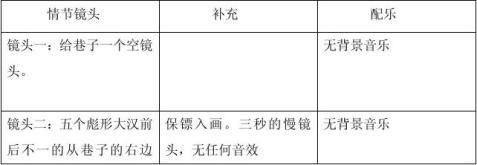
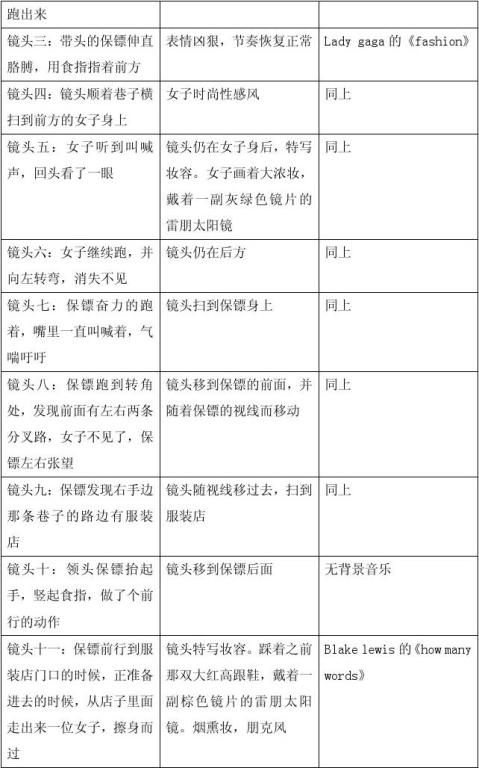
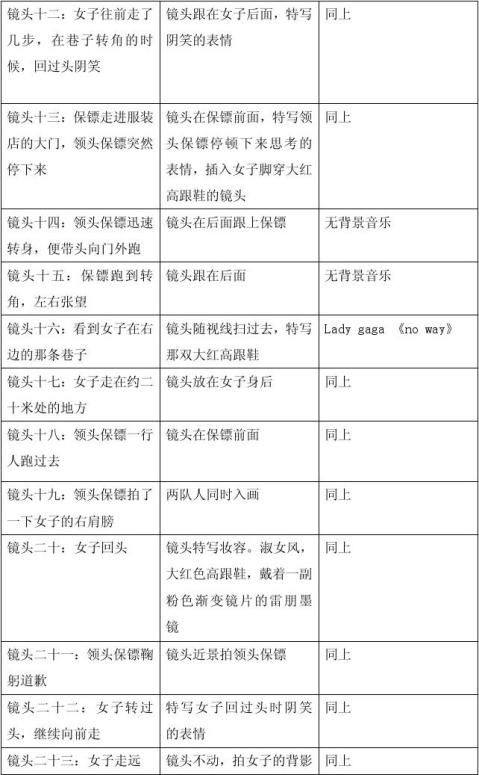

灵感:雷朋Hlip out系列最大的亮点就是可以更换镜片,太阳镜提供3副可替换太阳眼镜镜片套装:包括经典镜片、偏光镜片和渐变色镜片。每款镜片都是不同的风格,以方便随时打造不重复的个性造型。
2:回忆篇:一、人物设定:
两代人不同的雷朋
爷爷:19xx年出生 年龄:72岁
孙子:19xx年出生 年龄:22岁
二、故事创意梗概:
年迈的爷爷在整理旧物时看到一副雷朋的太阳眼镜,于是回忆经历的与雷朋太阳镜相关的几个极富特色的三个时代。当他静静的坐在沙发上沉迷往事的时候,孙子走进来??
三、故事分镜脚本
故事发生时间:现代(20xx年)
地点:爷爷的家中
人物:爷爷和孙子 场景:家中 时长:1~2分钟
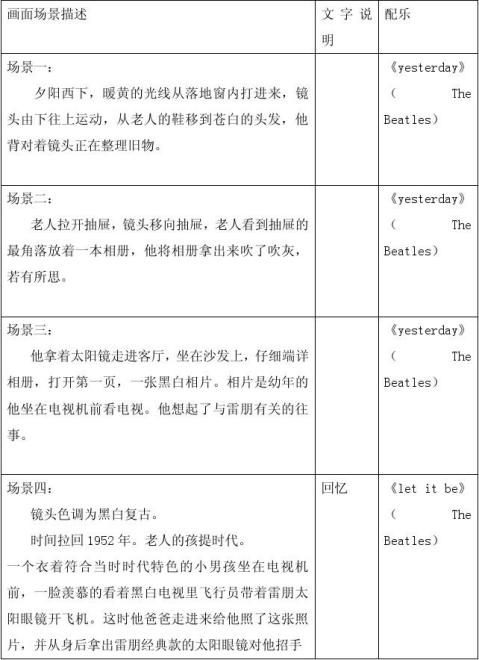
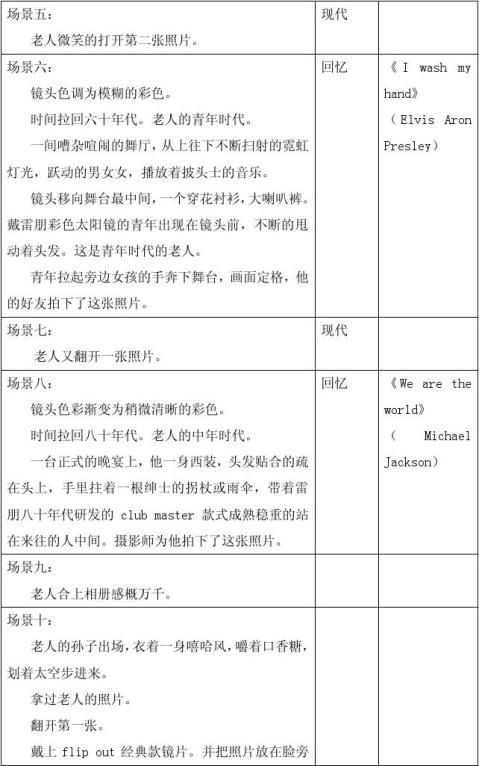

备注:灵感来源
雷朋太阳镜的发展是一个烙有鲜明时代印记的传奇。从20世纪30年代为发行员涉及的第一款太阳镜开始,再至20世纪60年代看革命的十年,再至80年推出适合各种脸型的club master系列。雷朋的每一步发展都有浓郁的时代感。
通过一个生于四十年的老人的一生,也正与雷朋的发展相贴切,可以生动的表现出雷朋发展的历史,在广告末尾的转折,老人的孙子出现,则代表了雷朋的最新血液,孙子不停的换镜片,展现flip out以一敌三的强大性能,不同的镜片对应不同的年代风格。突出产品的诉求点:可换镜片。
背景音乐分别为披头士,猫王和MJ的歌曲,塑造时代感。
第二篇:X-ray Spectrometry
Anal.Chem.2006,78,4069
X-raySpectrometry
ImreSzalo?ki
InstituteofExperimentalPhysics,UniversityofDebrecen,Bemte?r18/a,H-4026Debrecen,HungaryJa?nosOsa?n
HungarianAcademyofSciences,KFKIAtomicEnergyResearchInstitute,P.O.Box.49,H-1525Budapest,HungaryRene?E.VanGrieken*
DepartmentofChemistry,UniversityofAntwerp,B-2610Antwerp,Belgium
ReviewContents
Overview
Detection
InstrumentationandX-rayOpticsQuantificationandFundamentalData
Tomography,Holography,andX-rayScatteringTotalReflectionX-rayFluorescenceAnalysisElectronProbeMicroanalysisParticle-InducedX-rayEmissionX-rayAbsorptionSpectrometryApplications
SamplePreparationED-XRFMicro-XRFTXRFEPMAPIXEXAS
StandardsLiteratureCited
4069407140744078408140834084408640874089408940894xxxxxxxxxxxx91409240934093
OVERVIEW
Inthisreview,wefocusonthemostsignificantandessentialprogressinX-rayspectrometry(XRS),publishedintheperiod2004-2005,coveringthedevelopmentsandimprovementsintheperformanceofdetectionandinstrumentationofX-raytechniquesandX-rayoptics,newquantificationmodelsinX-rayspectraanddataevaluation,calculationandexperimentaldeterminationoffundamentalatomicdata,tomographyandholographymethodsfor2Dor3Dimagingofmicrostructures,electronprobemicro-analysis(EPMA),totalreflectionX-rayfluorescence(TXRF),particle-inducedX-rayemission(PIXE)analysis,andX-rayabsorp-tionspectrometry(XAS).Finally,differentapplicationsineachsubfieldofXRSareshown.Thisreviewinvolvesonlyaselectedminorityofthepublishedpapersandwetrytolookoverthecurrenttrendsinthisanalyticalfieldwithacriticallyselectedcitingofpapers,tosupporttheresearchactivityofthecommunityofX-rayscientists.
Sinceourlastreview,aninternationalgroupofscientistspublishedtwooverviewsonXRS(A1,A2)intheJournalofAnalyticalAtomicSpectrometry,coveringtheperiod2003-2004inthemainfieldofthisanalyticalspectroscopicmethodandinstruments.Thesereviewarticlesinvolvealltheimportant
10.1021/ac060688jCCC:$33.50PublishedonWeb00/00/0000
?2006AmericanChemicalSociety
sectionsofXRSinninechapters:reviews,instrumentation,spectrumanalysis,matrixcorrectionandcalibration,X-rayopticsandmicrofluorescence,synchrotronradiation,TXRF,portableandmobileX-rayfluorescence(XRF),andon-lineXRFandapplications.Inthepresentreview,wefollowanotherwayforclassificationoftheinformationpublishedintheliteratureinthe2004-2005period:detection,instrumentation(exceptofdetectors)andoptics,quantificationmodelsandrelatedfundamentaldata,to-mography,andholographymethodsasthemaintoolofX-rayimaging,TXRF,EPMA,PIXE,XAS,andafinalchapterthatreviewstheapplicationofthesemethodsingeology,environmen-talresearch,industry,biology.andmedicine.Currenttrendsinpixel-typedetectorswerereviewedbyWermes(A3)showingtheirnecessityinX-rayimagingdevices,radiography,autoradiography,proteincrystallography,andX-rayastrophysicsresearch.ThefundamentalaimsofR&Dactivityinthefieldofdetectorsaretoarrangelessmaterialinthedetectorbulk,tobuildhigh-speedreadoutelectronics,andtoconstructlargeradiation-tolerantdetectors.Theauthordescribestheworkingprincipleandstructureofdifferentcategoriesofpixilateddetectors:hybridpixeldetectorswhenthesensormoduleandtheelectronicchipsareconnectedbyshortbumps,diamonddetectorsandtheirapplica-tionsforproteincrystallographyandradiography.Theauthordescribesthedreamofthedetectordeveloper:afullymonolithicpixilateddetectorwhereboththesensorbulkandtheelectroniccircuitsareinoneentityandthesedevicescanbeproducedbycommerciallyavailabletechnology,andheoutlinesthatthiswillnotbepossibleinthefutureduetothelackofpropertechnology.Inthepastdecade,thegreatesthitinXRSwasprobablythecryogenicallycooledquantumdetectorssuchassuperconductivetunneljunction(STJ),transitionedgesensors(TESs),andmicro-calorimeters.TheseprovideexcellentenergyresolutionforawiderangeofX-rayenergies,fromtheopticalrangeuptoseveralkiloelectronvolts.Kurakadopublished(A4)ashortcharacteriza-tionaboutnonequilibriumsuperconductivityandSTJdetectors.Thetutorialpaperintroducesthereaderintothemainfeatures,suchashighcountratecapability,stabilityagainsttemperaturefluctuation,ultra-high-energyresolution,andtheworkingprincipleoftheSTJs.ThemostcommonNb/Al/AlOx/Al/Nbstructurehasexcellentworkingparametersandveryhighstabilityagainsttemperaturevariationfrom50to500mK.A100×100?m2Al
AnalyticalChemistry,Vol.78,No.12,June15,20064069
STJlocatedonaSi3N4membrane,coveredbya1.3-?m-thickPbabsorber,wasdescribed;thisdevicehadanenergyresolutionof12.4eVandthenoisewas4eVat5.9-keVX-rayenergy.Lankoszetal.(A5)reviewedquantitativeX-raymicroanalysisforbiologicalandglassmaterialsamplesinordertoverifythefundamentalparametermethodonthebasisoftheapplicationofstandardsamples.Theprincipalaimoftheirinvestigationwastodeterminetheanalyticalcapabilityofamicrobeam(X-raybeamdiameterof?30?m)XRFspectrometerequippedwithcapillaryoptics.Theyconsideredallthepossiblesourcesofuncertaintyofthewholeanalysis:operatingstabilityofthedetectorandX-raysource,samplemovement,anderrorsoriginatingfromthespectraldeconvolutioncalculations.Thesamplethicknesswasestimatedonthebasisofthemeasurementoftheelasticandinelasticscatteredintensitiesofthesourceradiation,anditwasappliedforthematrixcorrectionaswell.TheauthorsdemonstratetheiranalyticalconsiderationsandcalculationsbysomeexamplesusingthesynchrotronmicrobeamXRFtechniqueforquantitativeanalysisofhumanbraintissuesampleswithbothmonoenergeticandpolychromaticexcitationmodes.Theaccuracyforglassstandardsampleswasfoundbetween4and40%relative.Janulewiczetal.(A6)reviewedthestate-of-the-artofthetabletoptypeX-raylasers(XRLs)anddescribedtheworkingprincipleoftheselasersandtheircharacteristicspectraloutputproperties,fromapracticalpointofview.TheyconcludedthattheXRLsourcesarecompetitiveincomparisonwiththethird-generationsynchrotronradiation(SR)facilities:brillianceofthebeamandtime-resolvedmeasurements.TheauthordetailstheoperatingprocessesoftwotypesofXRFsbasedonthequantumpumpingmechanismsingeneratingtheexcitationstates:(i)recombinationand(ii)collisional-typeXRLs.ThesizeoftheXRLsisthecentralproblemindevelopmentresearch;itcanbedecreasedinthecaseofahybrid-typeXRL,whenthepumpingmediumisgasplasmainacapillarytubeinwhichtheinversepopulationisgeneratedbyashortpicosecondopticallaserbeam,enteringintotheaxialdirectionofthecapillary.MostobservedobjectsintheskynaturallyemitX-rayradiationthattransportsinformationontheatomic-levelprocessesoccurringinthesourceobjects,onthemotionofthebulkmaterial,etc.,orthetransmissionofX-raysthroughabsorptioncanbestudied.Therefore,thedetectorsofX-raytelescopesarethecentraldevicesintheskyobservatories,suchasChandraandXMM-Newton.Porterreviewed(A7)thelow-temperaturedetectorsdevelopedforspacemissionssuchasX-raycamerasanddispersiveX-rayspectrometers.TheAstro-E2launchedin2005wasthefirstmissionthatcontainedalow-temperaturemicrocalorimeter-basedobservatory,andthreemorelow-temperaturedetector-basedobservatoriesarebeingdeveloped(NeXT,Constellation-X,ZEUS).Duetothehigh-levelionizationoftheindividualatomsindifferentskyobjects,verycomplexX-rayemissionspectramustbedetectedresolvingthesatellitelines.Thenewestspectrometersthatsuitthisrequirementarehigh-energyresolutionmicrocalorimeters.TheotheressentialgroupofX-raydetectorsaretheCCDcameras;thesehavemoderatespectralsensitivityandthereforetheyhavetobeusedwithselectiveabsorbingfiltersforenergy-sensitiveX-rayimaging.Inthefutureobservatories,newdetectortypesareneeded,whichhave?1000pixelswithahigh-energyresolutionbelow4eVat6-keVX-rayenergy,inaminiature,monolithicarrayingform,
4070
AnalyticalChemistry,Vol.78,No.12,June15,2006
havingthree-dimensionwiringlayers,cryogenicmultiplexingschemes,complexandflexibleelectronics,andfinallyanaslowaspossiblemass.
SRiswidelyusedforallfieldsofXRSforthecharacterizationofmaterialsforbasicresearchandforpracticalaims.Inviewofthelackofadetaileddescriptionofthisanalyticaltechniqueforthenonsynchrotron-expertforensiccommunity,Kempsonandco-workers(A8)publishedareviewpaperonapplicationofsynchro-tronradiationinforensictraceanalysis.TheauthorspointedoutthebenefitsofSRanddiscussXRFtechniques,describedthetomographicmethod,X-raydiffraction,andscatteringapplications,andfinally,theyhighlightedtheX-rayabsorptionnearedgestructure(XANES)andextendedX-rayabsorptionfine-structure(EXAFS)methodsandtheirsignificantcontributiontothecharacterizationofmaterials.Theyoutlinedtheuniqueadvanta-geousspectroscopiccharactersofthesynchrotronbeams:highbrightness,energytenability,nearly100%ofpolarizationandcoherence,andpossibilityoftime-resolvedmeasurements;finallytheyshowedsomeexamplesdemonstratingthebenefitofap-plicationoftheSRinthispracticalfield.
AgeneraltutorialpaperwaspublishedbyVanderVeenandPfeiffer(A9)aboutthepropertiesofcoherenthardX-raybeamsandtheiruseinstructuralanalysisofsolidmaterials.BecauseofafullycoherentX-raybeamisprovidedbySR,itissuitableforsuchexperimentswheretheinterferenceoftheX-raybeamgivesinformationontheinnerstructureoftheinvestigatedobjectmaterial.Inthenear-forwardscatteringdirection,thedifferencesinthephasesbetweenwavestraversingdifferentpartsoftheobjectenableimagingtheobjectstructureintoaphasecontrast.Inlargerscatteringanglestheinterferenceprovidescoherentdiffractiveimagingwithoutlensesanditiscalledholographywithoutreferencebeam.Theauthorsgiveasimplemathematicaldescriptionoftheinvestigatedeffects:transversecoherence,longitudinalcoherence,phasecontrast,X-rayphotoncorrelationspectroscopy,diffractingimaging,andwaveguideanalysisonthebasisoftheFraunhofferdiffractionpattern.
Inthislastreviewperiod,anincreasingnumberofpaperswerepublishedonthe1Dand2DwaveguidesduetothestrongneedsofamicrosizedX-raybeam,whichhasahighfluxdensity,fortheanalysisofsubmicrometer-sizedobjects.EgorovandEgorovpublishedatutorialonstate-of-artofX-raywaveguides(A10),withthegeneraldescriptionoftheoperatingprinciplesandthespectroscopiccharacteristicpropertiesandpossibleapplications.X-raymicroanalyticalmethodsaremorewidelyappliedinarchaeometryandinculturalheritageconservationresearch,especiallynondestructivemicro-X-rayanalyticalmethods.Selectedpresentationsofthe7thInternationalConferenceonNondestruc-tiveTestingandMicroanalysisfortheDiagnosisandConservationoftheCulturalandEnvironmentalHeritage,dealingwithdifferenttypesofinstrumentalanalysisofmaterialsandartifactsofcultural-historicalvalue,werepublishedinCulturalHeritageConservationandEnvironmentalImpactAssessmentbyNon-DestructiveTestingandMicro-Analysis(A11).Thepublicationgivesasurveyofthepossiblesolutionsforanalyticalproblemsintheculturalheritagesector,usingportableenergy-dispersiveXRFspectrometers,TXRF,microfocusX-raytomography,confocalmicro-XRF,andmicro-XAS.
Thein-fieldanalysisofhazardousmaterialandenviron-mentalsamplesobviouslyrequiresportableXRFspectrometers.MelquiadesandAppolonipublishedareviewarticle(A12)aboutthebasicmethodologyaspectsoflaboratoryandportableX-rayspectrometers.Laboratorymeasurementscanbeslow,sometimeslaborious,andofcoursemoreexpensive;however,theyaremorepreciseincomparisonwithportableXRFspectrometers.Theuseofportablespectrometersallowsrapidmappingandrankingofcontaminatedsites,andalargenumberofsemiquantitativedatacanbegeneratedonsiteinnearlyrealtime.TheauthorsoverviewthepossibledetectortypesthataresuitablefortheportabletechniqueandconcludedthatthePeltiercooleddetectors(Si-PIN,CdZnTe,Sidrift)arethemostappropriatedevicesbecausenocryogeniccoolingisrequired.Themostsignificantapplicationsandportabledesignsweresummarizedinaseparatetableinvolvingthecharacteristicparameters:excitationsource,re-quiredsamplepreparationtechnique,possiblematrixesforsamplebulk,andminimumdetectionlevelsfordifferentelements.Theauthorsgivesomeexamplesforapplicationspublishedintheliterature,andtheydiscussthemainstepsofin-fieldanalysissuchaspreconcentrationtechniquesanddataevaluationmethods.Finally,inthisintroductorysection,wementionanarticleaboutthedirectanalysisofbiologicalsamplesapplyingTXRFanalysis,publishedMarcoandHerna?ndez-Caraballo(A13).Theyclaimthat,forthepurposeofdirectanalysisofbiologicaloriginsamples,themostsuitableXRSmethodisTXRFduetothelimitedmatrixeffectandthemultielementcharacter.TXRFisusedmostlyafterasampledigestionprocedure;however,insomecases,thebiologi-calwetsamplescanbeanalyzedwithoutpreparationduetothelowmatrixinterference.Thistechniquehasadvantageousproper-tiessuchasshorteranalysistime,lowreagentconsumption,andsimplifiedanalysisprocedure.
DETECTION
Cryogenicenergy-dispersive(ED)detectorshaveasuperiorenergyresolutionduetotheverylowoperatingtemperature,thatreducesthethermalnoise,andtotheappearanceoflowexcitationstatesofelectronenergies.TheworkingprincipleisbasedonthefactthatoneabsorbedX-rayphoton(theenergyis?1keV)generatesan?100timeshighernumberofchargecarriersinthesuperconductive-typedetectorsthaninconventionalSisensors.Thiseffectleadstotheexcellent2-4-eVenergyresolutionintheX-rayenergyrangeofseveralkiloelectronvolts,whilethebestenergyresolutionoftheconventionalSi(Li)detectorsis?120eVat5.9-keVenergy.Themicrocalorimetersareprincipallyverysensitivesolid-statethermometerschangingtheirtemperaturethroughtheabsorptionofX-rayenergyquanta.TheconstructionoftheSTJsisbasedontwosuperconductiveelectrodesseparatedbyatunnelingbarrier.ThetunnelingcurrentbetweentheelectrodesdependsontheabsorbedX-rayenergyinthebarrierlayer,andthischangingofcurrentcanbeappliedasasignalofdetectedX-rayquanta.Metallicmagneticcalorimeters(MMC)forhigh-resolutionXRSweredevelopedbyFleischmannandco-workers(B1);theyshowanfwhmof3.4eVforX-rayenergiesupto6.5keV.Thistypeofdetectorisbasedonaparamagneticsensorplacedinamagneticfieldandincontactwithametallicabsorber.Themagnetizationofthesensorindicatesthetemperatureoftheabsorbercalorimeter.Thespectroscopiccapabilityofthiscryo-genicMMCdetectorwasdemonstratedby55FespectrawithseparationoftheMn-KR1andMn-KR2peaks.AGermanphysicsresearchgroup(B2)developedaprototypeofanewconstructionofanSTJdetectorhavingtwothinelectrodelayersseparatedbyathintunnelbarrier,andonthislayeraleadabsorberislayered.DuetothehighabsorptionpropertiesofthePblayer,thequantumefficiencyoftheSTJdetectorincreasedconsiderablyfrom1%upto50%ofX-rayenergyof6keV.Thisstructurehelpsreducethedoublingofthepeaks.Theachievedenergyresolutionofthedetectorwas10.8eVatanenergyof5.9keV,ataworkingtemperatureof70mK.Theauthorsaregoingtoinstallthistypeofdetectorintoanewhigh-resolutioncryogenicspectrometerusedinanelectronmicroscope.Themicrocalorimetersofferthemostimpressiveenergyresolution,2-3eV,intheenergyrangeof2-6keV(B3).However,theirdetectablecountrateislow,?500counts/s.IncontrastwiththeseoperatingpropertiestheSTJshavealittlebitlessresolutioncapability,whichis?3-12eVintheenergyrangeof2-6keV,buttheirmaximumcountrateshouldbe10timeshigherthaninthecaseofthemicrocalorimeters.TheauthorsdevelopedanewSTJwithstructureofNb-Al-AlOx-Al-Nbforhighcountratedetectionofsynchrotronradiation.Theyproducedanimpressivecountrateat10000counts/swithanenergyresolutionbetween7and15eVfwmh.Theirdevicewasabletodetect100000counts/saswell,butthentheenergyresolutiondeterioratedto43eV.
ThefirstindustriallyappliedspectrometerwasreviewedbyHollerithetal.(B4),whousedanIr/AuTESinascanningelectronmicroscopy(SEM).Thesuperconductorlayerofthedetectoris400×400mm2witha250×250mm2Auabsorberwithathicknessof500nm.Duetothe500timessmallerdetectorareaofthisTEScomparedtotheconventionalSi(Li)detectors,thesolidanglehastobedecreasedbymountingapolycapillarylensinfrontoftheIr/Ausensor.UsingthisX-rayoptics,thedetectablecountratewasimprovedbyafactorof5attheSi-KRenergy.ThreeAmericanauthors(B5)outlinedthegeneralandspecificpropertiesofthemicrocalorimetersandtheirapplicabilitytoSEManalysis.Theycalledtheattentiontothefollowingfacts:(i)thespectralresolutionofthemicrocalorimetersisbetterthanthebestalternativedetectiontechnologyinwavelength-dispersivespec-trometry(WDS),(ii)thisenergy-dispersivepropertyissignifi-cantlybetterthanwhatSi(Li)technologycanprovide,(iii)thedetectionefficiencyisbetweenSi(Li)andWDSmodes,(iv)thedisadvantageousdetectioncharactersofthiscryogenicdetectorarethelimitedcountrateandthelimitedgeometricalefficiencycapabilitiescomparedtoWDSandSi(Li)detection.ThesenonidealworkingcharacteristicscanbeavoidedbythedevelopmentofappropriatemicrocalorimeterarraydetectorsystemthatshouldbetheidealdetectorforEPMAoflowatomicnumberelements.Bechsteinandco-workers(B6)characterizedacryogenicsuper-conductivetunneljunctiondetectorsetthatconsistsofNb/Al/AlOx/Al/Nblayerssegmentedinfourindividualstructureshavinganareabetween70×70?m2and200×200?m2.TheaimoftheirinvestigationwastoclarifythedependenceofthedetectionefficiencyandtheenergyresolutionpropertiesontheimpingingX-rayenergy(upto1500eV)andthecountrateanditsinfluenceonthedetectorresponsefunction.TheX-raymicrobeamhada5-?mdiameter,andthissizeallowedscanningthebeamverticallyandirradiatingdifferentpartsofthedetectorsurface.Theauthors
AnalyticalChemistry,Vol.78,No.12,June15,2006
4071
foundanunexpecteddegradationoftheenergyresolutioninawideedgezone.ThelaterallyresolvedmeasurementsprovideabetterunderstandingofthephysicalprocessesinSTJsandpromotedesignofanimproveddetectorlayout.AJapaneseresearchgroup(B7)developedanewdesignforasetofSTJdetectors,capableofprovidingmultispectraofX-raysforpurposesofX-raycomputertomographyintheenergyrangebelow1keV.ThetypicalsizeofeachindividualSTJonthemultipixelchipis?100×100?m2.Anenergyresolutionof41eVfwhmwasobservedat5.9-keVenergy,andthatvalueisthreetimesbetterthanthetheoreticallimitofconventionalSidetectors.TheauthorscarriedoutexperimentswiththeirSTJchipinthe5-25-keVenergyrangeandconcludedthatthistypeofcryogenicdetectorisapromisingcandidatefor3-DX-rayabsorptionandfluorescenceCTimaging.Bruijnetal.reported(B8)anewdevelopmentofacryogenic5×5matrix-shapedarrayofmicrocalorimetersusingTi/AuTESwithCu/BiabsorberandSi3N4coolingconnector.Thearraywastestedwithirradiationof5.9-keVmonoenergeticX-ray,andtheresponsespectrahada6-7eVfwhm.AnItalianresearchgroupreviewed(B9)asimilarexperimentwithTESthatconsistsofa300×400?m2thinand25-?m-thickpolycrystallineSnfoilactingasanenergyabsorber.TheTESsurfacewasprotectedagainstpossiblechemicaldamagingduringthephotolithographicprocedure.TheTESmicrocalorimeterwastestedatradiationbeamlineGILDAoftheEuropeanSynchrotronRadiationFacility(ESRF),detectingX-rayfluorescencespectraemittedbyaRenais-sancegoldlusteronceramic;duringthisanalysis,theenergyresolutionoftheTESwasfoundtobe70eVbetween6-and9-keVX-rayenergy.Onthebasisoftheirexperimentalresults,theauthorsconcludedthattheTEScalorimetersareveryapplicableforthesynchrotronbasedX-rayfluorescenceanalysis.AspecialmonolithicX-raydetectorbasedontheconnectionofanSDDandaCsI(Tl)scintillationdevicewasreviewedbyMarisaldietal.(B10).Inthiscoupleddetector,theSDDworkedasadirectX-raysensorforphotonsthatinteractedintheSibodyoftheSDDandinparallelasaphotodetectorforphotonsgeneratedinthescintillationcrystal.Thesourceoftheelectronicsignalisdis-criminatedonthebasisofthepulseshapeevaluationandthatprocessyieldsthecorrectdeterminationofthedepositedphotonenergyinthecomplexdetectorforbothX-rayandγ-rayenergyranges.Theauthorssystematicallytestedthedependenceofthedetectorefficiencyontheoperatingtemperatureandfoundthat,at10°C,theenergyefficiencyisnearly100%forthe8-200keVofenergyrange.TheyconcludedthatthistypeofcombineddetectorwouldbeofgreatinterestinX-andγ-raydetectioninastrophysicsduetotheadvantageousspectroscopiccapabilities,i.e.,thehighdetectionefficiencyfromlow-energyX-raysuptoseveralhundredkiloelectronvolts.Goulonetal.published(B11)thespectroscopicpropertiesoftheiradvanceddetectorsystems,especiallySDDarrays,usedforXRFspectrometryattheID12beamlineinESRFinGrenobleinthelast15years.Animprovedenergyresolutionwasachievedduringthisperiod:82eVatSi-KRand126eVatFe-KR,bymeansofmathematicalspectraldeconvolution.Now,theSDDhasbecomeacommercialdetectorinvaryingsizesandshapes,inlargearrayform,including200-400detectionchannelsfordifferentapplicationsofconventionalandspecificX-rayemissionanalysissuchasXRFtomographyandholographyorEXAFSanalysis.TheydiscussedtheuseofSDD
4072
AnalyticalChemistry,Vol.78,No.12,June15,2006
asEDdetectors,themodesofminimizationoftheelectronicreadoutnoise,andthefirstresultofa35-elementSDDarrayconsistingof7×7individualcylindricalSDDs.AspecialannularSDD,developedforPIXEanalysis,wastestedandreviewed(B12).PIXEalwayssuffersfromthesmallsolidangleofdetection;therefore,thisnewPeltier-cooledSDDwasdesignedwithannularshapeinordertomaximizethedetectionangle.Theareaofthedetectoris60mm2,andtheworkingdistanceisonly1mm.ThiscommercialEDdetectorisabletocollectathighrateof1Mcounts/swithanenergyresolutionbetterthan200eVat6.4-keVX-rayenergy.IncomparisonwithconventionalSi(Li)detec-tors,thesolidangleandthecountratecapabilityarebothlargerby2ordersofmagnitude.AnovelSDDwithintegratedFETwaspublishedbyLechnerandco-workers(B13);ithasanewchiplayoutthatallowsconstructingthereadoutanodeinasmallersizethanearlierdesigned,whichreducedtheanodecapacitanceof120fFinsteadof200-250fFinthecaseofcommercialSDDs.Thisimproveddetectorstructureandpropertiesyieldedabetterenergyresolution:147eVat5.9-keVX-rayenergyat-10°Cdetectortemperature.Onthebasisoftheseresults,theauthorsproposedanewSDDdevicewithincreasedeffectiveareainordertoachievehighergeometricalefficiency.Eggertandcolleagues(B14)alsostudiedtheimprovementpossibilitiesofSDDswithenlargedactivedetectorsurfacearea,from5to10mm2;thatrequiredmoreintensivecoolingfrom-15°Cdownto-20°C,reducingtheleakagecurrentthatcausesdegradationoftheenergyresolution.Onthebasisoftheirexperimentalresults,theyconcludedthatinsteadofenlargementoftheactiveareaoftheSDDdetectoragroupofsegmenteddetectorswithasmall(5mm2)sensitivesurfaceismorereasonabletoapply.Ontheotherhand,incaseswhenalowcountrateisavailable,alargesensitiveareaismorereasonable.TheresearchgroupofSokolovreviewedtheirresults(B15)ofsystematicstudyaboutSi(Li),SiPIN,andCdZnTeX-raydetectors,cooledbyPeltiereffectdevicesinordertodevelopaportableEDX-rayspectrometer.TheyfoundthatthespectroscopiccharactersofthePeltier-cooledSi(Li)detectorwassimilartothoseofdetectorcooledwithliquidnitrogen,anditwasselectedasthemostsuitabletypeofdetectorforXRFanalysis.Theyshowedinthisarticleillustrativespectrafromthestudiedsemiconductordetectorsusing55Feand241Amradioactivesources.Streliandco-workers(B16)publishedtheirexperimentalcomparisonofSi(Li)detectorsandSDDequippedbothwithathinpolymerwindowinordertodetectlowX-rayenergiesfrom200eV.WiththeSi(Li),itwaspossibletodetectdowntotheCKRandthelimitforSDDwasO.Thedetectionlimitforthislatterelementwasfoundtobe36nginthecaseofSDDand4ngforaSi(Li)detector,whichshowsthebetterapplicabilityoftheSi(Li)detectorforXRFanalysisoflow-Zelements.TheirresultssuggestthattheSDDsshouldbeapromisingcandidateasafuturedetectiondeviceforlowatomicX-rayradiationespeciallyatthecaseofahighX-rayflux.InrefB17,Wrightetal.emphasizedthatthereisastrongdemandformoreefficient,moreradiation-tolerantsensorsinX-andγ-rayphysics,SRapplicationsandmedicalimaging.Forthesedetectiontasks,anexcellentsolutionisofferedbythe3-Ddetectorarchitectureinwhichtheelectrodestraversethedetectorbulk,neglectingthelimitationofthedistancebetweenelectrodesbythethicknessofthewafer.This3-Dstructureallowsfasterchargecollectionandaverylowdepletion
voltageof1-20kV;ontheotherhand,theplanarpixeldetectorsneed?80V.Theauthorsperformedasimulationmodelcalcula-tionforthechargecollectioninthesetwotypesofdetectorsandfoundthatthecurrentpulsewasproducedin?5ns,andincaseofapixilatedplanardetector,thisvaluewasfoundtobe?80ns.The3-DMedipix1sensorwascreatedonhigh-resistivityn-typeSibulk,theelectrodeswereformedbyphotochemicaletching,andthep-typeelectrodeswereetchedanddopedwithBbydiffusion.Finally,theelectrodeporesweremetallizedwithaTilayerandAuandAl.
TheenergyresolutionofthegaseousEDdetectorsismoreandmorecomparabletothatofthesemiconductordetectors;inaddition,thestructureofthislow-costdetectorisnotcomplexandconstructingitismucheasierthanforhigh-purityGeorSi(Li)detectors.BeyondthattheycanhavelargeareawindowfortheenteringX-raysandtheyhavelesssophisticatedoperatingrequirementsthansolid-statedetectors,upto25-keVX-rayenergy.APortugueseresearchgroup(B18)improvedtheirxenon-filledgasproportional-scintillationcounter,applyingapolyimidewindowwith6-mmdiameterwith?30%transmissionat250eVforsoftX-rayenergiesbelow3keV.Thepressurewassetas800Torr,andthegaswascontinuouslypurifiedbyconvection,usingnonevaporablegettersallowingthesameoperatinggasduringseveralmonths.Thegaseousdetectorisalsooneofthemostsuitabledevicesfortwo-dimensionalX-rayimagingbecausethistypeofdetectorcanbeconstructedwithalargesensitivearea.AEuropeanresearchgroupatELETTRA(B19)reviewedatwo-dimensionalX-rayimagingdetectorbasedonasingle-photoncounterthathasagaselectronmultiplier(GEM)innerstructure.TheGEMdetectorwasappliedfordetectingX-rayshavingenergyof8keV,anditwascapableoftime-resolvingspectraldatadowntomillisecondtime.Thesensitiveareaofthedetectorwas56×56mm,dividedintosevenxycells;thevoltageofthedriftcathodewassetat4000V.Onthebasisoftheelectronicsignals,eachcellsoftheGEMcanbesubdividedintovirtualpixels(ViP)havingasensitivespatialresolutionof?100?m(fwhm).Thisdetectionpropertydependssignificantlyonthespeedoftheappliedelectronicsandthegasgain,whichwas?104.TheauthorsconcludedonthebasisoftheirexperiencethattheViPdetectoroffersahighquantumefficiencyupto25-keVX-rayenergyusing2×105PapressureofXemixturegas,andthetimeresolution,whichdeterminesthespecialresolution,canbeimproveddowntoafewhundrednanoseconds.Aspecialapplicationoflarge-areagaseousdetectorwasshownbytheresearchgroupofDespre?s(B20)byconstructionofanewradiographicscanningsystem.Thedetectorwasbuiltbytwoorthogonallyorientedgasmicrostripdetectorsusedforscanningahumanbodywithaspeedof15cm/s.Bothdetectorsconsistedof1764channels,andtheindividualpixelsizesintheobtainedX-rayimagewere0.254×0.254mm2.Duetothefavorabledetectionproperties,suchasshortsignalevaluationandlargesensitivearea,thisnewlyconstructeddeviceisafuturecandidateforlow-doseradiography,sincetheentrancedoserateattheirradiatedhumanskinswas0.1mSvwhileatthecaseofconventionalX-rayfilmsthisvalueiscloseto1.45mSv.
AreviewarticlewaspublishedbyShekhtman(B21)describingthenewestdesignofmicropatterndetectorsandgap-resistiveplatechambersandthegeneraloperatingeffectsandprocesses,thedesignstructure,andtheirinfluenceonthepropertiesofthegaseousdetectors.Theefficiencythroughtheabsorptionstronglycorrelatedwiththeatomicnumberofthegasmaterial(Ar,Kr,Xe)anditspressure.Thearticleoverviewedthemostimportantapplicationareasofthegaseousdetectors:(i)wirechambersformedicalradiographyapplicationsandforSR,and(ii)micropatterngasdetectorsandgaselectronmultiplier-baseddetectorsforhighcountratesynchrotronexperiments.
Newbury(B22)testedandappliedasiliconmulticathodedriftdetectorforX-rayspectrometryonaSEMinvestigatingspectros-copyparameterssuchastheoutputcountrate,energyresolution,andpeakstabilityintheEDspectra.HedemonstratedthecapabilityofthismultichannelSDDforrecordinganX-rayspectrumimageofanAl-Nialloycontaining4wt%Feaswellina128×128pixelsizewith220-kHzoutputrate.TheX-rayspectrumimagewasgeneratedbyfixingtheexcitationelectronbeam,andtheSDDarraywasreadout,andinthiswaytheoverallmappingtimewasfoundtobe185swhile100Mbinformationwasproduced.ComparingwithaSi(Li)detectorhavinga50mm2area,hefoundthatthearraySDDhasabetterresolution,namely,134eVfwhmat6.4keV(theresolutionofSi(Li)was140-145eV),andtheSDDcanachieveashorterpeakingtimeforagivenresolution.
Themainadvantagesofthesilicondriftdetectors(SDD)arethehighcountratecapability,thepossibilityofalargeeffectivedetectionarea,andtherelativelyhighworkingtemperature(-10°Ctoroomtemperature).Themainideaisthatthesignalchargesgeneratedinthebulkcrystalaretransportedtotheelectrodesinacontrolledway,mainlyparalleltothelargesurfaceofthedetector.GattiandRehak(B23)reviewedtheprincipalpropertiesoftheSDD,discusseddifferentapplicationsinchargedparticlephysicsandXRS,andgaveashortdescriptionabouttheirphysicalstructureandthephysicalprocessesinthedetectorbulk,e.g.,for55Fespectrarecordedwitharing-shapedSDDat-10°C,inwhichspectrathetwoMnlineswereclearlyresolved.
TheworkingcapabilitiesoftwostandardSiPINandconven-tionalSi(Li)detectorswerestudiedbyKumpandco-workers(B24)using55Feand109Cdannularradioactivesourcesandthesamemeasuringgeometricalconfigurationsetup.The0.3-mm-thickPINdiodehada7-mm2activearea,andtheenergyresolutionatcountrates?1000counts/swasfoundtobe195eV,whiletheparametersfortheSi(Li)detectorwere30mm2,andfwhmof175eV(andthisvalueisworsethantheaverageenergyresolutionofcommercialSi(Li)detectors).TheauthorscomparedtheanalyticalcapabilitiesofthesedetectorsbyquantitativeanalysisofSRM2710soilstandardsample,asimilardependenceofsensitivitiesversusatomicnumberwasfounduptoZ)30,andoverthisvalue,muchlesssensitivitywasobtainedwiththePINdiodeduetothelowerdetectionefficiency.
AnewsetoflargeareaHPGedetectorwasreviewedinrefB25forthepurposeofPIXEanalysis.Thedetectorsetisbuiltinannularformofeightindividualdetectors,andeachitemhada100-mm2effectivearea;thisprovideshighquantumefficiency.Thedetectorchambersaremountedvertically,andeachsubdetectoractsasanindividualdetector;however,theyuseacommonmainamplifier.Thefwhmofthesetofdetectorswasfoundtobebetween144and168.Theauthorsoutlinedtheuniquespectro-scopicpropertiesofthisset,whichcanbeusedfordetectionof
AnalyticalChemistry,Vol.78,No.12,June15,2006
4073
verylowX-rayfluxes,andthesubdetectorscanseparatelybetunedwiththeuseofsuitableabsorptionfilterinfrontofthemfordifferentX-rayenergies.
Zhangandco-workersreviewed(B26)thedevelopmentandatestofanewCdZnTe(CZT)pixilated3-dposition-sensitivedetectorforawideenergyrangeofX-andγ-rays,coupledtoathird-generationASIC-VAS3.1/TAT3readoutsystem.Thedetectorbulkisa1.5×1.5×1cm3CdZnTecrystalmountedonaceramicsubstratewith11×11pixellatedanodesbondedtothereadoutelectronics.Theyachieveda1.27×1.27×0.2mm3geometricalpositionresolutionofsinglepixeleventsandabetterthan1%fwhmenergyresolutionfortheγlineof137Cs(662keV)atroomtemperature,usinganuncollimatedsource.
TheresearchgroupofFant(B27)reviewedanewlarge-areadetectorwitha500-?m-thickpixellatedvertical-SSDboundtosevenreadoutintegratedcircuits.Thewholemodulehas448×64pixels;eachitemhasa150×150?m2uniformpixelsizewithoutdeadregion,andtheelectronicreadoutprocedurewascontrolledbyaLabView-basedroutine.TheauthorstestedtheirnewdetectorwithacollimatedX-raybeamemittedbyacoppertargetand35-keVand10-mAanodecurrentanddemonstratedwithsomepicturestheimagingcapabilityoftheareadetector.Theexcellentphysicalandchemicalstabilityandhighthermalconductivitymotivatedtheintenseresearch(B28)ofsiliconcarbideasacandidateforasemiconductorX-raydetector.TheauthorsdemonstratedthedetectioncapabilityoftheSiCX-raysensorinawidetemperaturerangeupto100°C.ThisvalueisnowunachievablebyanyothersemiconductordetectorcurrentlyavailableinthepraxisofXRS.Theextremeworkingpropertiesarebecausethismaterialhaswidegapenergy(2.2-2.3eV).Theenergyresolutionbetween60-and70-keVenergyat27°Ctemperaturewasfoundtobe366eV,at95°C.Thetime-resolvedX-rayexperimentssuchastime-dependentX-rayscatteringandimagingmeasurementsrequirehighcountratecapacitydetectorswithlargeareaandexcellenttimeresolution,betweenafewmillisecondsandafewseconds.
TheauthorsofrefB29describeanewhigh-throughputX-raydetectorsystemforX-rayphotoncorrelationspectroscopyandsmall-angleX-rayscatteringusingamodifiedversionofacom-mercialCCDcameradesignedoriginallyforopticalpurposes.Inthisnewsetup,theX-rayswereabsorbeddirectlyintheSibulkofaCCD.BecausetheintegratedintensityofasingleX-rayabsorptioneventspreadsoverthreeorfourpixelsanditwasfoundtobesignificantlyabovethenoiselevelofsingle-photonevents,itwaspossibletoidentifytheevent’scoordinatesbythedetectorpixels.TheconventionalCCDsarenotoptimalforXRS;however,theauthorspointedoutthattheso-called“deep-depletion”typeCCDsshouldhaveasufficientlythickdepletionlayerwheretheX-raysmostlyabsorbanddeposittheirenergies.Forexample,acamerawithadepletionlayerthatis40?mthickhasaquantumefficiencyof67%ata6.3-keVX-rayenergy;thisallowsonetousethiscameraforlow-energyXRS.Theultimategoalofthedevelopmentofcompoundsemiconductordetectors,GaAs,CdTe,CdZnTe,orHgI2,wastocreateX-raysensorsthatcannotonlyoperateatcryogenictemperature(likeGedetectors)butalsohaveahigherabsorption,achievingamorereasonabledetectionefficiency(likeSi-baseddetectors).
4074
AnalyticalChemistry,Vol.78,No.12,June15,2006
Finally,inthissection,wereviewnewGaAsandSiCpixilateddetectorspublishedbyBertuccio(B30).TheseuniquedetectorsprovideacomparableleakagecurrentthatislessorinsomecasesbetterthatSi-basedEDdetectordevices,whichproduce1nA/cm2forGaAsand1pA/cm2forSiCand240-310eVfwhmatroomtemperature.Theauthoroverviewsthephysicalworkingprinciplesofthesedetectorsandoutlinestheelectronicpossibili-tiesfordecreasingthespectraldegradationeffects,e.g.,physicaloriginandlimitationoftheleakingcurrent.
INSTRUMENTATIONANDX-RAYOPTICS
TheultimategoalsoffocusingX-raybeamsaretoproducethehighestpossiblefluxinthefocalpointandproducemagnifiedX-rayimages.Thestate-of-the-artfocusedspotsofX-raysareoftheorderof50nm,providedbybeam-compressingcapillaries;transmissionrefractivelensesachieved210nmandthebestvalueswerereachedbyFresnel-zoneplates.Jarketal.proposed(C1)averysimpleandoptimizedformofcompoundrefractivelenses(CRL)forfocusingX-raysbyreducingtheopticallypassivematerial.Asinglelenswascomposedoftwolargeprismsofmillimetersizetouchingeachother,andeachindividuallargeprismcontainedahighlyregularinnerstructureofsmalleridenticalprismlikesegments.ThefocusingdeviceallowedusingalargeraperturecomparingtoothermicrofocusingX-rayopticalelementsinthemillimeterrange,andthesmallestimagesizewas2.8?mwhilethephotonfluxenhancementwas?25.Themosteffectivematerialsforrefractivelensesaresuchmaterialsthathaveanaslowaspossibleatomicnumber;low-Zelementshavealowabsorptionandhighrefractionindex.ThefirstlenseswerefabricatedfromAlandlaterfromBeandLi;thesedevicesrequiredspecialtreatmentbecauseoftheirtoxicityanddangerouschemicalproperties.Toavoidthisfundamentalproblem,theresearchgroupofArtemiev(C2)proposedanddevelopedanewdesignofaplanarcompoundrefractivelensmadefromglassycarbon;thatlensfocusesinonedirectionanditscurvatureradiusisbetween5and200?m.Thelenshassomeadvantageousproperties,e.g.:(i)thelensmaterialcanbefabricatedbylaserbeamtechnology,(ii)ithasexcellentthermalandradiationstability.Thesmallestfocalspotwasof1.4-?msizeat25-keVX-rayenergy,whilethemeasuredgainwas?3.Thefirstpossibleapplicationofthisnewlydevelopedcompoundlenswillbemicro-XRFandmicro-EXAFSexperiments.Themosteffectivefocusingdevicesforhigh-energyX-ray(25-100keV)arethecompoundrefractivelensesduetotheirlowerabsorptioncoefficientandhighrefractiveindexcomparedtothelowerenergyrange.Shastrydescribes(C3)acombinedX-rayopticalsetupconsistingofanAlCRL,tunablein-linemonochro-matoroftwoverticaldiffractingbentLauecrystalsinsertedtangentiallyonaRowlandcircles,aSi(111)high-resolutionmonochromator.Theauthorshowedafewexampleswithdifferentcombinationsoftheseopticalelementsanddiscussedtheirexperimentalproperties:thebestfocalspotsizewas?67?minlinefocusandthetransmittancewasbetween50and60%at67-and81-keVX-rayenergies.Forthelow-energyX-rayrange(<10keV),Pereiraetal.(C4)fabricatedaLiCRLhaving90%transmis-sionat10.87-keVX-rayenergy,whilethegainwasupto40andthegeometricalfwhmofthefocalblurredwas?20?mat2.13-mfocaldistance.Theprototypelenshas80individuallenssetswithtwoparabolicsurfacesof0.253-mmnominalradius,andits
transmissionefficiencywasfoundbetween49and90%.AsoftX-raymicroscopewithexcellentlyhighspatialresolution(betterthan15nm)wasconstructedrecentlybyChaoetal.(C5)attheAdvancedLightSource,basedontwoFresnel-zoneplates.Theimprovementofspatialresolutionofthefabricationzoneplatesisfundamentallylimitedduetotheelectronnanofabricationrestriction,namely,theelectronbeambroadening.Theelectronbeamthatformsthenanopatternsofthezoneplatescattersintherecordingmedium,andthisprocessleadstoalossofimagecontrast.Thenovelideaoftheauthorswasthattheysubdividedthezoneplatepatternintotwoindividualcomplementarypatterns,whichhadlessdensepatterns,andtheyweremanufacturedseparately.ThecombinedzoneplateusedintheirX-raymicro-scopewassetbyoverlayingbothzoneplateswithhighaccuracy,andinsuchawayhigher,apatterndensitywasachievable,severaltimesbetterthanitwouldbeusingasinglezoneplate.Themicroscopewasassembledbythesepreciselyfittedzoneplates,apinholesystem,andaCCDcameratotransmittheX-rayimagetovisible.Theauthorspredictapromisingfutureforthisplatefabricationtechnique,especiallyinlifescience,tolocalizequan-titativelyproteinsina3Dimageofacell,permittingthestudyofgenes.Recently,theFresnelzoneplatesandwaveguidesareonthetopinthehigh-resolutionX-rayopticalelements.Michetteandco-workers(C6)reportedanewpossibilityforthestructureofmodifiedreflectionzoneplatesandBragg-Fresnellens,whichpassbelowthe10-nmresolutionlimitoftransmissionzoneplates(TZPs).Theauthorsshowedthatinthecaseofcoaxialellipticalreflectionstructures,thedifferentdiffractionorderswillfocusintothesamefocalpoint;inthecaseofaAuFresnelstructureplacedonaSicrystal,theresolutionlimitatthefirstdiffractionorderis?6nm.Theauthorsemphasizedthatthisnewpotentiallysub-nanometerresolutionfocusingelementcanbeutilizedatthefree-electronlaserandtheycannotsubstitutethe“conventional”TZPsbecauseoftheiropticalaberrations.TheFresnelzoneplatesconsistmainlyofaconcentricallypositionedperiodicalalternationoftransparentandabsorbingpartstoformtheX-rayimage.Thebasicpracticalproblemofthisopticalelementisthatthebackgroundleveliscomparabletothesignallevelresultingsometimesin10%error.TamariandAzechipublishedanewsolution(C7)forneglectingthisundesirableeffectbydesigningaFZPwithvariablethicknessandwidthoftransparentandabsorberzonesandoptimizedtheseparametersforachievingabettersignal-to-backgroundratio,fourtimesbetterthanforconventionaltwolayersFZP.ForfocusingX-raysinthehard-energyrange(5-120keV),theCRLsarethemostsuitableopticalelementsduetotheircompactandrobustconstructionandmechanicallysimplealignment.ThesetypesofX-raydevicesoperateasconventionalglasslensesintheopticalrangeoftheelectromagneticwaves;theprincipledifferenceisthattherefrac-tionindexforX-raysislessthan1withaverysmallquantity;therefore,theCRLsmustconsistofseriesofindividualunitsinordertoproducetheexpectedfocusingeffect.TheresearchgroupofLengererinAachen(C8)reviewedanoveltypeofCRLsmadefromB,Be,Al,andSi,witharotationalparabolicprofile,forfocusingintwodimensionsandtoavoidthesphericalaberrationthatisacharacteristicpropertyoftheothertypesofCRLswithsphericalprofile.AsamaterialoftheCRLs,thelow-Zelementsareidealduetothelowabsorptionproperties,andtheymustresistthehighheatloadinthelensmaterialinducedbythehighX-rayflux.TheauthortestedacooledBeCRLwith100-Wmm-2heatloadinESRFattheID-10beamline,andthehighesttemperaturewas65°Cduringcontinuousoperation.ThatvalueisoptimalforBebecauseitsmeltingpointis1285°Candtherecrystallizationoccursover600°C.TheauthorsreviewedtheexperimentalresultsofananofocusingBelensthatwasassembledfromtwoplanarCRLs;eachfocusesintoonedimension,andthebestfocalspotwasachievedas115×160nm2at47-mfocaldistancefromtheundulatorX-raysource(theenergywas15.2keV)atID-13intheESRF.TheauthorspredictthattheparabolicCRLswillbethekeyopticaldevicesforscanningmicroscopyandmicroanalysis,diffraction,fluorescenceanalysis,absorptionmeasurements,andXRFtomographyexperimentswithhighX-rayenergyandhighspatialresolution.ThemaintechnicalprobleminmanufacturingofCRLsistoarrangetheuniformshapeoftheindividuallensandpreciselyassemblethemintoonelensset;however,theseproblemscanbeavoidedwithabubble-typeCRL.Thisisbasicallyaseriesofairbubblesembeddedinepoxy(thatisinvolvedinaglasscapillary)formingsphericalindividuallenses.Piestrupetal.published(C9)onexperimentswiththistypeofCRLforimagingofbiologicalobjectsandfound?20-?mresolutionusingaconventionalCuanodeX-raytubeandapplying600-Wpower;thatvalueisfarfromthebestresolutionachievedatsynchrotronfacilitieswithparabolicCRLsbutitequalsthebestofthemicrotomographydevicescurrentlyonthemarket.AnewlydesignedrefractiveFresnel-likeX-raylenswaspublishedinrefC10,constructedbyatriangulararrayofprismswhoseopticalelementoperateswiththephaseshiftoftheX-rays.EachidenticalprismisshiftedofftheopticalaxisofthelensandthatstructureallowsfocusingthetransmittedX-rays.Theone-dimensionfocus-ingdevicewasfabricatedwithdeepreactiveionetchingofSi;itwastestedatasynchrotronbeamline,anditprovidedafocallinewidthof1.4?mat13.4-keVX-rayenergy.TheauthorsoutlinedtheadvantageousopticalpropertiesofthistypeofX-raylens.Ifthedisplacementoftheprismcolumnsissufficientlysmallcomparedtotheprismheight,aparaboliccorrectionisnotnecessary;theyexpectthisdesignasthefuturelensforhardX-rays.OneofthemostspectacularandpromisingX-rayopticaldevices,whichcanprovidenarrowandsmall-diameterX-raybeamsdowntolessthan10nm,arethe1Dor2DX-raywaveguides.Thethin-filmslabwaveguidescanconfinetheprefocusedincidentX-raybeamandguideit,andattheoutputside,thediameteroftheX-raybeamcanbereducedto10nm.ThistypeofX-raymicroopticalelementisoneofthemostpromisingdevicesforX-raymicroscopesatthethird-generationsynchrotronbeamlinesandforfreeelectronlasers.WarnerandFonzopublished(C11)theoreticalcalculationofthetransmissionpropertiesof1Dand2Dwaveguidesandtutoredthereaderthroughasimplerepresentationoftheircalculationmodel,givingasimplecomparisonwithotherX-rayopticaldevices.Onthebasisofcalculations,theypredictedthatthetransmissionefficiencyoftheone-dimensionalwaveguidesis?50%fortheincidentcoherentradiationand28%wasfoundforthetwo-dimensionalversion.Two-dimensionalX-raywaveguidearrayswerereviewedbyOllingeretal.(C12);thesedevicesareinfactaserialofone-dimensionalwaveguides.Theauthorsfabricatedthis2DversionbyelectronbeamlithographyinSi,andthe1Delementisreallyananotube
AnalyticalChemistry,Vol.78,No.12,June15,2006
4075
havingtypicalentrancesizesof34×60nm2.Themonochroma-tizedX-raybeamfortestingwassetatE)8.94keV,1.6×109photonsmm-2s-1per100mA,andtheymeasuredthefar-fieldpatternofthewaveguide.TheyemphasizedthatitisnotnecessarytoprefocustheinputX-raybeamfortheir2Ddevice,andhopefullysoon,theentrancesizesofthedevicecanbereduceddowntothecriticalvalueof30nm.Jarreetal.reviewed(C13)waveguidespreparedbysputteringNiasacladdingandCasaguidinglayeronaSiwafer(thicknessesofNi/C/Nilayerswere5,32,and20?m,respectively)withroughnesslessthan1nm.TheauthorswereabletoproduceanX-raybeamwithadiameterbetween10and100nminonedimensioninthecaseofspatiallycoherentanddivergentwhitesynchrotronbeamsattheenergy-dispersivereflectivitydipolemagnetbeamlineofBESSYII.Theconfocalmeasuringsetupfor3DXRFanalysisisoneofthemosteffective,simple,andfastmethods.Aninternationalresearchgroupreviewed(C14)newconfocalXRFmeasurementsonhistoricalandmodernpaintingsusingan21-keVX-raybeamandSi(Li)detector.ThemainideaofthismethodisthatamicrovolumeofthesampleisexcitedbyusingpolycapillaryopticsbetweentheX-raysourceandthesample,andanotheridenticalpolycapillaryismountedinfrontofthedetector(betweensampleanddetector)inordertodetectonlythosecharacteristicX-raysemittedfromtheselectedsmallinteractionmicrovolume.Duringtheanalysistheexcitationanddetectionsetupwasstableandthesamplewasmovedinx-ydirectioninthefrontoftheX-raybeamanddetectortoexciteandanalyzedifferentgeometricplacesinthesamplematerial.Thegeometricalresolutionwasdeterminedbythescanningstepunitandthatwasset10?mforeachstep.Theauthorspresentedatheoreticalcalculationforthesamplecom-positionbasedonthepolycapillaryfilteringproperties,theaveragesamplecomposition,andtheuseofsameEtalonsamples.MalzerandKanngiesser(C15)publishednewresultsaswellintheconfocalmeasuringtechniquefor3Danalysiswithmicrometer-sizedspatialresolution.Theauthorsdescribedadetailedcalcula-tionmodelbasedonthefundamentalparameterapproachforaconfocalmeasuringsetupforboththinandthicksamples.Themodelneedstheknowledgeofthecorrectdescriptionofthecharacteristicofthespectrometer,thesensitivityvalues,andthefluorescenceintensityprofile.Janssensetal.(C16)publishedtheirconfocalmeasuringsetupatbeamlineLatHASYLABanddemonstrateditsanalyticalcapabilitiesin3Delementaryanalysiswherea1.2-TbendingmagnetprovidedpolychromaticSRandanarrowenergyband(?E/E≈10-4)inthemonochromaticmode.Theauthorsdemonstratedthat,intheconfocalXRFmode,elementsintheatomicrangefromFetoZrcanbemeasuredwithaspatialresolutionof15-30?mdownto0.3-1.0fgor0.1-0.3ppm.
EPMAmayrequireaconventionalSEMequippedwithanEDX-raydetectorfordeterminationoftheelementarycompositionofmicrosizedobjects;however,theintensiveBremsstrahlunggeneratedbytheexcitingelectronsinthespecimenbodyincreasesdrasticallytheminimumdetectionquantityofdifferentconstituentelements.ThislimitcanbeimprovediftheSEMdeviceisequippedwithanadditionalX-raytubeforexcitationofsuchparticlesoramicrosizedpartofalargesamplethatcanbeusedoptionallyinsteadoftheelectronbeam,aswaspublishedbyBjeoumikhovandco-workers(C17).Theresearchersusedalow-4076
AnalyticalChemistry,Vol.78,No.12,June15,2006
powerminiaturetubethatwasacompletefilterchangerdeviceanddifferenttypeofpolycapillaryandmonocapillaryopticsinordertoprovideafocalspotdiameterfrom5to100?mdependingonthetypeofopticdevice.Theauthorsdemonstratedtheanalyticalcapabilityoftheirnewdevicewithsomemeasurementsperformedonmetalparticlesandalloys,andtheyoutlinedthattheanalyticalbenefitofthiscombinedmethodisthelowdetectionlimitinthewholeZ-range.Tanakaetal.reviewed(C18)anewdesignofanundulatormagnetdevelopedforthesynchrotronfacilityofSpring8:ahigh-temperaturesuperconductormagnetisbuiltandservesasapermanentmagnetwhichismagnetizedinsitu.TheadvantageouspropertiesofthenewmagnetarethattheoperatingtemperatureismuchhigherthantheliquidHetemperatureandthehighermagneticfieldwasfound?4Tatmaximum.Changandhisinternationalresearchgrouppublished(C19)onanextremedevice,aFabry-Perrotresonator,forhardX-rays;itwasconstructedfromtwoSicrystalplateswith25-150-?mthicknessand40-150-?mdistancebetweenthem.TheyusedmonochromatizedSEwith14.4388-keVenergy,andtheultra-high-energyresolutionofthefour-crystaldevicewassetat0.36meV.ThespacebetweentheSiplatesactedasacavityresonatorfortheX-rays,theresonantfrequencyoftheresonatorwassetbytilting(alongahorizontalaxis)androtating(alongaverticalaxis)theresonator,andtheback-reflectedandforward-transmittedbeamsinteracted,resultinginadeviationoftheX-rayintensity.TheresearchersconcludedthattheyobservedforthefirsttimecavityresonanceofX-raysinaFabry-PerotresonatorforhardX-rays,andtheypredictedthiseffectasanewopportunityforX-rayoptics,microscopy,andspectroscopy.TheinsituX-rayspectroscopymeasurementsrequiresometimesextremephysicalconditions,e.g.,highpressureforthestudyoftheinnerstructureorpropertiesofthematerials.Kunzetal.reviewed(C20)anewhigh-pressurecellforX-raydiffractionandspectroscopypurposesattheAdvancedLightSourcewithsuperconductivebendingmagnetsourcebetweenX-rayenergiesof5and35keV,uptoapressureof50GPaandatemperatureof800K.Thebeamlinehasspecialoptics,whichconsistofaplaneparabolacollimatingmirror,followedbyaKohzumonochromatorvesselwithSi(111)crystalsandW/B4Cmultilayers,andthenatoroidalfocusingmirrorwithavariablefocusingdistance.Forsettingthebeamposition,anautomatedsystemwasavailableanddifferentslits,ionchambers,andCCDareadetectorsareassembledaswell.MultilayersareakeydeviceinX-raymonocromatizationduetotheirhighreflectivityandresistivityagainsthighX-rayflux;however,thereisacontinuousdemandforimprovedconstructionsofnewlayerstructuresandmaterials.ARussianresearchgroupwithArtioukov(C21)developedanovelmultilayerbasedondepletedUforX-rayswith3-6-nmwavelengths.Thereflectivityofthisnewmultilayerincreasedbyafactorof1.3-2incomparisonwithmultilayersbuiltofdifferentstructuresof3delements.TheauthorsemphasizedtheimportanceofX-raydevicesdevelopedforthiswavelengthrangebecauseitisneartheCK-edge(E)280eV)thatisthemajorelementinbiologicalsamplesandindifferentorganicmaterials,andX-rayopticaldevicesareneededforXANES,XRF,andEXAFSmeasurementsbelowtheCedge.ThedepletedUcoatingswerefoundtobesmoothenoughandformingastableinterfaceindifferentmultilayerforms:U-C,U2C3-C.Erkoandco-workersdescribed(C22)thebeamline
capabilityatBESSYdedicatedforXRS,XRF,diffraction,andsmall-anglescatteringinthemicrometerandsubmicrometerspatialresolutionintheX-rayenergyrangeof2-30keV,combiningallthesemeasuringtechniquesinidenticallythesamebeamlineendstation.ToarrangeforamicrosizefocalspotforX-raybeams,differentopticalelementswereconsidered:aBragg-Fresnelzonelensthathadadiffractionefficiencyof26%,monocapillaryandpolycapillarylenses,andmirrors.AninternationalresearchgroupofBeyerpublished(C23)anewlyconstructedcrystalspectrometerforveryaccuratespectroscopybasedonSi(211)andGecrystalsinfocusingcompensatedasymmetricLaue(FOCAL)geometry,i.e.,intransmissionmodethroughacurvedLauecrystal.Thespectrometercanbeappliedintheenergyrangeof30-120keV;themonochromaticX-rayswerereflectedfromalimitedareaonthecrystalandwerefocusedonaRowlandcircle.Theauthorsdescribedindetailthegeneralgeometricalschemeofthecrystalspectrometer,backgroundsuppressionandshielding,thepoly-chromaticfocusingtechnique,andthepositionsensitiveX-raydetector,andtheydealtwiththedetectionefficiency.Themono-andpolycapillaryfocusingdevicesareoptimalopticalelementsforanalysiswithmicrometer-sizedspatialresolution.AChineseresearchgrouppublished(C24)areportofatabletopspectrom-eterdeviceusingaplanecrystalWDmethodwithaposition-sensitiveproportionalcounterandmonolithicpolycapillaryX-rayfocusinglens.Thesmallestsizeofthefocalspotwas50?mfortheCu-KRline,andtheenergyresolutionwasfoundtobe4.4eVattheTi-KRline.TheX-raysourceofthespectrometerwasarotatingCuanodewitha0.3×0.3mm2spotinthedirectionofa6°takeoffangle.TheX-raysemittedbythetubearefocusedbythepolycapillaryopticsonthesamplesurface,andthesecondaryX-raybeamemittedbythesampleelementsimpingesontothesurfaceoftheanalyzingcrystalthatreflectstoaposition-sensitivedetector,i.e.,thewavelength-dependentintensitydistributionistransformedintoaposition-dependentintensitydistribution.ThespectrometerissuitableespeciallyforthedeterminationofrareearthelementsonthebasisoftheirLlineintensities.
AmodularlydesignedandcompactX-raytubewasdevelopedbyBjeoumikhovetal.(C25),forbothXRFandXRDapplications,equippedwithachangeablepolycapillarylensandfilters.Thedevicecanbeassignedtoaposition-sensitivesensorfordetectionoftheXRDpattern,asemiconductorEDdetectorforacquisitionofsecondaryX-rays,andaCCDcameraforsupervisingopticallythesampleanalysis.Thetubeisametal-ceramicdesigneditemwithoptionalCr,Co,Cu,Mo,Ag,Pd,orWanodes,anditcanworkinawidevoltageintervalof0-55keVwith0-1-mAcurrent,30-Wmaximumanodeload,and50-?manodespotdiameter.Low-powerX-raytubeshaveadecreasedareaoftheanodespotthatdrasticallydecreasesthebrightnessoftheemittedX-rays,whicheffectcanbecompensatedbytheuseofpolycapillarylensestofocustheprimarybeamtotheirradiatedspotonthesamplesurface.Theauthorsdemonstratedthespectrographicalcapabili-tiesofthisnewdevicewithXRDandXRFexperiments.Longonietal.(C26)describedanewlydesignedcompactEDX-rayspectrometerbasedonamonolithicring-shapedarraySDDconsistingof12elementswithaholeinitscenter,apolycapillarylensforfocusingtheprimaryX-raybeamemittedbyamicrofocusX-raygenerator,andx-ysamplemovingsetup.ThemaximumhighvoltageoftheW-anodeX-raytubewas50kVwith500-?Acurrent,andtheanodespotwas?50?mindiameter.Thegainfactorofthepolycapillarylenswas2500at10-keVenergy,andthediameterofthefocalspotoftheprimaryX-rayswasbetween45and70?mat25-keVX-rayenergy.Thespectrometerwasprincipallydevelopedforelementarymappinganalysisofarchaeo-logicalandbiologicalsampleswith100-250-?mpixelsizesonseveral10-?mto1-mmareas.AportableXRFspectrometerreportwaspublishedaswellbyZarkadasandKarydas(C27)usinganend-windowX-raytubeoperatedbyabatteryhavingvoltageof40kVand30?AwithaAuanodeandaPeltier-cooledSi-PINdetector.TheminimumdetectionlevelsforCa,Ti,Mn,andCuwerefoundtobe548,419,219,and248pg,respectively.Thespectrometerwasprincipallydevelopedfortheanalysisofarchaeologicalsamples,andthearticlereportedonanapplicationidentifyingthesolderingtechniquethatwasappliedinapairofHellenisticAuearrings.Anovelelectron-impactedX-raysourcewasreviewedbyHembergandhisresearchgroup(C28);itusesahigh-speedliquidmetaljetanodebasedonSn63Pb37solderalloyasanodematerialinmeltedform.TheconceptofelectronimpacttypeX-raysourceshasnotchangedprincipallysincethediscoveryofX-rays.Themaintechnicalproblemisthat99%oftheimpactedenergyintotheanodeislostbyheatingthematerial.ThelinefocusingandrotatinganodeconstructionsweretheonlyfundamentaltechniquesdevelopedtoincreasethefractionoftheimpactedenergyforgeneratingX-raysthroughtheimprovementoftheheatcapacityoftheanode.TheauthorsdemonstratedthattheirnewdesignforacompactX-raysourceprovidesa100timeshigherbrightness(inphotonsmm-2sr-1s-1)inwhichtheelectronbeam,focusedontheliquidjetofsoldermaterial(itstemperaturewas183°C,thediameterofthealloybeamwas100?m)waspumpedintovacuumwithaspeedof50m/s.Onthebasisoftheexperimentsoftheauthors,thebrightnessofthefirstversiondevicewasestimatedat1013photonsmm-2mrad-2s-1fortheSn-KRline.Thatvalueisremarkableincomparisonwiththebrightnessofbendingmagnetradiation(1015photonsmm-2mrad-2s-1per0.1%bandwidth).ThenewconstructionofthiscompactX-raysourceispotentiallyacandidateinmedium-scalelaboratoryapplicationsasinmedicalutilizations,proteincrystal-lography,phaseimaging,andanyotherusewhereahigh-fluxX-raybeamisabasicrequirement.
Finally,inthissection,weciteareviewpaperpublishedbyDavidetal.(C29)aboutthetechnologicalandmeasuringaspectsoftheapplicationsofrefractiveanddiffractiveopticalelementsforX-raymicroanalysis.Theresearcherssystematicallycharacter-izedthemaingroupofX-raylenses:FresnelzoneplatesforsoftX-rayregion,linearSizoneplatesforhardX-rays,SiplanarrefractivelensesforhardX-rays,anddiamondplanarrefractivelensesforfourth-generationX-raysources.Theseopticaldevicescoverthephotonenergyrangefrom250eVupto50keVwith26-65%transmissionefficiencyandwith100-nmfocalspotforFresnelzoneplates.Theauthorsoutlinedtheextremelyadvanta-geousspectralpropertiesofthediamondrefractivelenses,suchashighthermalconductivity,lowthermalexpansioncoefficient,andhighthermalstability,predestinatingthemasthemostsuitableopticaldevicesforfreeelectronlaserX-raysources;thesefutureX-raysourceswillprovideultrashortX-raypulseswithveryhighbrillianceupto10ordersofmagnitudeabovetoday’sthird-generationsynchrotronfacilities.
AnalyticalChemistry,Vol.78,No.12,June15,2006
4077
QUANTIFICATIONANDFUNDAMENTALDATA
ThestateoftheartofthequantificationmodelsforvariousXRFapplicationsofferingstandardlessdeterminationofelemen-tarycompositionorotherphysicalparametersoftheanalyzedmaterialsandthefundamentalatomicdatausedbyquantificationproceduresarealwaysofgreatimportance.Therefore,inthisfieldofXRS,severalpublicationswereissuedintheliteratureduringthereviewperiod.Weintendtoselectsomeofthemtocharacter-izethemaintrendsinthisarea.AnArgentineanresearchgroup(D1)determinedthetransitionratesforradiativedecaystotheLshellforYb,Hf,andTabymeansofmeasurementsoffluorescencelinesandaccuratefittingoftheobtainedEDXRFspectrageneratedwithSR.Toincreasetheaccuracyofthecalculatedrates,theyconsideredthecontinuumandcharacteristicradiationartifactsinthespectraaswellandincludedtheminthespectrafittingprocedure.Theirresultsfortransitionrateswereingoodagree-mentwithdatapublishedintheliterature.
ThevalueofthemassabsorptioncrosssectionsformsthemostsubstantialdatasetforalltheoreticalorsemiempiricalcalculationsforthedeterminationofcharacteristicmaterialpropertiesbyusingX-rays.Therefore,researcheffortsthatintendtodetermineexperimentallyorcalculatetheoreticallythesefundamentalpa-rameterfunctionsviaX-rayenergyandatomicnumbersareofgreatimportance.Chitralekhaetal.published(D2)theirresultsabouttheexperimentaldeterminationofmassattenuationcoef-ficientsonmono-anddisaccharidesatphotonenergies5.947,6.460,and14.413keV,using55Feand57Copointsourceswith0.74and0.37MBqactivity,respectively.Totesttheirexperimentalsetup,theabsorptioncoefficientsofsomepuremetalsweremeasuredandcomparedtothetheoreticalvalues;theagreementwaswithin1%.Insteadofinterpolatingtabulatedtheoreticaldata,theauthorsusedforcalculationtheexacttheoreticalvaluesofattenuationWinXComsoftware.Manyscientific,engineering,andmedicalapplicationsrequireabsorptiondataofX-rayinawideenergyrangethatcannotbesatisfiedbyaconventionallytabulateddiscretedataset;however,thepromptandunlimitedcalculationofthisfundamentalparameterisnecessaryinthecontinuousenergyrangefrom1keVto1MeVforpureelementsandcompounds.Forthisreason,theXCOMandWinXComsoftwareweredevelopedanditsmainfeaturespublishedbyGerwardandco-workers(D3).Thesoftwareprovidesthetotalcrosssections,attenuationcoefficients,crosssectionsforincoherentandcoherentscatteringeffects,photoelectronabsorption,andpairproductionaswell.ThehugedatasetcalculatedbyWinXComisavailableingraphicalforminlogarithmicscale,anditoffersapossibilityforexportationofdatatoExcelforfurtherevaluationprocesses.AsurprisingresultwaspublishedbyKulshrehthetal.(D4)onthechemicaleffectfortheKR/K?intensityratioofdifferentAgcompounds(Ag2CO3,Ag2SO4,AgNO3,AgCl,AgBr,Ag)using59.6-keVγ-raysfromanannual100-mCi241Amsource.TheappliedSi(Li)detectorhad30-mm2activeareaand170-eVenergyresolutionat5.9-keVenergy.TheyfoundtheKR/K?intensityratioforpureAgmetaltobe0.206(0.003andobservedawidevariationfortheAgcompounds,between0.190and0.207.TheauthorsexplaintheirresultastheconsequenceofthedifferenceintheelectrondensityintheKshellaffectedbythechangeinthedistributionofthevalenceelectrons,duetothedifferentchemicalstatusintheinvestigatedcompounds.Thecross-sectional
4078
AnalyticalChemistry,Vol.78,No.12,June15,2006
dataforKandLshellionizationhavegreatimportancefordevelopingmorereliabletheoreticalmodelsfordescribingthefundamentalinnershellionizationprocesses.FortheKshells,theavailabledatasetsoffluorescenceyieldandionizationcrosssectionsareveryaccurate,butforLshells,thefundamentaldataareveryincompleteduetotheexperimentaldifficultiesandtheexistenceofthesubshells.ThevacanciesontheLshellscanberedistributedamongthethreesubsellsbythefastCoster-Kronigtransitionprocess.Mandaletal.published(D5)theirresultsontheexperimentaldeterminationofLX-rayfluorescencecrosssectionsofelementswithatomicnumbersintherangeof62-70at17.8-,22.6-,and25.8-keVX-rayexcitationenergy,usingMo,Ag,andSnanodetubes.Theauthorscomparedtheobtainedfundamentalcross-sectionvaluestotheoreticallycalculateddatasetsoffluorescenceyieldsandCoster-Kronigtransitionprob-abilitiespublishedbyotherresearcher,andtheyfoundareason-ableagreement.SimilarexperimentallydetermineddatawerepublishedbyBonziandBarrea(D6)forLX-raycrosssectionsintheZ-rangebetween45and50fora7-keVsynchrotrongeneratedlinearlypolarizedmonoenergeticX-raybeam.Theauthorsdeter-minedLι,LR,L?1,L?2,Lγ1,andLγ2linesandcomparedwithwell-knowntabulatedtheoreticaldatafromtheliteratureandfoundtheexperimentallydeterminedvaluestobehigherby7-10%;insomeparticularcases,thisdifferencewasupto40%.Astandard-lessanalyticalprocedurewasdevelopedbySitkoandZawisza(D7)forWDXRFusingascintillationdetectororgasproportionalcounterbasedonthefundamentalparametermethod(FPM).ThebasiccalculationsoftheanalyteconcentrationsarebasedonthemathematicaldescriptionofShermanetal.;thattheoryalsotakesintoaccountthesecondaryenhancementeffectscausingtheexcitationofanalytecharacteristiclinesbytheradiationofotherelementsinthesample.Theauthorsdevelopedacalculationprocedureforthedeterminationoftheenergy-dependentef-ficiencyoftheapplieddetectorsonthebasisofmeasuredintensityofthesampleelements.ThegreatestproblemoftheFPMapplicationinWDXRFisthattheefficiencyofthereflectioncrystalsisunknown;therefore,thesefunctionsmustbedeter-minedexperimentallyusingstandardsamples.ForcalibrationofthewholeWDXRFdevice,syntheticsampleswereused,inpelletform,ofK2CO3,CaCO3,TiO2,Cr2O3,Co2O3,Ga2O3,SeO2,Y2O3,ZrO2,AgNO3,andCdCO3mixedhomogeneouslywithboricacid.Karydaspublished(D8)aremarkablestudyandcalculationsontheself-elementsecondaryenhancementeffect;thatmeanstheKandLlinesofanelementmayexciteitsownLorMlines,respectively.Hisresultsshowthattheself-elementexcitationfluorescencecontributioninthecaseofamonochromaticX-raybeamandpureelementtargetmustbetakenintoconsideration.Theauthorproposedtoestimatetheself-elementsecondaryeffectbymeasuringtheratioofthecorrespondingfluorescenceintensi-tiesemittedbyathinandaninfinitelythicktarget.Onthebasisofthepublishedresults,itcanbepredictedthatthiscorrectioncalculationwillimprovetheaccuracyofquantitativeXRFanalysisbymeansofFPM.
ThecoherentlyandincoherentlyscatteredX-raysmayhaveincreasedthefirst-orderexcitedX-rayfluorescenceintensitythroughasecond-orderenhancementeffect,namely,whentheX-raythatisscatteredinasamplebulkexcitessampleelementsbeforeexitingthesamplebody.Huanetal.published(D9)
theoreticalcalculationsandexperimentalresultsofthissecondaryexcitationinthedirectionofthedetector,consideringintheircalculationsboththecoherentlyandincoherentlyscatteredX-raysinalightmatrix.ThecontrollingexperimentswerecarriedoutonsynthesizedfusedsamplesconsistingofLi2B4O7,LiBO2,SiO2,CaO,V2O5,Fe2O3,NiO,ZnO,WO3,andPbO.Theyfoundthatthescatteringcontributionincreasesthefluorescenceintensi-ties,mostlyforhigh-Zanalytesandlowconcentrationsoffluo-rescencing.TheauthorproposedtointroducethiscorrectionmethodintotheFPMcalculations.TheresearchgroupofAlvarez(D10)alsopublishedontheroleofX-rayscatteringinquantitativeXRFanalysis.ThecoherentlyandincoherentlyscatteredradiationisusedinseveralFPM-basedalgorithms.TheauthorperformedMonteCarlosimulationcalculationstotracetheradiationtransportinthesample,collimator,anddetectortoestimatethescatteringcontributionforRayleighandComptonpeaksinthecaseofannularradioisotopeexcitation.TheresultsofthesimulationswereappliedintheIAEA-QXASsoftwareusingthestandardlessFPMapproach.InthecaseofpolychromaticX-rayfluorescenceexcita-tionandusingtheFPMapproach,exactknowledgeoftheenergydistributionoftheexcitationX-raybeamisrequired.Applyinglow-powerX-raytubes,thelocalprimaryfluxcanbeincreasedsignificantlybyapplicationofpolycapillarylenses.However,inthiscase,directmeasurementofspectraldistributionoftheexcitationbeamisimpossibleduetotheveryhighoutputflux(?109photonss-1cm-2)ofthecapillarylens.Padillaetal.published(D11)theirresultsforsolvingthismeasurementproblembydetectingthescatteredradiationfromathinlayerinsteadofmeasuringthedirectX-raybeamemergingfromthepolycapillarylens.Theauthorscalculatethecoherentlyandincoherentlyscatteredintensitiestheoreticallyandsimulatedthescatteredspectra.Thesemeasurementswerethebasisoftheirsemiempiricalapproachtofindtheprimaryenergydistributionofamicrofocustube.TheFPMcanbeusedfordeterminingthethicknessesofsingleandmultiplelayers,asNyg?rdetal.(D12)haveshowntheoreticallyandexperimentally.TheauthorsusedawhitebeamfromaMoX-raytubeforexcitationofAu-Ni-CumultilayerelementsdetectingthesecondaryX-rayphotonsbyaPeltier-cooledSDD.Theexperimentallydeterminedthicknessesconcerningsinglelayersshowedanexcellentagreementwiththenominalvalues;however,theagreementincaseofmultiplelayerswaspoorerduetotheoverestimationofthetheoreticalintensityofthesecondaryfluorescenceinmultiplelayers.TheauthorsrecommendcarefulnesswhentheFPMisappliedforquantitativethicknessdeterminations.TwoempiricalcoefficientmodelswereproposedbySitko(D13)forcalculatingsimultaneouslythesamplecompositionandintermediatethickness.Thefirstmodelcanbeusedwhenthesampleisdepositedonainfinitethicknesssubstrateorwithoutsubstrate.However,inthiscase,themassperunitareahastobeknown.ThesecondmodelestimatesthesamplethicknessonthebasisofthescatteredX-rayintensity.Bothmodelsrequirecalculatingtheempiricalcoefficientsbymeasurementsofmultielementstandardsampleswhosethick-nessesareknown,andtheconcentrationrangesofthesetofthesereferencesamplesmustcovertheconcentrationrangesofeachelementintheunknownsample.TheauthorrigorouslytestedexperimentallytheseproposedmodelsbyWDXRFanalysisofsyntheticsamplesmadeofGa2O3,As2O3,SeO2,ZrO2,andSrCO3mixedwithboricacid,intheformof4-cm-diameterpellets,andheused,fortheRcoefficientdetermination,granite,blackshale,greisen,feldspathicsand,andbasaltstandards.
Thesecondarytargetarrangementisusefulforenhancementoftheselectedelementaryexcitationandtoobtain“clear”monoenergeticspectraforsampleexcitation;however,theFPMcalculationneedsthedevelopmentofanappropriatetheoryandalgorithm.ZarkadasandKarydasdevelopedthisspecialmodel(D14)inordertoexaminetheaccuracyofthisFPMalgorithmwithcomparisonoftheoreticalandexperimentallydeterminedresults.Fortheexperiments,theyuseda3-kWX-raygeneratorwithafour-windowMoanodetubehavingafinefocusof12×0.4mm2andapointfocusof1.2×0.4mm2,aBewindowwithathicknessof400?m,andaSi(Li)detectorwith30-mm2activearea.ThematerialsforthesecondarytargetswereY2O3,Mo,Sb2O3,andBaCO3.Theauthorsconcludedfromtheirworkthatthisalgorithmcanprovideaccurateinformationonvariouscombinationsofsecondarytarget-basedX-rayspectrometersandhelpsintheoptimizationprocessofthegeometricalparameters.OneofthemostproblematicstepsintheapplicationofcalculationmodelsbasedontheFPMistoestimatethedarkmatrixcompositiontakingintoconsiderationtheabsorptionofthisundetectablepartofthesample.BecausethedarkmatrixconsistsofmainlyofH,C,O,andN,Bamfordandhisresearchgroup(D15)usedRutherfordbackscattering(RBS)fordetermin-ingthelow-Zelementmatrixinbiologicalsamples.Theyfound,onthebasisofRBSmeasurements,thatthematrixescanbedescribedverysimilarlybythestoichiometryofC7H10O5.Therefore,this“virtual”compositioncanbeusedasinputparameterforthedarkmatrixcompositionfortheQXASsoftware,calculatingthequantitativecompositionofthesamplesforotherelementshavingahigherZ.TheauthorstestedtheirmethodbyanalysisoftheIAEA-336standardandfoundagoodagreementformostoftheelementsofthestandard.Theydeductedfromthisresultthatthiscompositionofdarkmatrix,determinedbyRBSanalysis,canbeappliedasgeneralinputdataforFPMcalculationsofbiologicalsampleswithoutrepetitionofRBSmeasurements.
Bottiglietal.(D16)publishedaMonteCarloalgorithmforthesimulationofX-rayimagesorspectroscopicexperimentscarriedoutonheterogeneoussamplesusedSRorX-raytubes.Thenovelmethodisbasedona3Dregulargriddivisionofthesamplebody,anditiscapableofdeterminingtheX-rayfluores-cencesignalemittedeachvoxel.ThecoreofthesimulationcodeconsidersthebasicinteractionsbetweenX-rayphotonsandatomsofthesamplematerial,suchasphotoelectricabsorption,fluores-centemission,andelasticandinelasticscatteringprocesses.Theauthorspointedoutthatthevoxel-basedsimulationmodeismuchfasterandlessexpensiveintermsofcomputationalcost.Thetypicalcalculationtimecanbecharacterizedbythefollowingdata:300×300×95setsofvoxels,eachwith2×2×2?m3volumewereusedforsimulation,theinputdatawereobtainedfroma512×512pixelarraydetector,theCPUtimewasforoneprojection?3susingaPentiumIVprocessorwith1800MHz.AspecialgeometricalarrangementforXRFanalysisrequirestheoptimizationoftheperformanceofthemeasuringsetupaspublishedbyRaoetal.(D17),whoestimatedtheoreticallythegeometricalefficiencyandsolidanglefordetection,theCompton
AnalyticalChemistry,Vol.78,No.12,June15,2006
4079
scatteredcontributiontothedetectedspectra,andthemonochro-macyinatriaxialsystemequippedwithX-raytube.
AnAustralianresearchgroup(D18)publishedtheoreticalcalculationsfortheestimationofthecontributionofX-rayscatteringandsecond-orderfluorescenceeffectsontheabsorptionmeasurements,usingdifferentlysizedaperturestoadmitvaryingamountsofthescatteredandfluorescenceX-rayfluxintothedetector.TheauthorsemphasizedthatthemagnitudeofthiscontributioneffectisspecifiedbytheappliedX-rayoptics,i.e.,collimators,theX-rayenergy,theresponsefunctionofthedetectorandtheatomicnumber,quality,andgeometricalparametersoftheabsorbersample.TheyfoundthecontributionfromRayleighscatteringtobelessthan2%abovetheabsorptionedge;however,itcanreach10%belowtheedge,ThecontributionoftheComptonscatteringwasfoundlessthan1%inthestudiedenergyrange.ForPIXE,exactinformationabouttheX-rayproductioncrosssectionisessentiallyneededfortheapplicationofanycalculationmodel.Forthisreason,aresearchgroupinMexico(D19)reviewedtheirexperimentalresultsfortheLshellX-rayproduc-tioncrosssectionofrareearthelements(Ce,Nd,Sm,Eu,Gd,Dy)excitedby12C4+,16O4+ionsat0.75MeV.SeveralLlines’intensities(LR1,2,L?1,3,4,L?2,15,Lγ1,5)weresubtractedfromeachobtainedEDXRFspectra(AXILsoftwarewasusedforspectrumevaluation)collectedbyaLEGedetector(fwhm)150eVat5.9-keVenergy).IntheevaluationproceduresofEDXRF,theanalyticalshapeoftheXRFpeaksisanultimateprobleminwhichoneoftheimportantparametersistheso-calledFanofactorthatisdefinedasaparameterintheexpressionforthecontributionoftheelectron-holepaircreationinthedetectorcrystal.Pappetal.(D20)publishedtheirnewresultsonthedeterminationoftheFanofactoranditsdependenceonthedetectedX-rayenergyinthelow-energyrangeandfoundthevalueofthisparametertobevaryingbetween0.059and0.083;thosenumbersarelessthangenerallydeterminedvalues.TheyperformedexperimentswithaHPGedetector,whichisalmostfreefromlow-energytailing,irradiatedbyan8.36-keVX-raybeamandwithaSi(Li)(with122-eVenergyresolution)irradiatedbyX-raysofa55Feradioactivesource.TheescapepeaksintheEDXRFspectramaygivesignificantanddisturbingcontributionstothelow-intensitypeaks,necessitatingmorecomplexspectraevaluationalgorithms.
DuetothelackofpapersontheproblemofescapeprocessesinGe(Li)andHPGedetectors,YilmazandCanstudied(D21)thephotoelectron,ComptonandX-rayescapeprocessesforthesetypesofdetectorsintheenergyrangefrom8to52keVandtheirdependenceontheX-rayenergy.Forthemeasurements,char-acteristicX-raysofCu,Rb,Mo,Ag,Ba,andTbwereused,theenergylosscausedbyallthreeprocesseswasobservedinthecaseofBaandTb,andonlytheX-rayandphotoelectronescapeeffectsweremeasuredforotherelements.TheauthorsappliedaMonteCarloprogramforsimulatingalltheinteractionsbetweenX-rayphotonsandatoms.Theyfoundareasonableagreementbetweentheirmeasureddataandsimilardatasetspublishedbyotherresearchers.However,betweenthesimulationandmea-suredvalues,alargerdiscrepancywasobserved.
Therelevantdescriptionofthelow-energytailingeffectforEDXRFspectrumanalysishasgreatimportance;thismotivatedShariffandco-workers(D22)toinvestigatethisdetectionproblem,describingmathematicallythelow-energytailinginPIXEspectra
4080
AnalyticalChemistry,Vol.78,No.12,June15,2006
usingacombinationofHypermate-typefunctions.Fortheirexperiments,theyusedGeandSi(Li)detectors,in1.3-9.2-keVX-rayenergyrange,withaPIXEsetupwith2550-keVprotonenergy.Theyfoundanenergydependenceofthelow-energytailingparametersfortheGedetector;mosthadamaximumvalueat1.48keV(Al-KR)anddecreasedrapidly.AsimilarbehaviorwasfoundfortheSi(Li)detector.InthecomparisonofGeandSidetectors,theGeshowsmoreintenselow-energytailingthantheSi(Li)detector,butthetailingsbecomenegligibleatmuchlowerX-rayenergiesthanforSi(Li)detectors.
ThepropertiesoftheprimaryX-rayphotons,produceddeepintheirradiatedsample,aremodifiedsignificantlybytheinter-actions(scattering,secondaryexcitations,etc.)beforeleavingthespecimen.Forabetterunderstandingoftheseprocesses,Ferna?ndezetal.(D23)publishedadetailed3Dmathematicalmodeltodescribehowtheemissionspectraareinfluencedbyinteractionswithmatterbasedonthetransporttheory.Onthebasisofthecalculations,theauthorsfoundthatnotonlythesamplecompositionbutthesurroundinggeometrysystemhasgreatimportanceinthedeterminationoftheradiationfield.TheyusedtheircodetoreconstructthedetectedX-rayradiationgeneratedbyanarrowmonochromatic(E)15keV)beamfocusedonahomogeneousFetarget.Inthecalculationmodel,severalprocessingchainswereconsideredasphotoelectric-photoelectric,photoelectric-Rayleigh,Rayleigh-photoelectric,photoelectric-Compton,andCompton-photoelectric.
AnewtheoreticalapproachwaspublishedbyWillisandLachance(D24)forreplacingtheusualadditivecorrectionsforabsorptionandinterelementenhancementeffectsbyintroducingamultiplicativefactor.Theauthorsdemonstratedbyamathemati-caldescriptionthattheabsorptionforprimaryandsecondaryradiationscanbemodeledbyamoresimplecalculationthanthegenerallyusedclassicalformalisminXRFspectrometry.TouseFPMforquantificationofthematerialcompositionwithEDXRFanalysis,theavailabilityofthedetectorefficiencyfunctionisabasicrequirement.Unfortunately,inthelow-energyregion,theefficiencyisstronglyinfluencedbyabsorptionoftheemergingX-raysintheentrancewindowofthedetector.ScholzeandProcoppublishednewresultsaboutthisfundamentalproblem(D25),forapolymerwindowthatcontainsC,N,andO,has200-400-nmthickness,issupportedbyaSigridtoimprovethemechanicalstability,andiscoatedbyaverythinAllayer.Theabsorptionofthesestructuralcomponentsdeterminesthetotalabsorptionofthedetectorwindow.Thisparameterdependsonthenear-edgestructureoftheattenuationfunctionversustheenergy.Todisclosethiseffect,theauthorsproposedanewmodelforthecalculationofthedetectorefficiencyforthin-windowEDXRFdetectors.Themodelwasbasedonthecalculationofabsorptionfromthefrontendcontactandanyotherpossiblecontaminationandonmeasurementsofwindowtransmittance.Someexamplesdemon-stratethereliabilityoftheproposedmodelforaSi(Li)detectorequippedwithanAP3.3windowand8-nmNicontactonthedetectorcrystalcontaminatedwith2?g/cm2O.Applyingthisnewefficiencymodel,theyfoundadrasticreductionofthenumberofunknownparametersusedinthecharacterizationofthedetectorefficiencycalculation.
FinallywereviewthepublicationofO’MearaandCampbell(D26)aboutcorrectionsoftheefficiencyfunctionofaconventional
Si(Li)detectorbyMonteCarlosimulationofthecreationofthefull-peakintensityandofthecontributionofthecoherentscatterinteractionsafterphotoelectricabsorptioneventsupto30-keVX-rayenergy.Theymeasuredtheefficiencycurveandfitteditbyaleast-squaresprocedure,usingaconventionalmodel.Theyappliedthismodelcorrectiontoestimateitscontributiontotheefficiencyfunctionversusenergy.Fortheexperiments,55Fe,65Zn,57Co,241Am,109Cd,133Ba,and210PbradioactivepointsourceswereusedwithaSi(Li)detectorhavingnominalthicknessof5mmandanactiveareaof80mm2,with8-?mBeDuraBerylliumwindow.
TOMOGRAPHY,HOLOGRAPHY,ANDX-RAYSCATTERING
Duringthelasttwodecades,theX-rayfluorescenceholography(XRFH)andX-rayfluorescencetomographymethodswererapidlydeveloped,bothexperimentallyandintermsofevaluationalgorithmsandtheoreticalmodels.X-rayholographyiscapableofinvestigatingatomiclocalizationsinsolidmaterialsusingtheX-rayintensityandphaseinformationobtainedfromtheinterfer-enceofdifferentX-raybeamsthatareemittedbyatomsfromdifferentpartsofthesolidmaterial.Tegzeetal.published(E1)ageneraloverviewabouttheprinciplesoftheX-rayholographyanddescribedthenecessaryexperimentaltechniquesandmeasuringmethodsandtheevaluationproceduresfordataanalysis;theydemonstratedwithsomeexampleshowanatomic-sizedresolutioncanbereached.TheX-rayholographicmeasurementissimple;theatomsareexcitedbyanexternalX-raybeamandemitX-rayfluorescenceorscatteredradiation,andtheangulardistributionofthisradiationhastobemeasured.Thebasicdifficultyistheextremelylowsignal-to-backgroundratio,?10-3,whichmayresultina2-month-durationmeasurementusingaconventionalX-raytube.Theauthorsshowedsomeexamplesabouta3DmodelofsolidcrystalsdeterminedbyX-rayholography:e.g.,determinationofthe3DatomicstructureofNi,SrTiO3,CoO,andNiOcrystalsanddeterminationofthelocalpositionofMnatomsinanAlPdMnquasi-crystal.Theyemphasizedthatintensivedevelopmentisnecessaryinexperimentalanddataevaluationtechniquesbeforethisexcellentmethodwillbecomewidelyusedforroutineanalysis.AJapaneseresearchgroupreviewed(E2)anewtorodial-shapedbentgraphiteanalyzerinstalledinanX-rayholographymeasuringsystemattheSPRING8synchrotronfacility,attheBL37XUbeamline,todeterminethe3DstructureofatomsinalocalstructurearoundCuatomsin300-nmthinfilmsofEuBa2Cu3O7,whichwereepitaxiallygrownonaMgOsubstrate.TheCu-KRcharacteristicintensitywasfocusedbyagraphitemirrorintothefrontofthedetector;thisexperimentalsetupincreaseddrasticallythedetectableX-rayintensity.Thewholemeasurementtimewas?2.5h,whenmeasuringinanazimuthalanglerangeof0-360°and0-70°;theangularstepswerebetween0.3°and1°,andthemeasuringtimeforoneindividualpixelwas0.1switha2×106counts/scountrate.Faigelandco-workerspublished(E3)asecondpaperaboutX-rayholographymethods,andtheygaveasystematicdescriptionoftwobasicarrangements:insidesourceholographyandinsidedetectorholography.Whatcanthismethodgiveusthatothertechniquescannot?TheauthorsansweredthatXRFHgiveslocalinformationontheatomssuchasEXAFS,butXRFHyieldsadirect3Dorderoftheatomsinaselectedsample.Theauthorsemphasizedthatthemethodiscapableofimaginganonperiodicsamplestructure;thatanalyticalfeaturemakesXRFHoneoftheimportantexperimentalproceduresfor3Dimagingofatomic-sizedmicroobjectanditwillfitexcellentlyintothehigh-brilliancefourth-generationX-raysourcessuchasfreeelectronlasers.TheholographytechniqueisaverypromisingtoolfordeterminationofatomlocalizationsinsemiconductorcrystalsasTakahashietal.(E4)publishedwiththeirexperimentalresultsofXRFholographymeasurementsinaGaAscrystal.TheyperformedfirstanX-rayabsorptionanalysisontheAsKabsorptionedgeandthenrecordedthreedifferentXRFhologramsatthreedifferentexcitationenergiesaroundtheAsKedge.ComparisonoftheseidenticalhologramsyieldedinformationonthepositionofthesurroundingGalocalizedintheneighborhoodoftheAsatoms,whichinformationincreasestheaccuracyofthecalculatedatomicdistances.InverseFourieranalysiswasappliedinX-rayfluorescenceholographicexperimentsforestimationofthedistancesbetweenneighboringatomsinapublicationofHayashi(E5);themethodwasbasedonthemeasurementoftheAufluorescenceLR(9.712keV)lineintoawidesolidangleatdifferentazimuthalandpolarangles.Theauthordeterminedtheinteratomicdistancesonthebasisof16differenthologramsrecordedatdifferentexcitationenergiesintherangeof22.5-30keVin0.6-keVsteps,andthedetectorsetupconsistedofaLiFanalyzingcrystalandanavalanchephotodiode.TheobtaineddistancesoftheAuatomsindifferentdirectionwerecomparedtothedatacalculatedfromEXAFSmeasurements,andagoodagreementwasfound;thetypicalaccuracyfordeterminationofatomicpositionbasedontheXRFHmeasurementswaswithin?0.3%TheX-rayradiography-andtomography-basedimagingmethodssufferfromthepoorcontrast;thiscanbeimprovedbyincreasingtheirradiatingX-rayfluxthatyieldshigherradiationdamageinthesample.Finally,inthissubchapterofX-rayholography,wereviewofanewholographysetuppublishedSuzukietal.(E6).Inthispaper,theydescribedanX-rayholographymicroscopeconsistingofaFresnelzoneplatelens(FZP)placedbetweenthesampleandthedetector.TheFZPactedasanobjectivelensandawavefrontdividerinterferometerbecausetheholographicinformationwasobtainedintheinterferenceoftwoidenticalX-raybeams.ThetwobeamswereproducedbytheFZPfromtheoriginalcoherentbeam;halfofthebeampropagatedthroughtheobjectsampleandtheotherhalfwithoutinteractionwiththesample(referencewave).ThereferencebeampropagatedthoughanX-rayprism;thisopticalelementmodifiedthebeamdirectioninsuchawaythatbothbeamsmetonthesurfaceofthedetectorandproducedinterferencesthatcontainedtheholographicinformation.Con-sideringtheopticalcapabilityoftheFZPandrefractiveprismlensintheirholographicmicroscope,theyestimatedtheachievabletheoreticalspatialresolutionas?10nm.AnAmericanresearchgrouppublished(E7)theirresultsinFouriertransformX-rayholography,usingsoftX-raysoriginatingfromclustersofAunanoballslocatedonthesurface.Aresolutionof?30nmwasobtainedwhenlargeclustersofnanoballswereusedasreference.Themethodisalenslessprocedurethatcanbeappliedveryeasilybecausemagnifyingimagingopticsarenotnecessaryandonlyanoff-axisreferencebeamandaFouriertransformationarenecessary,withdigitalreconstruction.Themethodcouldbeappliedtoanykindofcomplexobject,anditwascapableof3Dtomographyimagingiftheanalyzedobjectandthereference
AnalyticalChemistry,Vol.78,No.12,June15,2006
4081
objectswerebothontherotationaxis.Peeleetal.(E8)developedameasuringanddataevaluationmethodusingaphase-contrastX-raytomographyprocedureappliedforabsorptiontomography.TheauthorsdemonstratedtheirproposalinpracticeandshowedthatitcanbeappliedinthecaseofamicrofocuslaboratoryX-raysourceorbendingmagnetinsertiondeviceatsynchrotronfacili-ties.Theprojectionsonthesamplesweretakenatanglesfrom0to180°in0.25°steps.Thesizeofthemonochromatizedbeamwas102×35?m2with60×2.1?rad2divergence;thesamplewasmountedinagoniometerheadthatwasrotatedandmovedintwoidenticalandorthogonaldirectionsinfrontoftheX-raybeam.Theimagingdetectorwasa300-?m-thickCdWO4scintillationscreen,coupledtoaCCDcamerawith1024×1024resolution,thatwas4.65?minsize.Acombinedtomographymeasuringsetupwasdesignedandbuilt(E9)ata10-MWresearchreactorusingmixedradiationconsistingofneutron,γ-andX-rays,forindustrialapplicationsincaseofmacroscopicallysizedsamples.Fortheevaluationprocedure,theauthorsusedthecommonlyappliedtheback-projectionprocedure,using180identicalprojectedpicturesrecordedbyaCCDcameraandaconnectedscintillatorscreen.Toimprovethetomographyimage,theauthorsintroducedsomecorrectionsinthereconstructionprocedure:(i)extractionoftherelevantareaoftheprojectioncontainingtherangeofinterestoftheobject,(ii)intensitycorrectiontoarrangeconstantbackgroundintensity,(iii)eliminationofthenonuniformsensitivityofthedetectorplate,and(iv)filteringthehighestintensivepixels.Wangetal.(E10)publishedaboutanewhigh-pressurechamberthatwasconstructedforhigh-pressureX-raytomography(HPXTM)measurements.Aspatialresolutionof?10?mwasachieved.Incomparisonwiththeconventionaltomographymethod,mostoftheresolutionlossoccurredinthehigh-pressurechamberisduetothehardscatteringandabsorptionintheirradiatedsample.Thescopeofthenewmethodistostudytheinnerstructureofbothcrystallineandamorphousmaterialswithphase-contrastanddiffraction-enhancedtomographyimagingprocedures.ThemainmotivationoftheauthorsfordevelopingHPXTMwastostudyFe-richmeltsegregationmechanismsfromsilicatematrixes.Theoriginalhigh-pressurechamberwasmodifiedbyaluminumringsthatallowpenetrationofhardX-raysintothesamplematerialthatiscompressedupto8GPa.AnewdeviceforX-raydiffractionmicroscopyandtomographywasdevelopedbytheresearchgroupofBeetz(E11)forcomplexanalysisofcryogenicallycooledbiologicalsamples,toobtainthemaximuminformationonthemicrostructureofnoncrystallinelightmatrixsamples.Thesamplecanbeplacedintoacryogenicallycooledspecimenholderthatcanbetiltedintherangeof0°-80°for3Dimagingwithafour-axisgoniometer.Forthepurposeofdirectimaging,aFZPcanbeadditionallyinsertedintothemeasuringsetup.Coolingofthesampleshavinglightmatrixes,suchasmostbiologicalsamples,isnecessaryduetothedamageeffectinthesamplebulkcausedbytheintensiveheatloadbytheX-raybeamtransmittedthroughthematrix.TheCCDcamerausedforrecordingthediffractionpatternshadaresolutionof1340×1300pixelswitha20-?mpixelsize.Thatdevicewaskeptat-45°Ctoreduceunwantedelectronicnoise.
ThequantificationproceduresofXRFtomographyareacentralproblemindataevaluationduetothehugeamountofdata.Chukalinaetal.(E12)developedaspecialreconstructionalgo-4082
AnalyticalChemistry,Vol.78,No.12,June15,2006
rithmthatisbasedonthecomparisonoftwoseparatelyrecordedimages;oneofthemisrecordedfromaphantomsampleandtheotheroneisareconstructedimageoftherealsample,andthecorrelationcoefficientsarecalculated.Thephantomsampleisusedtocalculatethesetofprojectionsandtocomparebetweenthephantomandthereconstructedimage.Fortheimagereconstruc-tion,theauthorsappliedthewavelettransformtheoryandtheFourierbackprojectionandalgebraicreconstructiontechnique.ThepaperintroducesthereaderintotheprincipalideasoftheabovelistedreconstructionalgorithmdevelopedforXRFtomog-raphy.AbsorptionX-raymicrotomographygivesanexcellenttoolforanalysisofmicro-andnanoparticles.Jenessonetal.published(E13)onacompletesystemoftomographyspectrometerwithaspatialresolutionof5?musingamicrofocalspotX-raytube,ahigh-resolutioncomplementarymetaloxidesemiconductorflatpanelpixellateddetectorwith2400×2400pixels(sizeofonepixelis50?m),andamechanicalrotationstageforsamplemovement.Thesystemwasdevelopedfortomographicanalysisofdynamicsinteringprocesses;therefore,aspecialsamplechamberwasaddedtothesysteminwhichthetemperatureandatmosphericpressurecouldbevaried.Theauthorsoutlinedintheirpaperthattheirdevelopedspectrometercanbeutilizedinfieldswherenanoparticlesarehandled,asinthepharmaceuticalandbiotech-nologicalindustry.ResonantX-rayRamanscattering(RRS)informsaboutthethresholdstructureoftheatomicshellsbecauseitbecomesdominantwhenthemonoenergeticX-rayexcitationenergyhasanextremelynarrowenergybandwidthanditsenergyispreciselyclosetoanear-resonanceenergy.Szlachetkoetal.described(E14)RRSexperimentsonSi,SiO2,Al,andAl2O3,wheretheX-raybeamwasmonochromatizedbymeansofa20-?Ni/B4CmultilayerwithsuppressionofresidualhigherenergyphotonsbyaNimirror.Theachievedincidentphotonnumberpersecondwasabout1012-1013onthetargetsurface,withanenergyresolutionof6eV.Severalenergylevelswereexcitedbetween1540and1900eV,dependingonthetargetmaterial,andprecisebeamenergycalibrationwasperformedbytheK-absorptionedges.TheauthorsoutlinedintheirfinalconclusionsthatRRSspectroscopyhelpstoobservetheinfluenceofthechemicalstateoftheatomsontheenergylevelstructureintheelectronshell.AnewconfocalXRFtechniquewaspublishedbyVekemansetal.(E15)for3Dquantitativeelementaryanalysisofnaturaldiamondsamplesinordertocharacterizetheinclusionsinsidethediamondbulk,attheID18FbeamlineintheESRF.Theseinclusionsarepotentialinformationsourcesaboutthegeophysicalandgeochemicaloriginofthediamond.Intheconfocaltechnique,theexcitingX-raybeamisfocusedwithapolycapillarylenstotheanalyzedmicrovolume(severaltensof?m3)ofthesampleandtheemittedcharacteristiclinesfromthisvolumeareguidedanddefocusedbyanotherpolycapillaryontothewholesurfaceofthesemiconductordetector.TheexcitationX-rayenergywassetat25keV,thedepthresolutionoftheconfocalanalysis,i.e.,thefocalspotoftheprimarypolycapillarylens,was20?m(fwhm),andthe3Dmapwasconstructedfrom31×312Dmappingsat30differentindividualdepths.Themeasuringtimeofonesinglemeasuringpointwas5s.
TherecentadvancesintheinstrumentationofautomatedcryogenicsampleholdersandhighspatialresolutionX-rayopticsofferanewpossibilityinX-rayabsorptiontomographyfor3D
imagingofsinglecells.LeGrosetal.published(E16)theirrecentexperimentalsetupforbendingmagnetandundulatorinsertiondevicesforbothpolychromaticandmonochromaticX-raybeams;thespectrometerprovidedaresolutionof50nm.Incaseofbendingmagnets,twoFZPswereusedforfocusingtheprimarybeamandtoformthefinalimagesthatweredetectedbyaCCDcamera.Whentheundulatorradiationwasused,thefirstFZPwassubstitutedbyanoff-axiszoneplatemonochromatorandrotatingplanemirrors.Thesamplewasinvolvedinasiliconnitrateconeof100nmthick,separatingthesamplezoneandthevacuumspace,wheretheX-raybeamswereformedbyX-rayopticalelementsasdescribedabove.Thesampleholdercontainingthecellswasmountedonax,y,z,Θstagefortranslationmovingandforrotatingthesample.Theauthorsdemonstratedthecapabilityofthemicrotomographyspectrometerwithsome3Dpicturesofdifferentcells,showingthesubcellstructures.
Castroetal.published(E17)asimplemethodtocharacterizedifferenthumantissuesbasedonthemeasurementoftheangulardistributionofscatteredradiation.Theprimarybeamwasmono-chomatizedwithadouble-crystalSi(111)device,andtheX-rayenergywas8keV.ThescatteredbeamsweredetectedbyNaI(Tl)detectorinanangleintervalfrom5°to50°with0.2°steps.Theauthorsinvestigateddifferenturine,renal,andbreasttissuesinbothhealthyandcancerousformsandfoundsignificantdiffer-encesbetweenthescatteringangle-resolvedspectra,whichactedas“fingerprints”.
TOTALREFLECTIONX-RAYFLUORESCENCEANALYSIS
ThesimplestXRFmethodisofferedbytheTXRFanalyticaltechniqueduetothesimplicityinsamplepreparation,quantifica-tionprocedures,andattractivelowdetectionlimitdownto108atoms/cm2.ThegreatestmotivationoftheTXRFmethodissemiconductorresearch;inthisrealm,TXRFoffersamostsuitabletechniquefortestingthesurfaceimpuritiesonSiwafers.Theotherfieldofinterestistheanalysisofthebiological,medical,andenvironmentalsamplesduetothemultielementcharacter.Pajek(F1)etal.publishedareviewarticleontheessentialproblemofthedetectionlimitsinTXRFanalysisandtheirstatisticalproper-ties.TheauthorsofferedanewcensoringprocedureforestimationofthemeanconcentrationsbelowthemeanlevelofdetectionlimitsthatisbasedontheKaplan-Meierstatisticalapproach,andtheyalsoconcludedthattheseresultsshouldbeofinterestforsemiconductorresearch.Fortestingtheproposedstatisticalmethod,theyperformedMonteCarlosimulationstoestimatethemeanandmedianconcentrationsfromthedetectionlimitscensoreddataforwhichthecalculationwasbasedontheassumptionofalog-normaldistributionofconcentrationsanddetectionlimits.
AcriticalstepinthesamplepreparationinTXRFanalysisisthesampledroppingontothesurfaceofthequartzorSiholder,becausethesampledryingundernormallaboratoryconditions(temperatureandairventilation)takesgenerallyabout2-3hinthecaseof1-?Ldroppingvolume.Millerandco-workersreviewed(F2)thepossibilityofananoliter(10-50nL)droppingtechniqueinsingleelementandmultielementstandardization.Intheirexperiments,anX-raytubeoperatingat30-keVhighvoltageand100-mAcurrentwasused,andthetypicaldetectionlimitforFewasfoundtobe?1010atoms/cm2fora0.8-cm2X-rayexcitationbeamareaforbothnanoliterdriedspotandthevapor-phasedecomposition(VPD)technique.Theauthorsemphasizedthat,byusingnanoliterdroplets,therequiredsamplevolumeisdrasticallyreducedresultinginahighersamplethroughputthanwiththeconventionalVPDmethod.
KuruncziandSakurai(F3)alsostudiedthereducedsamplequantityprobleminTXRFanalysisfornaturalwaterspecimensusingaJohansson-typeWDspectrumspectrometer.TheSiwaferwascleanedwithHFetchinginordertoobtainahydrophobicsurfaceonwhichtheyarrangedan80-?msamplediameterafterdryingthedropletspot.ThemotivationofthisresearchwasthattheWDXRFspectrometerwasequippedwithfocusingopticsforsecondaryX-rayradiationemittedbythedropletonthesampleholder,andthisdevicerequiresaverysmallsizeofthesamplespot.
SincetheTXRFisawell-acceptedtechniqueforanalysisofultrapurematerialsandverylowlevelofcontaminanttrace-elementconcentration,theaccuracyofthefinalresultsisacentralproblem.Inthisfield,theresearchgroupofHellin(F4)publishedontheidentificationoftheoriginofthenonlineareffectofthemicro-dropletresidues.Theyobserved,throughtheirexperiments,asystematicdecreaseoftheaccuracyofthedeterminedelementarycontentstartingfrom3to10ng,dependingonthesamplecomposition.Theysetupanewmathematicalmodelforconsid-erationofthemassabsorptioncalculationformicrodropletresiduesamples,andthetheoreticalcalculationswereverifiedexperi-mentally.Theresiduemass,afterdryingupthedropletspotting,wasdistributedmostlyinaringformandthisshapemustbeconsideredinanytypeofmathematicalmodelcalculations.Fortheexperimentaltesting,theyuseddilutionofICPMScalibrationstandards,dropletsof50and10mLweredepositedonahydrophobicSiwafer,andtheanalysiswerecarriedoutforK,Ca,Cr,Fe,Ni,andZn.Toavoidtheabsorptionbyairforlow-Zelementsbetweensampleanddetector,theintensivecharac-teristicpeakoftheArandthescatteringeffectsofairthatin-creasethebackgroundinthedetectedspectra,Strelietal.(F5)developedaspecialchamberforTXRFanalysisthatcanoperateundervacuumconditions(?10-2mbar).Thenewdesignisequippedwitha12-positionsamplechanger,a10-mm2SDDhavingan8-?mBewindow,andanelectricalPeltiercoolingsystem.ThesystemcanbeattachedtoadiffractionX-raytube(3-kWlongfinefocusMotube)andaMo/SimultilayerformonochromatizationoftheprimaryX-raybeam.ThedetectionlimitforthisTXRFspectrometerwas700fgforMo-KRexcitationusinga50-kVhighvoltage,a40-mAtubecurrent,anda1000-sacquisitiontime;foraCuanodetubeunderthesamemeasuringconditions,itwas52pg.
AnewspectroscopicmethodwasreviewedbyTanida(F6),whichisacombinationofTXRFandXAFSinvestigationsofthestructureandcompositionofliquidsurfaces.ThemethodissuitablefortheanalysisofionssegregatedonthesolutionsurfaceandmonolayersofmetalcomplexesatthesolutionsurfaceinsitubymeasurementoftotalelectronyieldandXRF.Thesurfaceanalysisrequiresextrastabilityandprecisionregulationoftheunwantedaccidentalmovementofthesampleholder;therefore,thesampleholderfloatsonanethyleneglycol/waterpoolandpermanentmagnetsprovidethemechanicalstabilityofthesampleholdertank.Theexperimentswerecarriedoutwithmonochro-AnalyticalChemistry,Vol.78,No.12,June15,2006
4083
matizedSRforBrandZnKedgeregions;thoseelementswereindifferentcomplexmonolayerfilmsonthewatersurface.
Inasecondpaper,Strelietal.reviewed(F7)thetechnicaldetailsoftheirnewcompactvacuumchamberdevelopedforTXRFanalysis(WOBISTRAX)asalow-Zatomicnumber(downtoNa)setup,illustratingtheconstructionwithmanyphotosandfiguresandwithexamplesthatshowtheanalyticalcapabilitiesofthisnewdesign.TheappliedSDDhasaresolutionof140eVat5.9-keVX-rayenergyusinga0.5-?sshapingtimeandthe8-?m-thickBewindow.Forthespectraevaluationprocedureandthequantifica-tioncalculations,theAXILandQXASsoftwareswereapplied,respectively.
ManypaperspublishedonTXRFanalysisemphasizethatthemethodisverysuitablefordirectanalysisofliquidsamplesoriginatingfromthenaturalenvironment.Za?rayetal.(F8)publishedresultsonTXRFanalysisoffreshwaterbiofilmsgrownonpolycarbonatesubstrataindifferentlakes,forCa,K,Fe,Mn,Zn,andSr.Theauthorsestimatedtheenrichmentfactorsfortheseelementsandfoundittobeintherangeof3×104-1.5×102.ThehighestfactorwasfoundformicronutrientsforMnandFe.Theauthorsinvestigatedtheidentityandvariationoftheac-cumulatedmetalcontentinbiofilmsoriginatingfromdifferentgeographicalplacesandfromdifferentbiochemicalconditions,andtheyfounddeviationsfrom20to80%,especiallyforMnandFe.Thosedifferenceswerenotproportionaltotheelementaryconcentrationsinthewater.Theseresultsconfirmtheassumptionthatthisbehaviorcanberelatedtodifferentalgologicalcomposi-tionsandtheirmetabolism.
AnewconstructionofaTXRFspectrometerwasreviewedbyTiwarietal.(F9).Thatmachineprovidesangularresolutionfortwodifferentsamplestages,andithasthepossibilityforpreciseindependentmotionsforverticaltranslationandangularrotationforthesampleandtheuseofavarietyofprimarybeammodificationunits,suchasmultilayers,crystalmonochromators,andcurvedmirrors.DifferentenergiesofX-raytubescanbeappliedforsampleelementexcitation,andagainstthishighflexibilityofthespectrometer,theconstructionisrathersimpleandtheanalysisquitefast.Changingthemeasuringsetupinthespectrometerforanewconfigurationrequiresshorttime.
GrazingexitelectronprobemicroanalysisonlightelementsinaerosolparticleswaspublishedonbySpolniketal.(F10).Inthismeasuringsetup,theangleoftheexcitationelectronbeamtothesurfaceofthesampleholderis?90°,andthecharacteristicX-raysemittedbythesampleelementsaredetectedingrazingdirectionunderanexitangleoflessthan1°.Inthisgeometricalarrangement,theX-rayintensityemittedbysubstratedisappearsundergrazingexitangles.Theauthorsanalyzedartificialandatmosphericparticlesforlow-ZelementsdowntoCusingasuperthinpolymerwindowfortheSi(Li)detector.ItwasshownthatitispossibletoobservethesurfacelayeroftheparticleswithoutanyinfluenceoftheX-raysemittedfromthecoreoftheparticle.BNandCaCO3artificialparticlesweresuspendedinacetone,afewmicrolitersweredroppedontothesurfaceofasampleholder(Siwafer),andtheparticleswerecoveredbyaClayerof0.2-nmthickness.
Chenandco-workers(F11)developedanewdesignofdoublycurvedcrystal(DCC)forpurposesoffocusingX-raysinanTXRFspectrometerwhenalow-powerX-raytube(Mo,Cu,Crtubes)is
4084
AnalyticalChemistry,Vol.78,No.12,June15,2006
availableforsampleexcitation.TheDCCwasbuiltonSi(220)forMo-KR1,Si(111)forCu-KR1,andGe(111)forCr-KR1lines,andallofthemwereconstructedinsuchawaythatthewholesurfaceofthecrystalsreflectstheincomingX-raybeamintothesameidenticalgeometricalpointinaRowlandcircle.Thisconstructionallowsdecreasingtheminimumdetectionlimitintotherangeof20-150fg,whenmeasuringduring1000swith10-50-Wgenera-torpower.Theaveragesensitivitywasfoundtobe?1.0countss-1pg-1andtheirradiatedsampleareawas100?m2;thatyieldedamuchhigherspatialresolutioncomparedtoconventionalTXRFspectrometers.
AreportoncombinationoftheTXRFtechniqueandportablespectrometerswaspublishedbyO?va?rietal.(F12)fortheanalysisofnaturalfreshwatersfromtheTiszaRivercatchmentsareainHungary,todisclosetheinfluenceofminingactivitiesandthepossibleheavymetalcontaminationlevels.ThegreatestbenefitoftheuseofportableTXRFinfieldanalysisisthatarapidscreeningispossiblefortraceelementsthatshouldbethebasisforfurtherdecisionsonthesamplingstrategy.Theyanalyzednaturalbiofilmsthataresensitivemonitorsformetalcontaminationinnaturalwaterandconcludedonthebasisoftheresultsthattheycandistinguishbetweensuspendedanddissolvedelementfractions.
ELECTRONPROBEMICROANALYSIS
Therecentincreaseofthespeedoflow-costpersonalcomput-ersopenedthepossibilityofwiderutilizationofMonteCarlo(MC)simulationsinquantitativeEPMA.MC-basedquantificationmeth-odscanbeadvantageousincomparisonwithconventionalZAFand?(Fz)methods,mainlybecausetheyarenotlimitedtoidealizedgeometries.However,theaccuracyofMCcalculationsstronglydependsonthefundamentalphysicalparameters,suchastheelastic-scatteringcrosssectionsandionizationcrosssectionsforelectrons.Jablonskietal.(G1)addressedthecalculationofreliabledifferentialcrosssections(DCS)ofelasticscatteringfordescribingelectrontransportinsolids.AcodenamedELSEPA(ELasticScatteringofElectronsandPositronsbyneutralAtomsandions)hasbeendevelopedthatcalculateselasticDCSsforelectronsandpositronsusingtherelativisticpartial-waveexpansionmethod.Thescatteringpotentialconsid-eredinELSEPAincludestheelectrostaticpotential,thelocalexchangepotential(onlyforthecaseofelectronscattering),andthecorrelation-polarizationpotential,aswellastheabsorptionpotential.TheauthorscomparedcalculatedelasticDCSsforSiandAuatselectedenergiesrelevantforEPMA(500eV,5keV,30keV).Asignificantinfluenceoftheelectron-exchangecorrec-tionwasobservedat500eV.Thecorrelation-polarizationcor-rectionwasfoundtobesignificantforsmallscatteringanglesat500eV,whiletheabsorptioncorrectionwasfoundtobeessentialatenergiesbelow?10keV.Anotherimportantphysicalparameteristheionizationcrosssection,whichwasaddressedthroughmeasurementsoftheX-rayemissionefficiencyofKlines,forselectedelementsinsingle-elementsamplesaswellasforcompoundsandalloys,usingacalibratedEDXdetectorwithknowndetectionefficiencyandsolidangle,byProcop(G2).Carefulcalibrationofthespectrometerallowedthereductionoftheoveralluncertaintyinthemeasurementto5-10%.TheauthorcomparedthemeasuredX-rayemissionefficiencieswithcalculated
efficiencies,basedonionizationcross-sectionmodels,appliedinstandardlessanalysis.Althoughsomeinfluenceoftheionizationcross-sectionformulasonstandardlessanalysisresultswasobserved,theauthorclaimedthatthisinfluenceispronouncedonlyforspecimenscontaininglightelements.
AnincreasingnumberofstudiesaimtodeterminelightelementsusinglowacceleratingvoltagesandanEDXdetector.Forthisreason,theoverlapofKX-raylinesoflightelementsandLandMlineseriesofheavierelementsbelow2keVhastobetakenintoaccountcarefully.DellithandWendt(G3)measuredtheMlineseriesofCs,Ba,La,andCeusingWDX.Becauseoftheanomalousself-absorptioncausedbythestrongoverlapofsomeemissionlineswiththeM4,5absorptionstructures,themeasurementswerecarriedoutusinga2.5-kVacceleratingvoltage.TheupdatedlineenergiesandrelativeintensitiescanbeusedtohandlespectraloverlapsofKlinesforelementsC-Mg.Inadditiontothecharacteristiclines,theaccuratedescriptionoftheBremsstrahlungbackgroundatlowenergiesisalsocrucialforlightelementanalysis.Becauseofthelackofreliabledescriptionfortheenergyrangeof0.25-1.5keV,amodelfortheBremsstrahlungspectrumwaspresentedbyCastellanoetal.(G4).Ananalyticalexpressionasafunctionoftheatomicnumber,incidenceenergy,andphotonenergy,startingfromtheKramers’formula,wasfittedto82experimentalspectra.Thespectrawerecollectedusingdifferentinstrumentsfromstandardsamplesirradiatedatdifferentenergies.ComparisonoftheproposedmodeltoexpressionsforthecontinuumavailableintheliteratureshowedthataproperdescriptionoftheBremsstrahlungspectrumwasobtainedforphotonenergiesrangingfrom0.25to20keVandforawiderangeofatomicnumbersandincidentelectronenergies.Particularly,theproposedmodelcanbeofgreatinterestfortheapplicationofquantificationalgorithmsbasedonpeak-to-back-groundratiosincludinglightelements.
SamplesusuallymeasuredbyEPMAarethickpolishedspecimensthatareassumedtobeconductivefortheapplicationofZAFquantificationmethods.Inreality,themajorityofsamplesarenotconductive;therefore,theyarecoatedwithathinconductivefilm.Osada(G5)proposedacombinationofMCsimulationsandtheconventionalZAFmethodforquantificationofnonconductivesampleswithcoatingfilms.MCsimulationswereappliedonlyforcorrectingtheenergylossoftheprimaryelectronbeamandtheattenuationofthecharacteristicX-raysofthesampleelementscausedbythecoatingfilm.AreducedprimaryelectronenergyandX-rayattenuationratios(withrespecttouncoatedsamplesmeasuredatthecalculatedreducedprimaryelectronenergy)werecalculatedusingMCsimulationsandtheseusedforcorrectingtherelativeintensitiesasinputvaluesfortheZAFmethod.AgoodagreementbetweenthenominalandcalculatedconcentrationswasobservedforAl2O3,BN,AlN,andAl4C3,within5-10%relativestandarddeviations.However,conductivecoatingofinsulatorscannotpreventanelectricfieldinsidethesample,whichmaychangetheparametersoftheelectron-specimeninteraction,affectingthequantitativeresults.Ghorbeletal.(G6)reportedanMCstudyonground-coatedbinaryoxidessuchasAl2O3andNb2O5,aimingtodetermineboththealterationoftheemittedX-raysignalduetothedistortionofthe?(Fz)functionandchangesinsomephysicalparameterssuchastheback-scatteringcoefficient.Anewmodelfortheinternalelectricfield,whichconsidersdetrappingphenomenaofelectronsatthecoating/specimeninterfaceduringelectronirradiationofthetarget,wasinsertedinthestandardMCprogram.TheresultsoftheMCsimulations,includingthededucedvalueoftheelectricfield,showedthatincreasingtheamountofchargereceivedbythesampleresultedinacompressingoftheX-raydepthdistribu-tionfunction?(Fz)towardthesurface.Anexperimentalmethod,usingaseriesofquartzsamples,wasdevelopedforevaluatingthemagnitudeoftheelectricfieldbuildupwithinspecimens,clearlyallowingestablishmentoftheelectricfieldinfluenceonthemeasured?(Fz)function(G7).TheauthorspointedoutthattheelectronbeamchargingleadsonlytosmallchangesinthebackscatteringfunctionaswellasofthecharacteristicX-rayintensity(?3%).However,correctionproceduresarenecessaryforlow-energyX-raylinesandelectricfieldstrengthsofafewmegavoltspercentimeter.DemersandGauvin(G8)alsostudiedground-coatedaluminaspecimenusingMCsimulation.TheirsimulationprogramCASINOwasupdatedwithachargedensitymodelandallowscalculating?(Fz)functionsaswellasfullspectralresponse.ThemeasuredX-rayintensitywasfoundtobedepend-entontwoprocessescausedbychargebuildup:thediminutionofionizationandthediminutionofX-rayabsorption.Thelatterisfavoredforahigh-incidentelectronenergyandforlow-energyX-rays,whenthemassabsorptioncoefficientofthesampleishigh.Thesimulatedfullspectrashowedanintensitydecreaseatthehigh-energypartoftheBremsstrahlungbackgroundwithincreas-ingchargedensity.
Forthepurposeoflightelementanalysisofmicroscopicparticles,thesamplesarecollectedonconductivesubstratesandmeasuredwithoutconductivecoating.Theusuallyshortmeasur-ingtimesforcomputer-controlledsingle-particleanalysishelptoavoidalargechargebuilduponcoarse(d>2?m)particles.However,automatedparticleanalysisbyEPMAraisestwopracticalchallenges:theaccuracyoftheparticlerecognitionandthereliabilityofthequantitativeanalysis,especiallyformicrometer-sizedparticleswithlowatomicnumbercontents.Choe¨letal.(G9)proposedthecombinationofusingBasthesubstratematerialandapplyingareverseMCquantificationprocedureforfullyautomatedelementalanalysisofseveralthousandsofmicro-particles.Theautomaticanalysiswastestedonstandardparticlesrangingfrom0.25to10?m.Quantitativedeterminationoflow-ZelementsinmicroparticleswasachievableusingBasasubstratematerial,andhighlyaccurateresultscouldbeobtainedusingtheproposedautomaticdataprocessingcomparedtoconventionalZAFmethods.Theenvironmentalinterpretationofelementaldataforalargenumberofindividualaerosolparticlesismorerelevantbutoftenbecomesmorecomplicatedwhenconcentrationvaluesareavailableforlow-Zelementsaswell.Yuanetal.(G10)pointedoutthatinternallymixedparticlesoftencannotbeclassifiedtogroupsseparatedbyclearborders.Insuchcases,muchusefulinformationcanbelostbytheunsuperviseduseoftraditionalstatisticaltechniques,suchasfactoranalysisandclusteranalysis.Byrevealingthemultiplefunctionalrelationshipsbetweentheelements,agraphicaltechniquethatusesbinaryandternaryplotsoffersmoreinsightintothegroupsofparticlesandthetransitionsbetweenthem.However,theuseofagraphicalmethodfordatainterpretationisverytime-consumingfortheoperator.
AnalyticalChemistry,Vol.78,No.12,June15,2006
4085
Forthisreason,thedevelopmentofamethodthatfullyextractschemicalinformationcontainedintheelementalconcentrationdataoflargenumbersofindividualparticlesisimportant.Anexpertsystemthatcanrapidlyandreliablyperformchemicalspeciationfromtheelementalconcentrationdataobtainedbysingle-particle,low-ZEPMAwaspresentedbyRoetal.(G11).Usingatrainingdatasetofexpectedchemicalspeciesinatmosphericaerosol,theexpertsystembecamecapableofcalculatingmolecularfractionsofthechemicalspeciespresentineachindividualparticle.Theexpertsystemisalsocapableofclassifyingparticlesbasedontheconstitutingmajorchemicalspecies.Itsfeasibilitywasconfirmedonelementalconcentrationdatacollectedforvarioustypesofstandardparticlesandarealatmosphericaerosolsample.
EPMAofporous,highlydividedmaterialssuchasheteroge-neouscatalysts,byapplyingthetraditionalZAFor?(Fz)quanti-ficationprocedures(calculatingoxygenconcentrationfromstoi-chiometry),generallyyieldsasystematicdeficitinmetalconcen-trations.ThephysicaleffectspossiblyresponsibleforthissignallosswereinvestigatedbySorbieretal.(G12)usingMCsimula-tions.AnMCprogramwaswrittenthatusesthePENELOPEpackageandtakesintoaccountporosity,roughness,andenergylossesatinterfaces,aswellaschargingeffects.Theauthorscomparedthesimulatedresultswithmeasurementsobtainedonamesoporousalumina.Theirsimulationresultsshowedthatnoneofthefourmentionedphysicaleffectsisresponsiblefortheobservedsignalloss.UsingX-rayintensitiesofCandOmeasuredbyWDXinsteadofstoichiometricconsiderations,thesignallosscouldbeexplainedbyacompositioneffectduetoaCcontamina-tionbroughtbythesamplepreparation.Becauseofthehighspecificsurfaceoftheporoussample,evenaverythinsurfacecontaminationlayercancauselargequantificationerrorsifthecontaminantisnotanalyzed.Lightelementanalysisisthereforeveryimportantforthiskindofstudy.
X-raymicroanalysisusingtransmissionelectronmicroscopy(TEM)offersthepossibilitytoperformquantitativeanalysiswithaspatialresolutioninthenanometerrange.BoonandBastin(G13)reportedonanadaptationofthe?(Fz)quantificationmethodwidelyusedforbulkEPMAmeasurementstothin-filmanalysisinTEM.Theadvantageofthe?(Fz)methodoverthethin-filmapproximationisthatitdoesnotrequirethin-filmstandards.However,themeasurementofbulkstandardsintheTEMrequiresordersofmagnitudelowerbeamcurrents;therefore,anaccuratemeasurementofthebeamcurrentisnecessary.Thevalidityofthe?(Fz)modelunderTEMconditionswascheckedbyperform-ingbulkanalysesonAlNiandAlTisamplesandthin-filmanalysesonanAlNiTEMspecimen.Theauthorsshowedtheapplicabilityofthe?(Fz)methodtolinescananalysisonaGaAsspecimenwithGaAs/Tiinterface.Simultaneouscompositionandsamplethicknessinformationcouldbederivedusingonlybulkstandards.Benhayouneetal.(G14)proposedamethodforthicknessorcompositiondeterminationbyEPMAofthinfilmssittingonabulksubstratebasedonthefundamentalexpressionsofAugerelectronspectrometry.Whenthedetectedelementisonlypresentintheverythincoating,itissufficienttousethesurfacevalueofthedepthdistributionoftheX-rayproduction?(0).Themethodcantakeintoaccountvariationsinsubstratecompositionwithoutknowledgeofthelocalsubstratecomposition,basedonthe
4086
AnalyticalChemistry,Vol.78,No.12,June15,2006
measuredbackscatteringcoefficient.Theanalyticalexpressionsfor?(0)includethesecondaryfluorescenceeffectcausedbycharacteristicandBremsstrahlungradiationoriginatingfromthesubstrate.Thismethodwassuccessfullyappliedtothicknessmapsandconcentrationmapsofheterogeneouscoatingsbasedonaniterativealgorithm.
Theuseofenvironmentalscanningelectronmicroscope(ESEM)withEDXdetectorispromisingfortheexaminationofnonconductivesamples,however,withdifficultiesofquantitativechemicalanalysis.Carltonetal.(G15)describedasamplesurfacechargeneutralizationusingapathtogroundnearthespecimensurface.Theprocedureinvolvessettingthecurrentflowinthegroundpathdevicetozerobyadjustingthevoltagetothegaseoussecondaryelectrondetector.Tominimizetheskirteffect,thegaspressureofthesamplechamberwas1-2Torr.TheauthorsshowedthepossibilityofquantitativeX-rayanalysisintheESEMusingtheproposedsurfacechargeneutralizationscheme,withrelativeerrorswithin5%.
ForuseasaportablemeasurementtechniquecloselyrelatedtoEPMA,Mainardietal.(G16)testedthecapabilitiesofX-rayanalysisusingexcitationwithhigh-energy?particles(102-103keV),allowingtheionizationofKshellsofhigh-Zelements.TheynamedtheexcitationprocedureasBIXE(?-inducedX-rayemis-sion).Usingatransparentsourcearrangementwithathin?-emittingfoilandanHPGedetector,aminimumdetectionlimitintheweightpercentrangecouldbereached.Sincetheenergyspectrumof?-particlesusedforexcitationispolychromatic,theauthorsthoroughlytestedthecalibrationcurvesusingbinaryandmultielementalmetallicfoilsintheatomicnumberrangeof22-75.ApplyingtheZAFcorrectionsusuallyusedforEPMA,semiquantitativeresultscouldbeobtained.FurtherdevelopmentsofBIXEareneededinordertoobtainalow-costtechniquesuitableforinsitustudies.
PARTICLE-INDUCEDX-RAYEMISSION
PIXE,usingprotonenergiesbetween1and4MeV,servesasanestablishedmethodofnondestructiveanalysisinnumerousapplicationfields.Underthesenormalconditions,high-ZelementsareusuallydetectedviatheirLX-raylines.Inaddition,therangeofprotonsattheseenergiesis?10-100?m,allowingthemethodrelativelysurfacesensitive.Denkeretal.(H1)proposedhigh-energyPIXEusing30-100-MeVprotonsallowinganefficientexcitationofKlinesofhigh-Zelements.Becauseofthelargeprotonrangeandthesmallabsorptionofhigh-energyX-raylines,high-energyPIXEprovidesanondestructiveanalyticaltoolallow-ingtheanalysisofbulkmaterialunderacoatinglayer.Quanti-ficationusingtheGUPIXsoftwareextendedtoprotonenergiesupto100MeVwastestedonalloystandardswithvariousthicknesses,givingpromisinganalyticalresultsbasedonKlinesofheavyelementsuptoathicknessof?2mm.Incontrast,forbiologicalapplications,theaccurateinformationonmajor,low-Zelementsiscritical,whicharemostofthecasesobtainedusingRBSattheionmicroprobes.Theevolutionofthin-windowEDXdetectorsallowsthedetectionoflightelementsdowntoboronalsoforPIXE.Kerte?szetal.(H2)reportedonaPIXEarrangementusingtwoEDXdetectorssimultaneously,alarge-areaSi(Li)detectorwithBewindow,andasecondSi(Li)detectorwithanultrathinpolymerwindow.QuantificationofelementsfromCto
Uintissuesamplescouldbeobtainedbysimultaneousiterationofthetwospectra.
Depth-selectiveanalysisusingPIXEbasedonthedifferentexcitationrangeforionshavingdifferentenergieswasreportedbyaSloveniangroupandcalled“differentialPIXE”(H3).Thevariationoftheprotonenergywasachievedinasimplemanner,byvariationoftheairpathlengthbetweentheexitwindowandthetarget.TheydevelopedaprocedurefordeconvolutionofconcentrationprofilesfromaseriesofmeasurementsbyPIXEatdifferentenergies.Secondaryfluorescenceandprojectileenergystragglingwastakenintoaccountinthecalculationmodel.Thedepthdistributionofmajorelementscouldbedetermined,butamajordrawbackofthelateralbroadeningofthebeamintheairpathwasencountered.Theauthorssuggestacombinationofstoppingfoilsandairpathlengthvariationtoovercomethisproblem.
Anumberofionmicroprobeshavebeencommissionedrecently,allowingstudyoftwo-dimensionalelementaldistributionsbyPIXEanalysisroutinelywitharesolutionof1?m.The“dynamicanalysis”matrixtransformdevelopedbyRyanetal.(H4)facilitatesgenerationofreal-timequantitativeelementalPIXEimages.Thecalculationmodelwasextendedtotakeintoaccountmatrixandpile-upeffectscausedbystrongconcentrationvariationsinaself-consistentmanner.Theauthorsillustratedthenecessityoftreatingtheseeffectsforeachpixelintheelementalimages.Simultaneousscanningtransmissionionmicroscopy(STIM)measurementcanoffernormalizationforPIXEimages,sinceitprovidesquantitativeinformationonthetwo-dimensionalvariationofthesamplemassdensity.Becauseofthesmallwideningofionbeamdiametersinafewhundredsofmicrometersinalightmatrix,aFrenchgroup(H5)useda1-?mionbeamasatomographicprobefornon-destructiveimagingofthe3Dstructureofbiologicalsamplesatthecelllevel.Theinternalstructureofcryofixatedandfreeze-driedcancercellswasexploredusingSTIMtomography,givingaccesstothe3Ddistributionofmassdensitywithintheanalyzedvolume.TheauthorsproposethecombinationofSTIMandPIXEtomographyforthe3Ddistributionsofelementalconcentrationsatthecelllevel,whichiscurrentlyunderdevelopment.ThefeasibilityofPIXEtomographyforbiologicalobjectswasstudiedbyBeasleyandSpyrou(H6),takingintoaccountradiationdamage,aswellasX-rayattenuationandsecondaryfluorescencecontribu-tionsin3Dinordertoreconstructelementaldistributions.
SeveralapplicationsofPIXEneedatleastsemiquantitativeelementalanalysisofthicktargets.Preoteasaetal.(H7)presentedastandardlessquantificationprocedureforPIXEanalysisofthickbiomineraltargets,aimingattraceelementalanalysis.Thistypeofapproachwasnecessarybecauseofthelackofgoodreferencematerials.Tohandlematrixeffectscorrectly,theconcentrationofmajorlightelementshadtobedeterminedbyacomplementarymethod,elasticrecoildetectionanalysis(ERDA),allowingthecalculationofthemeanatomicnumber.Theobtainedrelativeconcentrationsallowedtheclassificationofdentalcompositesbymultivariatestatistics.ChangesontheinvitrodemineralizationofdentalenamelsuggestedthatadissolutionofCacompoundsintheoutermostlayerresultsintheuncoveringofdeeperlayerscontaininghighertraceelementlevels.
ThecombinationofPIXEwithhigh-resolutioncrystalspec-trometersallowsdetectionofchangesinemissionlineshapeand
positionchangesduetochemicaleffects.Kave`ie`etal.(H8)appliedaWDspectrometerinJohanssongeometry,withanenergyresolutionbelowthenaturallinewidthoftheS-KRline.ResultsonpureSandFe2(SO4)3standardsdemonstratedacleardepen-denceoftheKRenergyshiftsonthechemicalstatesulfurinthesample.TheoxidationstateofScouldbedeterminedinanaerosolsamplecontaining28?g/cm2S,requiringameasuringtimeof2h.Thehigh-resolutionPIXEsystemcomposedofacurvedcrystalandaposition-sensitiveproportionalcounterpresentedbyaJapanesegroup(H9)allowedrapidchemical-stateanalysiswithouttheneedofevacuatingthesamples.UsingKR1,2spectraformonitoringthechemicalshift,ameasuringtimebelow1minwassufficient,allowinginsituexperiments.Theauthors,however,usedthelessintenseK?spectra,becausetheyreflectthenatureofthechemicalbondingmoreprominently.Time-dependentvariationofthefinestructureduetooxidationinairwasrecognizedclearlyintheSK?spectraobtainedfrommarinesedimentsamples.Reisetal.(H10)reportedonthepossibilityofchemical-stateanalysisusingsemiconductorEDdetectorsthathave2ordersofmagnitudeworseenergyresolutionthancrystalspectrometers.TheproposedmethodisbasedonthedependenceofLshellrelativeyieldsonthechemicalcompositionofthetarget.TheauthorsstudiedthevariationoftheWLX-rayspectraonincidentionbeamenergyforthreedifferentWchemicalcom-pounds.Althoughthevariationpatternscontaininformationonthechemicalspeciescompositionofthetarget,themethodneedsmeasurementsatdifferentprotonenergiesrequiringalongtimeforspeciationelementsinunknownsamples.
Extraterrestrialexpeditionsneedasimple,reliable,butrobustX-rayspectrometerforon-sitecharacterizationofminerals.Duringthe2004NASAexpeditiontoMars,anR-particleX-rayspectrom-eter(APXS)basedona244Cmradioactivesourcewasused.The244CmsourceemitsbothRparticlesandtheLX-raysofplutonium.Thiscombinedexcitationprovidesauniqueadvantage,sincetheionizationcrosssectionforRparticlesishigherforlightelements,whilePu-LX-raysexcitetheKshellofmedium-Zelementsefficiently,coveringeffectivelythegeologicallyinterestingele-mentsfromNatoZr.BecauseofthecombinedexcitationofRparticlesandX-rays,aswellasthecomplexexcitationgeometry,Omandetal.(H11)wereinspiredtodevelopasimulationcodecombininganalyticalandMonteCarlomethods,topredicttheX-rayyieldsfrommineralsexposedtotheAPXSthatwasusedforrockandsoilanalysisduringthe2004NASAexpeditiontoMars.AgreementisfoundbetweenthesesimulatedX-rayyieldsandtheyieldsobtainedbyearthboundmeasurementofgeochemi-calstandardsusinganidenticalAPXSsystem.
X-RAYABSORPTIONSPECTROMETRY
XASisawidelyusedtooltoprovidelocalstructuralinforma-tion,includingchemicalbonding,chargedistribution,andoxida-tion-reductionofatomsandmolecules,becausetheinformationobtainedbyX-rayabsorptionislimitedtothelocalenvironmentofaparticularatom.Basedonthedevelopmentoflaser-drivenX-raysources,time-resolvedXASprobingthetransientchemicalandstructurechangesinsolidsandliquidscanbecarriedoutusingtabletopX-rayspectrometers.OnepossibilitytoobservephotochemicaltransientsisanultrafastopticalpumpsX-rayprobeexperimentalsetup.TomovandRentzepis(I1)developedand
AnalyticalChemistry,Vol.78,No.12,June15,2006
4087
testedafemtosecondlaser-plasmaX-raysourceemployingpoly-capillaryopticsbetweenthetargetandthesample.Anamplifiedlaserpulsewithdurationof130fsat10-HzrepetitionratewasfocusedontoaCuwiretargetbyanoff-axisparabolicmirror,resultinginanX-raysourceof?50?m.The5°divergenceofthebeamafterthefocalpointofthepolycapillarywaswellsuitedtotheenergy-dispersivedetectionsystemconsistingofaSidispers-ingcrystalandaCCDdetector.AlthoughtherecordinganEXAFSspectrumrequiresafewhoursexposureat10-Hzrepetitiontime,acquiringsignalsfromseveralthousandsofpump-probeshotsusingthesametimedelayafterthelaserpulse,irreversibletransientcanalsobestudied.Theauthorsclaimedthattime-resolvedEXAFSstudiesonphotodissociationofCBr4arepossibleata10-Hzrepetitionratebyflowingthesamplesolutionallowingthesamplereplacementaftereachshot.ThecharacteristicsofbroadbandthermalX-rayspectraproducedbyfemtosecondlaser-producedplasmaswerethoroughlydiscussed(I2).Inadditiontothetargetmaterial,theproductionofhotelectronsduringtheinteractionbetweenthelaserbeamandasolidtargethastobetakenintoaccountforachievingaspectralrangesuitableforaparticularmeasurement.HotelectronsproducecharacteristicandBremsstrahlungX-raysanddeterminethecharacteristicsoftheplasma.Thespectralcharacteristicsandthephotonyieldoflaser-plasmasourceswerefoundtobesuitableforsubpicosecondEXAFSexperiments.Time-resolvedXASisalsoapromisingtoolinstructuralbiology,sincetheoxidation-stateandstructureofreactionintermediatesareofhighimportanceinunderstandingenzymaticprocesses.Haumannetal.(I3)presentedanovelapproachtermed“sampling-XAS”.Themethodutilizestimescansateachenergypoint,usinglaserflashesforastepwiseadvanceofthecatalyticreaction,whilethecharacteristicfluorescenceintensitywasdetected.Thetimeresolutionwaslimitedbythefluorescencedetectionsystem;avalueof200?swasreachedforoxidation-statemonitoringofthemanganesecomplexofoxygenicphotosynthesis.However,thenecessityofanewpositionofthesampleforeachenergypointmaybealimitationofthetechnique.ImprovementsofXASmeasurementtechniquesforheteroge-neoussystemswerereportedinthereviewperiod.IshiiandUchihashi(I4)presentedscanningcapacitancemicroscopyasasurface-sensitivetechniqueformeasuringXASusingatunablemonochromaticX-raybeamatasynchrotronradiationsource.SinceX-rayabsorptionisevaluatedfromthechangeincapacitancecausedbyX-ray-inducedphotoemissionofalocalizedelectron,asite-selectiveXASanalysisoftrapping-centeratomswithlocalizedelectronscouldberealized.MeasurementsofaGaAssurfaceshowedthatresonantintratransitionandresonantscatteringofemittedphotoelectronsenhancethesignalatparticularX-rayphotonenergyandrevealthelocaldensityofstatesofthegalliumoxideandthecomplexstructureofthetrappingcenters.Adepthsensitivityof?1nmischaracteristictothetechnique;theauthorsexpectalateralresolutionofthesameorderofmagnitude.Anotherpossibilityforsurface-sensitivestructuralanalysisisgrazingincidenceXAS(GIXAS).Keiletal.(I5)presentedanewmethodofGIXASusinganoff-specularreflectiongeometry.Inadditiontothespecularreflectedbeam,theangulardistributionoftheintensityreflectedfromaroughsurfaceorinterfaceshowsasecondwell-definedmaximumcalledaYonedapeak.Usingsuchanasymmetricsetup,withthedetectorcenteredattheYoneda
4088
AnalyticalChemistry,Vol.78,No.12,June15,2006
peak,thistechniquewasfoundtobesensitivetolateralhetero-geneities,whichtypicallyoccuratsurfacesorinterfaces.ResultsobtainedforaCu/CuOsystemindicatedthattheproposedtechniquewascapableofdistinguishingbetweenthecontributionsoftheuppercopperoxideandtheunderlyingmetalliccopperlayerthatwasnotpossiblebyusingconventionalGIXAS.Therecentrapidprogressinmaterialsresearchdemandsmoreinformationontheatomicstructureininhomogeneoussystems.Micro-XRFcombinedwithmicro-XASareusefultechniques,whenpointsofinterestformicro-XASareselectedfromanimagecollectedbymeansofscanningmicro-XRFatoneortwoenergies.TodecreasethemeasurementtimeneededforXASimaging,SakuraiandMizusawa(I6)presentedatechniquebasedonXRFprojection-typemicroscopy,whichisapowerfulnewtoolrecentlydevelopedforrapidimaging.AmonochromaticX-raybeamirradiatesa8×8mm2areaofthesampleatashallowangleof2°;alateralresolutionofabout15-18?misdeterminedbyacollimatorplacedjustinfrontoftheCCDdetector.Chemical-stateimagingforcoppercorrosionusingenergyscanintheXANESregionwaspossiblewithinafewminutes.Becauseofthelimitedlateralresolution,combinationofscanning-typeandprojection-typeimagingmethodswouldbepromisingforstudyingrealisticinhomogeneoussysteminmanysciences.
Pettiferetal.(I7)showedthatusingthird-generationsynchro-tronsourcesbyallowingthecollectionofabsorptionspectrabelow10-6relativestatisticalerror,andenergy-dispersivedetectionmodewithminimalenergydrift,magnetostrictioncanbedetectedbydifferentialX-rayabsorption.RapidmeasurementsofthedifferenceinEXAFSfromtheFeKedgeinaniron-cobaltthinfilmundergoingperiodicstrainthroughmagnetostrictionwerecarriedout,usingamagnetrotatingaroundthesample.Themagnitudeoftherecordedsignalrelativetothenoiseshowedasensitivitytomeandifferentialatomicmotionof1fm,100timesmorethanthepresentlystatedaccuracyofatomicdistancedeterminationbyEXAFS.
Inrecentyears,theabilitytointerpretandanalyzeXASdatahasprogresseddramatically,mainlyduetotherapiddevelopmentofabinitiotheoriesoftheabsorptionspectrum.AdvancesofdatatreatmenttechniquesaimingatquantitativestructuralanalysisusingXASwerealsoreportedinthereviewperiod.Ravel(I8)presentedapracticalintroductiontothereal-spacemultiplescatteringtheory,usedbythewidelyusedFEFFprogram,anditsapplicationstotheXANESandEXAFSregionsofthespectrum.ThepapergivesanexcellentoverviewthatisaccessibletothenonexpertsynchrotronexperimentalistconductingXAS.DiCiccoandTrapananti(I9)developedamethodforstructuralrefinement,basedonthereverseMonteCarlo(RMC)algorithm.Themethodisdesignedtostudymolecularandcondensedsystemsincorporat-ingalloftheadvancesrelatedtotheapplicationofmodernmultiplescatteringcodesandthen-bodyexpansionforXASdataanalysis(GNXAS).ForthepurposeofXASrefinementofliquidsoramorphoussystems,theinitialconfigurationcanbesuccessivelyrefinedtoreproducetheshapeofthepairdistributionfunctiong(r)obtainedbydiffractionexperimentsorbycomputersimula-tions.Therefore,thestartingconfigurationforXASrefinementofliquidoramorphoussystemscanbeatrulydisorderedstructurealreadycompatiblewithpreviousexperimentsorcalculations.SimultaneousrefinementofrawXASanddiffractiondatais
possiblebythemethod,givingrealisticreconstructionsofthelocalstructurecompatiblewiththeresultsofbothtechniques.TheRMCmethodwasfoundtobesuperiortothepeak-fittingXASdataanalysisapproachbasedonmodelfunctions,especiallyfordisorderedsystems.XASstructuralanalysisofaqueousmetalcomplexesconsistingofseveralcomponentsisadifficulttask,becausetheseparationofthecomponentsisnotpossible.RossbergandScheinost(I10)developedanewmethodforthethree-dimensionalmodelingofEXAFSspectra,whichenablestheextractionofthelocalstructureofaqueousmetalcomplexesfromspectralmixturesofseveralcomponents.ThemethodisacombinationofMCsimulationsandtargettransformationfactoranalysis(TFA).TFAiscommonlyusedtotestexperimentalstandardspectraiftheyarelikelytobecomponentsinthesetoftheunknownmixturespectra.Inthereportednewmethod,theoreticalEXAFSspectraofrandomarrangementsbetweentheX-ray-absorbingmetalionandtheligandatomsarecalculatedusingMCsimulation,tobetestedbytheTFAprocedureasacomponent.Thecoupledprocedureisrepeateduntiltheerrorinthetestspectrumisminimized.Themethodcanthusbeusedtoisolateandrefinethestructureofcomplexesfromspectralmixturesandtodeterminetheirrelativeconcentrations,solelyonthebasisofanestimateofaligandstructure.Micro-EXAFSspectraofindividualenvironmentalparticlesarealsospectralmixturesofseveralcomponents.Pinzanietal.(I11)reportedanewquantificationprocedurefortheevaluationofthemicro-EXAFSdatasetsobtainedfromindividualparticlesbasedonaRMCapproach,startingfromaboxwithrandomlyplacedatoms.ThestandardRMCprocedurewasmodifiedforCd-L3edgemicro-EXAFS.Constraintsonthedistanceofclosestapproachforeachpairofatoms,thelocaldensityfunctionweretreatedwithpenaltyfunctions.Asmicro-EXAFSdoesnotprovideaccurateinformationonthechemicalcompositioninthelocalenvironmentoftheCdatoms,simulationswereexecutedwithdifferentchemicalcom-positions.Applyingthemethodformunicipalwasteincineratorflyashparticles,cadmiumwasfoundtobepresentinbothcrystallineandamorphousstateswithinthemicrospotsanalyzed.APPLICATIONS
SamplePreparation.Thedriedspottechniqueisaneffectivemethodforelementalanalysisusingmicro-XRF.However,thecurrenttechnology,usingmicrolitervolumespots,suffersfromlackofrepeatabilityandlongsamplepreparationtimes.MillerandHavrilla(J1)proposedanewnanoliterdriedspotsamplepreparationmethod,producinguniformspotsinareproducibleway.Theminimumdetectableconcentrationsforthenanoliterspotswereintheppbrangewiththeabilitytodetectpicogram-levelmasses,withasampledryingtimeofsecondstominutes.Thisnewsamplepreparationmethodhasthepotentialforuseinsituationswheresampleavailabilityislimited.FusionisawidelyusedsamplepreparationtechniqueforXRF.However,volatiliza-tionoffluxmixturesduringfusioncanaffectanalyticalresults.Loubseretal.(J2)studiedthethermalbehavioroccurringduringtheformationoflithiumborateglasses.Theresultsshowedthatabove1050°Clithiumboratefluxesvolatilize,whichcouldleadtoinaccurateanalyticalresults.
ED-XRF.TheavailabilityofnoncryogenicEDdetectorsinducedagrowingnumberofapplicationsinplanetaryscienceusingon-boardandremote-sensingXRFspectrometers.CheMin(J3)isaminiatureXRD/XRFinstrumentthatisincludedinthepayloadoftheMars2009MarsScienceLaboratorymission.AportableCheMinprototypewasbuilttotestthecapabilityoftheinstrumentforremoteinsitumineralogicalcharacterizationofgeologicalmaterials.TheinstrumentwassuccessfullydeployedatavarietyofMarsanaloguesites.
Amongthewiderangeofbiologicalapplications,Shietal.(J4)reportedasuccessfulXRFstudyofalargerangeofmetallo-proteins.Ahigh-throughputmethodformeasuringthetransitionmetalcontentbasedonquantitationofXRFsignalswasusedtoanalyze654proteinsselectedastargetsbytheNewYorkStructuralGenomiXResearchConsortium.Over10%showedthepresenceoftransitionmetalatomsinstoichiometricamounts;thesetotalsaswellastheabundancedistributionaresimilartothoseoftheProteinDataBank.Bioinformaticsanalysisoftheidentifiedmetalloproteinsinmostcasessupportedthemetallo-proteinannotation;identificationoftheconservedmetalbindingmotifwasalsoshowntobeusefulinverifyingstructuralmodelsoftheproteins.
Nieetal.(J5)studiedthelong-termPbmetabolisminthehumanbodybasedonasetofXRFboneleaddata.ThedatasetincludesthebonePbconcentrationof539occupationallyexposedworkers,ofwhom327weremeasuredtwiceinfiveyears.ThebonePbconcentrationsofbothcorticalbone(tibia)andtrabecularbone(calcaneus)wereobtainedby109Cdγ-ray-inducedXRFmeasurements.ThehistoriesofbloodPbconcentrationfortheseworkerswereusedtoregulatetheinputofthemodel.Afterorganizingthedatasetintofiveagegroups,asimplifiedmodelwassuccessfullyappliedtoestimatethePb-transferratesbetweenbloodandPbcompartmentsfortheseagegroups.
Micro-XRF.TheimprovementofthelateralresolutionofbrilliantX-raymicrobeamsinducednumerousapplicationsof?-XRFinmedicalandbiologicalstudies.Waernetal.(J6)studiedtheintracellulardistributionoftransitionmetalsinV79Chinesehamsterlungcellstreatedwithsubtoxicdosesoftheorgano-metallicanticancercomplexesCp2MCl2,whereCpisη-(5)-cyclopentadienylandMisMo,Nb,Ti,orV,by?-SRXRF.WhilesignificantlyhigherconcentrationsofMoandNbwerefoundintreatedcellscomparedwithcontrolcells,distinctdifferencesinthecellulardistributionofeachmetalwereobserved.Theresultsagreewithindependentchemicalstudiesthathaveconcludedthatthebiologicalchemistryofeachofthemetallocenedihalidesisunique.Zoegeretal.(J7)studiedthedistributionofPbandZninslicesofhumanboneby?-SRXRFusingafocusedbeamof?15?mindiameter.Pbwasfoundtobemostlylocatedattheouterborderofthecorticalboneinvarioussamples.RatiosofPbintensitiesofcorticalandtrabecularbonevariedfrom0.027forhipheadto0.408forproximaltibia.Ca,Zn,andSrdistributionswerealsorecordedsimultaneously,showingaremarkableas-sociationbetweenthePbandZncontents.Harrisandco-workers(J8)studiedthedistributionofCrandendogenouselementswithinA549humanlungadenocarcinomaepithelialcells,followingtreatmentwithCr(VI)(100?M,20minor4h)by?-SRXRFofsinglefreeze-driedcells.Afterthe20-mintreatment,Crwasconfinedtoasmallareaofthecytoplasmandstronglyco-localizedwithS,Cl,K,andCa.Afterthe4-htreatment,Crwasdistributedthroughoutthecell,withhigherconcentrationsinthenucleus
AnalyticalChemistry,Vol.78,No.12,June15,2006
4089
andthecytoplasmicmembrane.Thistimedependencecor-respondedtonearly100or0%clonogenicsurvivalofthecellsfollowingthe20-minor4-htreatments,respectively,andcouldpotentiallybeexplainedbyanewcellularprotectivemechanism.TheintracellularreductionofCr(VI)toCr(III)wasconfirmedbymicro-XANESofintracellularCrhotspots.
Peetersetal.(J9)reportedaninterestingelectrochemicalapplicationof?-SRXRF.Differentelectrochemicalsurfacemodi-ficationtechniqueswerecomparedwithspecialattentiontotheimmobilizationofCo(II)tetrasulfonatedphthalocyaninetetra-sodiumsalt(Co(II)TSPc)onAuelectrodes.Amethodologyofscanning?-XRFfornondestructive,quantitativecharacterizationofCoTSPcdepositiononAuelectrodeswasdescribedthatcaningeneralbeusedforthin-filmcharacterization.Differentelectro-chemicalbehaviorwasobserveddependingonthedegreeofdimerizationoftheCoTSPcmolecules.
Inthelasttwoyears,severalapplicationsof?-XRFtoenviron-mentalmicroparticleswerereported.AJapanesegroup(J10)reportedonanon-sitecombinationofSEMand?-SRXRF,wheretheSRbeamwasintroducedintotheSEMchamber.DetailedtopographicobservationbySEMandsensitiveelementalanalysisby?-SRXRFcouldbejointlyperformedinsidetheSEMchamberinthissetup.ThecombinedtechniquewasappliedtoKosa(yellowduststormsand)particles.Complexmicrostructureswereob-servedonthesurfaceofafragmentoftheTatahouinemeteorite.Lemelleetal.(J11)appliedchemicalcharacterizationofthesemicrostructures,searchingformicroorganisms.N,P,andScompositions,includingtheSspeciation,wereinvestigatedusingSEM,EPMAmapping,andscanningX-raymicroscopy(SXM).Afew2-?m-thickfilaments,partlycoveredbypatchesofcalcite,wereobservedbySEM.TheEPMAmapsshowthatthecalcite-freeportionsofthefilamentshavelowbutconstantcontentsofN,S,andP.TheSXMmapswererecordedat2473.5,2478,and2482.2eV,whichenergiesarerespectivelycharacteristicforaminoacid-linkedS,sulfite(SO32-),andsulfate(SO42-).TheportionsofthefilamentsdetectedbyEPMAarealsothosethatareenrichedinaminoacid-linkedS.Theauthorsproposedthattheobservedmicrostructuresaredehydratedmicroorganisms.Uzonyietal.(J12)reportedoncombined?-PIXEand?-SRXRFtechniquesforthecharacterizationofimpactmaterialscollectedatthewell-knownBarringermeteorcrater.Elementalmapswererecordedandconcentrationsweredeterminedby?-PIXEforthemajorcon-stituentsofthesamples.The?-SRXRFtechniquewasusedforcomplementarymeasurementsofmedium-andhigh-Zelements,especiallythesiderophilicones(especially,Cr,Co,Ni,andPtgroupelements)thataregenerallyappliedfortheidentificationofmeteoriticimpactevents.Theappliedmicroanalyticalmethodsallowtheidentificationoftheimpactobjectsandalsoyieldinformationontheprojectileandtheimpactprocessitself.
Diamondinclusionsareofparticularresearchinterestinmantlepetrologyanddiamondexplorationastheyprovidedirectinforma-tionaboutthechemicalcompositionofupperandlowermantleandaboutthepetrogeneticsourcesofdiamondsinagivendeposit.Sitepuetal.(J13)reportedonthenondestructiveinsituidentifica-tionandcharacterizationofmineralinclusionsindiamondsusing?-SRXRFatafocusedspotsizeof4-5?m.High-resolutionmapsofTi,Cr,Fe,Ni,Cu,andZnfornaturaldiamondgrainswererecorded,alongwithquantitative?-SRXRFanalysisofselect
4090
AnalyticalChemistry,Vol.78,No.12,June15,2006
chemicalelementsinexposedkimberliteindicatormineralgrains.Thedistributionofdiamondinclusionsinsidethenaturaldiamondhostcouldbemappedusing?-SRXRF,andtheirCrcontentcouldbequantified.
TXRF.TXRFhasrecentlybecomeastandardmethodforthemeasurementoftheatomicsurfacedensityofelementalcontami-nationonSiwafersurfaces.GesubstratesarerecentlybeingreconsideredasacandidatematerialforthereplacementofSisubstratesinadvancedsemiconductordevices.Forthisreason,severalauthorsdealtwithTXRFanalysisofmetalliccontaminantsonGesurfaces.Hellinetal.(J14)reportedontwotypesofTXRFanalyticalmethodsforthispurpose.Detectionlimits(DL)ofdirectTXRFanalysisonGewaferswereatthe1010at./cm2level,afactorbetween1and3higherthanonSiwafers,exclusivelycausedbydifferencesinthebackgroundintensity.Additionally,aprecon-centrationprocedurebasedonthedropletsandwichetchmethodwasdeveloped,allowinganorderofmagnitudedecreaseofDLcomparedtodirectTXRF.Thesameresearchgroup(J15)presentedtheextensionofthemethodologyofvapor-phasedecompositionsdropletcollectionsTXRFspectrometry(VPD-DC-TXRF)formetalliccontaminationanalysistowardGesubstrates.SincetheGewaferssurfaceisnothydrophobicaftertheVPDtreatment,thecontactanglecouldbesignificantlyincreasedusingaconcentratedHClsolution.Asamatrixremovalprocedure,GecouldbevolatilizedatlowtemperaturesasGeCl4bytheadditionofHCl.ThefullVPD-DC-TXRFmethodhasbeenappliedonintentionallycontaminatedGewafersandprovedtobeveryaccurate.
AnothergreatapplicationfieldforTXRFimpliesbiologicalstudies.BiologicalorganicsamplesarefrequentlyanalyzedbyTXRFafterdigestionprocedures.MarcoandHernandez-Caraballo(J16)summarizeddirectanalysisofbiologicalsamples.Differentproceduresofsamplepreparationandcalibrationtoapproachthedirectanalysiswereevaluated:slurrysampling,Comptonpeakstandardization,insitumicrowavedigestion,insituchemicalmodification,anddirectanalysiswithinternalstandardization.Woelfletal.(J17)appliedTXRFfordeterminationoftraceelementsinplanktonicmicrocrustaceans.Therecentlydevelopeddrymethodallowedanondestructivequantificationofthetraceelementcontentofminutebiologicalsampleswithadryweightof3-50?g.Threedifferentfreshwatermicrocrustaceansweresampled,fromanatural,uncontaminatedlakeandfromanartificialreservoirslightlycontaminatedbydrainagewaterfromaCumine.Theresultsshowedthatbothcontentandbioaccumulationoftracemetalsweresignificantlydifferentbetweenthemicrocrustaceansfromthetwolakes.To¨ro¨ketal.(J18)employedTXRFinconjunctionwithnear-edgeX-rayabsorptionfinestructure(NEXAFS)toinvestigatethechemicalstateofN-compoundsinaerosols.TheaerosolsamplesofdifferentsizefractionsweredepositedonSiwafersurfacesinacascadeimpactor.MolarratiosofammoniumandnitratecouldbedeterminedbasedonalinearcombinationofstandardspectraofNaNO3and(NH4)2SO4.TheDLenabledananalysisofaerosolsamplestakenin10minwithacceptableaccuracy.ApplicabilityofthetechniquetorealaerosolsampleshasbeenusedtocompareNoxidationstatesinsuburbanandruralaerosols.
EPMA.Inadditiontothetraditionalapplications,severalauthorsreportedonthecapabilitiesofEPMAforanalysisof
multilayeredsamples.UsingacombinationofEPMAwithsurfaceremovalbythefocusedionbeam(FIB)technique(J19),depthprofileanalysisinthesubmicrometerrangewasachieved.OwingtothelowdetectionlimitsoftheWDXtechnique,monolayerswithmasscoveragesof?0.05?g/cm2couldbedetected.FIBallowedthemillingofdefinedgeometriesonthenanometerscale,sothatveryshallowbevelswithexactlydefinedanglesinrelationtothesurfacecouldbeobtained.CalibratedWDXmeasurementsalongthebeveldeliveredquantitativeconcentrationdepthprofilesforamultilayeredsampleusedinopticaldatastorage.Ultrathin(<10nm)filmthicknessesofGe,Sr,Ag,andAudepositedonSisubstratesweredeterminedbyEPMAusingMonteCarlosimula-tions(J20).Thevariableincidentelectronenergymethodwasapplied,rangingfrom4to20keV.ThemaximumrelativedifferencebetweenresultsfromEPMAandothertechniquesdidnotexceed5%.
Basedontherecentadvancesofthin-windowEPMA(TW-EPMA)allowingatleastsemiquantitativedeterminationoflightelementsdowntoB,itwasextensivelyappliedinthefieldofatmosphericchemistry.Laskinetal.(J21)reportedfieldevidenceofcomplete,irreversibleprocessingofsolidCaCO3-containingparticles.Theformationofnitratesfromindividualcalciteandseasaltparticleswasfollowedasafunctionoftime,andcompositionalchangesofindividualparticleswereobservedusingTW-EPMA.ESEMwasutilizedtodetermineanddemonstratetheextremehygroscopicbehaviorofcalciumnitrateparticlesfoundinsomeofthesamples.Hoffmanetal.(J22)studiedthephaseandbehaviorofNaNO3particlesatdifferentrelativehumidity.ChangesinNaNO3particlesduringhydrationwerestudiedusingESEMandTW-EPMA.MixturesofNaNO3andNaCl,whicharetypicalofpartiallyprocessedseasaltparticles,werealsostudied.TheirresultsshowedthatNaNO3particlesexistasunusualmetastable,amorphoussolidsatlowrelativehumidity;theyundergocontinu-oushygroscopicgrowthwithincreasingrelativehumidity.Inadditiontobasicatmosphericchemistrystudies,individualparticleanalysisbyTW-EPMAwasalsoappliedtolargeaerosolsamplingcampaigns.Niemietal.(J23)appliedTW-EPMAoncoarseaerosolsamplescollectedintheAtlanticmarineboundarylayerbetweentheEnglishChannelandAntarctica.Themajorparticletypesobservedwerefreshseasalt,sea-saltparticlesreactedpartlyortotallywithsulfuricacidornitricacid,Mg-sulfate,Ca-sulfate,mixedaluminosilicatesandseasalt,aluminosilicates,Ca-richparticles,andFe-richparticles.TheCldepletionofsea-saltparticleswasstrongestwhenairmassesarrivedfromthedirectionofanthropogenicpollutionsources.ThefractionsofMg-sulfateparticleswerefoundtobehighnearEurope.Theseparticleswereprobablyformedasaresultoffractionalrecrystallizationofsea-saltparticlesinwhichClwassubstitutedbysulfate.Haraetal.(J24)appliedTW-EPMAtoindividualsea-saltparticlescollectedatcoastalAntarcticregionsforabetterunderstandingofsea-saltchemistry.Theirresultsindicatethatmoresea-saltparticlesweremodifiedinfineparticles(0.2?m<d<2?m)throughheterogeneousreactionsmainlywithgaseousSspeciesinthesummerandreactivenitrogenoxidesinthewinterandspring.Inparticular,sea-saltparticlesinthecoastalAntarcticatmospheremaybemodifiedbyheterogeneousreactionswithnotonlySO2andH2SO4butalsovolatileSspeciesderivedfrombioactivityontheoceansurfaceduringthesummer.Basedonthesingle-particleTW-EPMAdata,thescavengingrateofatmosphericSspeciesandreactiveN-oxidesbydrydepositionofsea-saltparticlescouldbeestimated.Sea-saltparticlesprobablyplayanimportantroleasscavengersofacidicspeciesinthecoastalAntarcticregions.Continentalaerosolscontainsignificantamountsofcoarsebio-genicandorganicparticles.WhileTW-EPMAcouldprovidedirectinformationontheseparticles,Worobiecetal.(J25)presentedanalternativepreparationmethodforsingle-particleEPMAusingaconventionalEDXdetectorwithBewindow.Theorganicandbiogenicparticleswereimpregnatedwithaheavymetal(Ru),andtheresultingbetterbackscatteredelectroncontrastallowedthetracingofthesetypesofparticleswithd>0.7?mbyautomatedEPMA.Themethodisespeciallybeneficial,whenonlyaBe-windowedEDXdetectorisavailable.
Inadditiontomicroparticles,automatedEPMAiscapableofdetectingmicroinclusionsinasubstratematerial.Nuspletal.(J26)studiednonmetallicmicroinclusionsinsteelonametallographi-callypreparedsurfacearea.Anewofflineevaluationmethodhasbeendevelopedtoclassifythelargeamountofinclusions(?1000/sample)andcalculatespecificsizeandshapedata.Alumina,commonspinel,sulfide,andoxisulfideinclusionscouldbeidenti-fiedasdominantinclusiontypesinlow-carbonsteel.
Asaforensicapplication,Cardinettietal.(J27)demonstratedthecapabilitiesofEPMAwiththeX-raymappingtechniqueforidentificationofgunshotresidues.Pb-Sb-Baaggregatescanalsooriginatefromnonfirearmsources;themorphologyandthepresenceofotherelementsisnotcharacteristictothesourceoftheaggregates.UsingtheX-raymappingmethod,gunshotresiduesshowedthesamePb-Sb-Badistribution,butotherenvironmentaloccupationalaggregateshaddifferentplaquesofPb,Sb,andBa.TheX-raymappingtechniquecanofferanewfundamentalevaluationparameterinanalysisofgunshotresidueswithEPMA.
ThedeterminationofTh/UconcentrationratiosinmonazitemicroinclusionsbyEPMAoffersahigh-resolutiondatingofsmallminerals.Cocherieetal.(J28)pointedoutthatasignificantnumberofindividualspotanalysesisrequiredtoreachsuchpreciseinformation(i.e.,morethan30-40data).Usingtheexamplesofmonazitesfromthreemigmatitesandonegranite,theauthorsadvisedselectionofthemostefficientmethodofagecalculationaccordingtotheUandThgeochemistryofthegrainsorgraindomains.
PIXE.Thereisanincreasingtrendforapplyingnondestructiveanalyticaltechniquesforbiologicalsamples.ThecapabilitiesofPIXEformetalanalysisofproteinswerestudiedbydaLuzetal.(J29)usinga2.25-MeVscanningprotonmicrobeam.NoradiationdamagewasnoticedinglyoxalaseIIforcurrentsupto500pA.GlyoxalaseIIservedalsotodemonstratetheabilityofPIXEtodeterminethemetalstoichiometryevenforproteinconcentrationssimilarto60pM.TheyrecommendsimultaneousSTIMmeasure-mentsallowinglateraldensitydetermination.Gontieretal.(J30)appliedmicro-PIXEinassociationwithSTIMandRBStochar-acterizedifferentepidermismodelsonamicroscopicscale.Reconstitutedepidermisobtainedfromairliftedcultures,epidermisofmicefootsole,andhumanforeheadskingraftstransplantedintomicearethemodelsinvestigatedandcomparedwithhumannativeskin.Verysimilarinorganicionpatternswereobservedinallepidermis,suggestingcomparablepermeabilitybarriermech-AnalyticalChemistry,Vol.78,No.12,June15,2006
4091
anismsandvalidatingtheiruseasalternativeapproachestonativeskinexperimentation.
AnotherinterestingapplicationofPIXEwasreportedbyGrahametal.(J31):elementalanalysisofparticlesencapsulatedbysilicaaerogelcollectors.In2006,theStardustspacecraftwillreturntoEarthwithcometaryandperhapsinterstellardustparticlesembeddedinsilicaaerogelcollectorsforanalysisinterrestriallaboratories.Inpreparationforthereturn,analogueparticleswereimplantedintoakeystoneofsilicaaerogel.ConcentrationsofelementswithZ>11couldbedeterminedusingPIXEintheencapsulatedparticles;therefore,PIXEandotherionbeamtechniqueswillbeusedforanalysisofinterstellarparticlescollectedbyStardust.
Carbonnanotubeswereextensivelyinvestigatedrecently,beingpotentialmaterialsforhydrogenstoragetechnologyforenergyapplications.Naabetal.(J32)demonstratedtheutilityofPIXEandERDAtoquantitativelydetermineimpuritiesinCnanotubesoverawiderangeofatomicnumbers.Despitethedifficultyinmountingthesamplesofapowderyaggregate,reliableandaccuratemeasurementsofimpurityconcentrationscouldbeachieved.ERDAallowedthedirectmeasurementofHimpuritiesinCnanotubes.
PIXEisroutinelyusedforelementalanalysisofatmosphericaerosols,butitusuallyprovidesconcentrationsonlyforelementswithZ>10.However,informationonmajor,lightelementsisimportantforatmosphericstudies.AnItaliangroup(J33)proposedacombinationofPIXEwithin-vacuumparticleelasticscatteringanalysis(PESA)fordeterminingH,C,N,andOconcentrations.AerosolscollectedonTeflonfilterswerefoundtobeidealforPESA,buttheDLofPIXEforhigh-ZelementsincreasedduetotheComptonγ-raybackgroundcausedbytheFcontent.ThecouplingofPIXEandPESAallowedthe“massclosure”:thesumoftheconcentrationsofalltheelementsdetectedbythetwotechniquesresultedequaltothegravimetricmasswithin20%foralltheanalyzedsamplesofeachaerosolfractioncollectedinasmallindustrialtownnearFlorence.Borbe?ly-Kissetal.(J34)investigatedtheepisodicappearanceofSaharandustintheHungarianaerosolusingPIXEconcentrationdataofaerosolscollectedintheperiodof1991-2000.Thetimeseriesofconcen-trationratios,Ti/Ca,Si/Al,Al/Ca,Ti/Fe,Si/Fe,Ca/Fe,generallyacceptedasregionalsignaturesofSaharandust,aswellasairmassbackwardtrajectoriesoraerosolindexdatafromsatelliteswereusedastoolsforselectingSaharandustepisodes.Duringanine-monthperiod,nearly50localepisodescouldbeassignedtoSaharansources.
XAS.AninterestingapplicationofXASwasreportedbyUedaetal.(J35),toO,Mg,Si,S,andFeinthegalacticinterstellarmedium(ISM).TheauthorsutilizedX-rayabsorptionfeaturesofthreebrightlow-massX-raybinaries,GX13+1,GX5-1,andGX340+0.ThecomparisonofSiK-edgeXANESofISMandgroundexperimentaldataofSicompoundsindicatedthatmostoftheISMSiexistsintheformofsilicates.SK-edgemeasurementsindicatedthatasignificantfractionofSexistsinthegasphase.Fromtheabsorptionspectra,columndensitiesofMg,S,Si,andFecouldbederived.
MaterialsscienceisoneofthemajorapplicationfieldsofXAS.EvaluatingbothEXAFSandXANESspectra,quantitativestructuralanalysiscanbeperformed.Monesietal.(J36)reportedon
4092
AnalyticalChemistry,Vol.78,No.12,June15,2006
quantitativestructuralinvestigationofhole-dopedperovskitessuchasLa1-xCaxMnO3,presentingspecialmagneticandmagnetotrans-portproperties.ItiscommonlyacceptedthatthelocalatomicstructurearoundMnionsplaysacrucialroleindeterminingthesepeculiarfeatures.TherecentlydevelopedMXANcodewasusedtoachieveaquantitativestructuralrefinementoftheMnK-edgeXANESofthecompoundsofinterest.ThequantitativeXANESanalysisprovidestopologicalinformationnotdirectlyachievablefromEXAFSdataanalysis.ThesameapproachwasusedbyBenfattoetal.(J37)forXANESspectraattheZnK-edgeofsystemsformedbyphospholipidLangmuir-Blodgettmultilayersinthepresenceandintheabsenceofmyelinbasicproteinandintwohydrationconditions.Theirresultsshowedthatthemetalinteractswithboththephospholipidheadsofthesubstrateandthemyelinbasicprotein.
Awiderangeofapplicationswerereportedontime-resolvedXASinthereviewperiod.Yaakobietal.(J38)studiedthepropertiesoflaser-shockedmetalsonananosecondtimescaleusingalasersource-basedEXAFSmeasurement.InTishockednear0.5Mbarwitha3-nslaserpulse,theEXAFSmodulationdampingwasmuchhigherthanexpectedfromtheincreaseintemperature.ThiscouldbeexplainedbytheR-Titoω-Tiphasetransformationknowntooccuraround0.1Mbarfromlongertimescalemeasurements.
Time-resolvedXASismostlyappliedinthefieldofcatalysis.Forexample,Roseetal.(J39)investigatedtheelectrochemicalformationof?-hydrideand?-deuteridephasesofaC-supportedPdnanoparticlecatalystusingtime-resolved,insituEDXAS.ThecompositionofthehydrideanddeuteridephasesformedwasdeterminedusingthelatticeparametersobtainedbyfittingtheEDXASdata,givingcompositionsofPdH0.83andPdD0.63,whichareconsistentwiththe?-hydrideand-deuteridephases.TowardthedevelopmentofausefulmechanismforHstorage,Nikitinetal.(J40)studiedthehydrogenationofsingle-walledCnanotubeswithatomicHusingcore-levelphotoelectronspectroscopyandCK-edgeXAS.TheauthorsfoundthatatomicHcreatesC-HbondswiththeCatomsinthenanotubewalls,andsuchC-Hbondscanbecompletelybrokenbyheatingto600°C.Areversiblehydrogenationof65(15at.%ofCatomswasdetectedinthesingle-walledCnanotubes.
Becauseoftheincreasedimportanceofchemicalcharacteriza-tionlightelementsinairborneparticulatematter,anumberofenvironmentalapplicationsofXASemployedsoftX-rays.Braunandco-workers(J41)investigateddieselsootundervariousengineloadconditionswithNEXAFSspectroscopyattheCK-edge.InformationaboutrelativeamountsofCdoublebonds(CdC,CdO)andCsinglebonds(CsH,CsOH,COOH)couldbeobtainedwiththistechnique.
Toselectappropriatesitesfornuclearwaste,informationonthechemicalspeciationandenvironmentalmobilityofactinidesisimportant.Deneckeetal.(J42)studiedU-speciationinatertiarysedimentfromawastedisposalnaturalanaloguesiteusingmicro-XRFandmicro-XANESrecordedinaconfocalgeometryonaborecoresection.TheirresultsshowedthatUwaspresentasatetravalentphosphate,whichwasassociatedwithAs(V).ArsenicwasfoundtobepresentineitherAs(V)orarsenopyriteforminthewholesample.TheauthorsproposedahypothesisforthemechanismofU-immobilization,wherearsenopyriteactedas
reductantofgroundwater-dissolvedU(VI),leadingtoprecipitationoflesssolubleU(IV).
Standards.Sturgeonetal.(J43)reportedonthecertificationofanewfishotolithreferencematerialfortraceelementanalysis.Thiscertifiedreferencematerial(CRM)willbeofinteresttothoselaboratoriesrequiringqualityassuranceofmeasurementsofbulkelementalcompositionofotolithsandothermarinearagonites.ThenewCRM(FEBS-1)waspreparedfrom4.5kgofdriedsaggitalotolithharvestedfromredsnapper(Lutjanuscampecha-nus),ballmilledandsievedto<200mesh,homogenized,irradi-ated,bottledinto1-galiquots,andcertifiedformajor,minor,andtraceelementcomposition.Certifiedvaluesforsevenelements(Ba,Ca,Li,Mg,Mn,Na,Sr)arereported;referencevaluesforCd,Cu,Ni,Pb,andZnarealsoprovided;theseelementswereconsideredtobenotcertifiablebecauseofthelargecomponentofuncertaintycontributedbyhomogeneity.
QuantitativeEPMAincludinglightelementsneedsappropriateCRMs,especiallyforCandN.Saundersetal.(J44)addressedcertificationofreferencematerialsforthesetwoelements.Cementite(Fe3C),alinecompound,waschosenasasuitablematerialforCandγ′-Fe4NforN.Thecompoundswereproducedby,respectively,carburisingornitridingpureFeundercarefullycontrolledconditions.Particularemphasisisplacedonahomo-geneitystudy,backgroundcorrectionmethods,andmethodologyvalidationusingthesereferencematerials.
ImreUniversitySzalo?kigraduatedinspectroscopyofresearcheratandandDebrecen,assistantnuclearHungary,physicsin1978.andHemathematicsreceivedhisfromPh.D.KossuthinXRFprofessorphysicsinin1983.theInstituteSincethatofExperimentaltimehehasPhysicsbeenainvolvestheUniversityofDebrecen(KossuthUniversity).HisresearchactivityandstudiesoffundamentalquantificationproblemsofXRSanalysismaterialitsapplicationsingeology,medicalphysics,andenvironmentalandofscience.Since1999,hehasworkedfrequentlyattheUniversityraphy.
AntwerponmethodologicaldevelopmentsinEPMAandXRFtomog-JaUniversity?nosOsa?environmentalinnBudapest,graduatedinHungary.1992asHeaphysicistreceivedatathePh.D.Eo¨tvo¨sLora?ndBudapest,scientistHungary,physicsinand1997.biophysicsSincethen,attheheSemmelweishasworkedasUniversity,degreeinAtomicdevelopmentEnergyattheHealthResearchandInstitute.EnvironmentalHehasbeenPhysicsDepartmentoftheaseniorKFKlinmicro-XRF,environmentalandandmicro-XANES.
analysis.applicationHisofmainmodernactivitiesX-rayinvolvedaremicroanalyticalinmethodologicalconnectedwithmethodsEPMA,ReneUniversity?VanFloridaofGriekenGhentinreceivedhisPh.D.degreeinchemistryfromtheandStateUniversity.Belgium.Since1974,Afterhethat,hasbeeenhewasProfessorvisitingofprofessorAnalyticalatdirectorEnvironmentalinvolvesoftheMicro-ChemistryandTraceatAnalysistheUniversityCentreofofthisAntwerp.university,Heisco-microanalysissome80researchers,studyingthemethodologyofvariouswhichXRS,andtheirandapplicationtraceanalysisin,fortechniques,example,environmentalincludingdifferentanalysis.
formsofLITERATURECITED
OVERVIEW
(A1)Potts,West,P.M.;J.;Wobrauschek,Ellis,A.T.;Kregsamer,P.J.Anal.P.;At.Marshall,Spectrom.J.;2004Streli,,19C.;
(A2)1397Potts,-1419.
,West,P.M.;J.;Wobrauschek,Ellis,A.T.;Kregsamer,P.J.Anal.P.;At.Streli,Spectrom.C.;Vanhoof,C.;
(A3)11242005,20,(A4)Wermes,-1154.
Kurakado,N.M.IEEENucl.Trans.Instrum.Nucl.MethodsSci.2004Phys.,Res.51,A1006-1015.(A5)162004,520,
Lankosz,-20.
Ostachowicz,A.;(A6)PartJanulewicz,B2004,J.;Szczerbowska-Boruchowsak,59Simionovici,,1517-A.;Bohic,S.Spectrochim.M.;Chwiej,Acta,J.;
Spectrom.2004K.A.;,Lucianetti,1521.
33,262-266.
A.;Priebe,G.;Nickles,P.V.X-Ray
(A7)Potter,F.S.Nucl.Instrum.MethodsPhys.Res.A2004,520,
(A8)354Kempson,-358.
I.M.;Kirkbride,K.P.;Skinner,W.M.;Coumbaros,
(A9)J.VanTalantaderVeen,2005F.;,Pfeiffer,67,286-F.303.
J.Phys.:Condens.Matter2004(A10)16Egorov,,5003-5030.
,
(A11)59Cultural,1049V.-K.;Egorov,E.V.Spectrochim.Acta,PartB2004,
AssessmentHeritage1069.
Grieken,byNon-DestructiveConservationTestingandandEnvironmentalImpact
(A12)Leiden,Melquiades,2005.R.,Janssens,K.,Eds.;A.A.BalkemaMicro-AnalysisPublisher:;VanF.(ISBNL.;Appoloni,905809C.681R.5,)
J.Radioanal.(A13)2004MarcoPartB?,,262L.2004M.,533P.;-541.
Nucl.Chem.
,59Herna,1077?ndez-Caraballo,-1090.E.A.Spectrochim.Acta,
DETECTION
(B1)Fleishmann,C.;A.;Linck,M.;Daniyarov,T.;Rotzinger,H.;Enss,
(B2)520Seidel,Huber,,27-G.M.Nucl.Instrum.MethodsPhys.Res.A2004,J.;Potzel,M.;31.
W.;Angloher,Feilitzsch,G.;F.Hollerith,v.X-RaySpectrom.C.;Ruedig,2004A.;,33Jochum,
,253(B3)255.
-Friedrich,S.;Beckhoff,S.;B.;Fliegauf,Ulm,G.R.;Nucl.Frank,M.;Veldkamp,M.;Labov,
(B4)2005Hollerith,,551Instrum.MethodsPhys.Res.AM.;C.;,35-45.
Simmnacher,Ho¨hne,J.;Wenicke,D.;Bu¨hler,M.;Feilitzsch,F.v.;Huber,
B.;Hertrich,Weiland,T.;W.;Jochum,Westphal,J.;Phelan,W.K.;Stark,M.;(B5)MethodsKenik,Phys.Res.A2004,520,606-609.
Nucl.Instrum.(B6)145Bechstein,,81E.-85.
A.;Joy,D.C.;Redfern,D.Microchim.Acta2004,
(B7)Spectrochim.S.;Beckhoff,B.;Fliegauf,R.;Weser,J.;Ulm,G.
Takizawa,T.;Shimizu,Y.;Acta,H.Sato,PartB2004,59,215-221.
M.H.;Nucl.Shiki,Instrum.S.;Otani,C.;Kurakado,M.;Taino,
(B8)520MethodsPhys.Res.A2004,Bruijn,,617Hoevers,M.-620.
P.;L.;Krouwer,H.F.Baars,E.;C.;N.H.R.;Tiest,W.M.B.;Germeau,A.;
vandeKorte,P.A.J.;Mels,W.A.;Ridder,M.(B9)MethodsMaurizo,Phys.Balerna,C.;Pergolesi,Res.ABaar,2004J.D.;Gatti,,J.;520Wiegerink,,R.J.Nucl.Instrum.F.;443d’Acapito,-445.
F.;Razeti,(B10)2004Marisaldi,,520A.;Mobilio,S.Nucl.Instrum.MethodsPhys.Res.M.;
AM.;,610Labanti,-612.
C.;Soltau,H.;Fiorini,C.;Longoni,A.;
(B11)Perotti,Goulon,F.IEEETrans.Nucl.Sci.2005,52,1842-1848.
E.;C.;Sole,J.;Dressler,A.;Rogalev,Feite,P.;Rohr,S.;A.;Wilhelm,Goujon,G.;Gauthier,C.;Moguiline,
P.;LampertF.;Jaouen,M.N.;O.;Goulon-Ginet,Henck,R.(B12)SynchrotronDoyle,B.L.;Radiat.2005,12,57-69.
J.(B13)T.;Lechner,Rohde,P.;M.Walsh,D.S.;Kotula,P.G.;Rossi,P.;Schu¨lein,
Pahlke,X-RayA.;Spectrom.Soltau,H.2005X-Ray,34Spectrom.,279-284.
2004,33,
(B14)256Eggert,-261.
(B15)Spectrom.T.;Sokolov,2004Boslau,,33,O.;246-Goldstrass,252.
P.;Kemmer,J.X-Ray
(B16)33Streli,,462A.;Loupilov,A.;Gostilo,V.X-RaySpectrom.2004,
(B17)BWright,2004C.;-465.
,Wobrauschek,P.;Schraik,I.Spectrochim.Acta,Part
K.M.;Donnohue,V.59A.;,1211Davidson,-1213.
L.;Lea,W.D.;L.;Melone,Robb,K.;J.Nenonen,J.;O’Shea,S.;V.;Smith,
(B18)H.Borges,Nucl.Santos,F.F.Instrum.P.;I.Conde,G.M.;MethodsC.dosA.Santos,Phys.Res.N.X-RayJ.Spectrom.M.A2005F.;Dias,,5462004T.,319Silpila,,H.-323.
33,V.124T.;
-(B19)127.
Orthen,S.;A.;Wagner,H.;Martoiu,S.;Amenitsch,H.;Bernstorff,
A.H.;Besch,Werthenbach,H.J.;Menk,U.R.J.H.;SynchrotronNurdan,K.;Radiat.Rappolt,2004M.;,11Walenta,(B20)186.
,177-Despre?s,P.;(B21)Instrum.Shekhtman,MethodsBeaudoin,L.Nucl.Phys.Instrum.Res.G.;Gravel,AP.;deGuise,J.A.Nucl.
Methods2005,Phys.536,52-60.
(B22)85Res.A2004,522,
(B23)Newbury-92.
Gatti,E.;Rehak,D.E.ScanningP.Nucl.Instrum.2005,27Methods,227-239.
(B24)541Kump,,47-Phys.Res.A2005,
P.;60.
Nee`emer,M.;Drinovec,J.X-RaySpectrom.(B25)33Shariff,,107-111.
2004,
Malmqvist,A.;(B26)Instrum.Zhang,MethodsK.Kristiansson,G.;Phys.Nilsson,P.;Res.C.;B2004Pallon,Auzelyte,V.;Elfman,M.;
,219J.;-Wegde?nM.Nucl.(B27)Trans.Fant,Nucl.F.;HeSci.,Z.;2005Knoll,,G.F.;Wehe,D.K.;220Berry,,494J.-E.498.
IEEE
S.;A.;French,M.J.;Murray,52,2009P.;-2016.
Seller,(B28)535Thomas,S.L.Nucl.Instrum.MethodsPhys.P.;Manolopoulos,
Res.A2004,Bertuccio,,442-447.
G.;Casiraghi,R.;Cetronio,A.;Lanzieri,C.;Nava,
(B29)F.;Falus,Nucl.Instrum.MethodsPhys.Res.A2004,518,433-435.
2004,P.;75Borthwick,,4383-4400.
M.A.;Mochrie,S.G.J.Rev.Sci.Instrum.
AnalyticalChemistry,Vol.78,No.12,June15,20064093
(B30)Bertuccio,232-241.G.Nucl.Instrum.MethodsPhys.Res.A2005,546,
INSTRUMENTATIONANDX-RAYOPTICS
(C1)Jark,F.;Rigon,W.;Pe?renneeL.;Tromba,?s,F.;G.;Matteucci,Somogyi,M.;A.;Mancini,Tucoulou,L.;Montanari,
R.;Bohic,(C2)S.Artemiev,J.SynchrotronN.;A.Radiat.2004,11,248-253.
Kvardakov,Grigoroev,N.;M.;Snigirev,Peredkov,A.;Kohn,S.;V.;Glikin,Snigireva,I.;Artemiev,
(C3)MethodsPhys.V.;Res.Zabelin,A.;Maevskity,A.L.;Nucl.Levtonov,Instrum.M.;(C4)Shastri,Pereira,S.N.D.R.;J.Dufresne,SynchrotronB2005,543,322-325.
E.Radiat.M.;2004,11,150-156.(C5)Sci.Chao,InstrumW.;Harteneck,.2004,75B.,37Clarke,R.;Arms,D.A.Rev.
D.;-41.
Liddle,J.A.;Anderson,E.H.;
(C6)Attwood,Michette,D.(C7)A.Tamari,Opt.CommunA.T.G.;NaturePfauntsch,2005,435,1210-1213.
Y.;Azechi,.2005H.Rev.,245S.J.;Erko,A.;Firsov,A.;Svintsov,
Sci.,249Instrum-253.
.(C8)4025.
2004,75,4023-Michette,A.G.;Pfauntsch,S.J.;(C9)A.Piestrup,Opt.Commun.T.;M.A.;Gary,2005C.,K.;245Park,,249Erko,-A.;Firsov,A.;Svintsov,
H.;253.
Harris,J.L.;Cremer,J.
(C10)F.CederstroF.Pantell,Appl.R.H.;Dudchik,Y.I.;Kolchevsky,N.N.;Komarov,¨m,Phys.B.;Lett.Ribbing,2005C.;,86,131104.
(C11)Radiat.Jark,W.;2005Fonzo,,12S.,340D.-J.344.
Lundqvist,M.J.Synchrotron
SynchrotronRadiat.2004,11,386-(C12)392.
Ollinger,(C13)357Jarre,,53C.;Fuhse,C.;Jarre,A.;Salditt,T.PhysicaB2005,
A.;-56.
Salditt,T.;Panzner,T.;Pietsh,U.;Pfeiffer,F.(C14)Phys.S(C15)Methodsˇmit,Lett.Zˇ.;2004,86,161-163.
Appl.
Malzer,W.;Phys.Janssens,KanngieaRes.BK.;Proost,K.;Langus,I.Nucl.Instrum.
?2004er,B.,Spectrochim.219-220,35Acta,-40.
PartB2005(C16)60Janssens,,1334-1341.
,
(C17)BBjeomikhov,2004,K.;59,Proost,1637K.;Falkenberg,G.Spectrochim.Acta,Part
Langhoff,N.;A.;Procop,Arkadiev,-1645.
V.;Eggert,F.;Hodoroaba,V.-D.;
(C18)2005Tanaka,,34,493-M.;Rabe,J.;Wedell,R.X-RaySpectrom.(C19)2005Chang,,12T.;Tsuru,497.
R.;Kitamura,H.J.SynchrotronRadiat.
(C20)H.;Kunz,Yabashi,S.-L.;,442M.;Stetsko,-447.
Isikawa,Yu.T.P.;Phys.Tang,Rev.M.-T.;Lett.Lee,2005Y.-R.;,94,Sun,W.-Celestre,M.;E.;M.;Glossinger,R.MacDowell,S.;A.A.;Caldwell,W.A.;Cambie,174801.
D.;
J.Domming,M.;Kelez,E.E.;Duarte,R.M.;Gleason,A.(C21)J.Artioukov,SynchrotronPadmore,H.Radiat.A.;Jeanloz,N.;2005,R.;Plate,D.W.;Yu,T.;Zaug,J.12Alivisatos,,650A.P.;Clark,S.M.Yu.I.A.;Fechtchenko,R.M.;Udovskii,-658.
A.L.;Uspenskii,
(C22)2004A.;Erko,,Vinogradov,517,A.V.Nucl.Instrum.MethodsPhys.Res.AW.;Signotatov,A.;Scha372¨fers,-377.
R.Spectrochim.F.;Firsov,A.;Acta,Peatman,PartBW.2004B.;,Eberhardt,
59,1543-(C23)1548.
Beyer,Beckert,H.F.;Sto¨hlker,Th.;Banas,D.;Liesten,D.;Protic,Franzke,K.;Beller,P.;Bojowald,J.;Bosch,F.;Fo¨rster,D.;
E.;Indelicato,B.;Chr.;F.;Ma,X.;P.;Gumberidze,Klepper,Manil,B.;O.;Mohos,Kluge,A.;Hagmann,I.;H.OrsJ.;KoS.;Hoszowska,J.;ˇic¨nig,St.;Kozhuharov,Stachura,Popp,U.;Siminonovici,A.;Sierpowski,?-Muthig,D.;Spillmann,A.;Nolden,U.;A.;Wehrhan,Z.;Steck,O.;Ziegler,M.;Tachenov,E.Spectrochim.S.;Trassinelli,M.;Warczak,(C24)59Ding,,1535Acta,PartB2004,X.;-Liu,1542.
Z.;Yan,Y.;Pan,Q.X-RaySpectrom.2004,33,
(C25)67Bjeoumikhov,-73.
(C26)SpectromLongoni,.StruA.;2004A.;Fiorini,,33Langhoff,,N.;Rabe,J.;Wedell,R.X-Ray
C.;312Guazzoni,-316.
C.;Buzzetti,S.;Bellini,(C27)Spectrom¨der,L.;Zarkadas,.Lechner,P.;Bieoumikhov,A.;Kemmer,J.X-RayM.;
Ch.;2005Karydas,,34,439A.-G.445.
Spectrochim.Acta,(C28)59Hemberg,,1611-1618.
PartB2004,
O.;Otendal,M.;Hertz,H.M.Opt.Eng.2004,(C29)168243,
David,-1688.
Spectrochim.C.;Weitkamp,Acta,PartT.;BNo2004¨hammer,,59,1505B.;van-1510.derVeen,J.F.
QUANTIFICATIONANDFUNDAMENTALDATA
(D1)Carreras,(D2)Spectrom.A.;Chitralekha;2005Trincavelli,,34,124J.;Bonetto,R.;Castellano,G.;X-Ray
(D3)D.Kerur,B.R.;Lagare,-127.
M.T.;Nathuram,R.;Sharma,
Gerward,N.Radiat.(D4)Phys.Kulshrehtha,Chem.L.;Phys.Chem.2005,72,1-5.
2004Guilbert,S.K.;,Wagh,71,N.;653Jensen,K.B.;Levring,H.Radiat.
D.-N.;654.
Bajpei,H.N.;X-RaySpectrom(D5)2005Mandal,,34D.Nucl.A.,200Instrum.C.;-.
Santra,202.
MethodsS.;Mitra,Phys.D.;Res.Sarkar,B2005M.;,234Bhattacharya,
,176-184.4094
AnalyticalChemistry,Vol.78,No.12,June15,2006
(D6)(D7)Bonzi,Sitko,E.;E.;Zawisza,Barrea,B.R.Spectrochim.A.X-RaySpectrom.Acta,Part2005B2005,34,253,60-,257.(D8)100.
95-(D9)Karydas,Huan,X.;A.Zhuo,G.X-RayS.;Wang,SpectromP.;Tao,.2005G.;,Ji,34A.,426-431.
(D10)2005Alvarez,,538(D11)2004Padilla,,33R.,Anal.Chim.Acta
,P.;297-302.
74VanEspen,P.;Quintana,A.A.X-RaySpectrom.
(D12)SpectromR.;Van-82.
Espen,P.;Abrahantes,A.;Janssens,K.X-Ray
Nyg?rd,K.;.2005Ha,34,19-27.
(D13)J.-P.(D14)Sitko,X-Ray¨ma¨la¨inen,K.;Manninen,S.;Jalas,P.;Ruottinen,
Zarkadas,R.X-RaySpectromCh.;Karydas,Spectrom.2004,33,354-359.
A..2005G.X-Ray,34Spectrom,11-18.
.2004,33,(D15)454.
447-Bamford,Chinea-Cano,S.A.;E.;Jaksic,Markowicz,M.;Medunic,A.X-RaySpectromZ.;Wegrzynek,.2004,D.;
33,(D16)277Bottigli,-280.
Vincze,U.;Brunetti,A.;Golosio,B.;Oliva,(D17)A.Rao,Spectrochim.L.;Randaccio,P.;Bleuet,P.;Simionovici,P.;A.;Stumbo,Somogyi,S.;
D.V.;Acta,PartB2004,59,1747-1754.
(D18)T.;Tran,Takeda,Cesareo,C.Q.;T.;deJonge,Itai,Y.R.;X-RayBrunetti,SpectromA.;Gigante,.2004G.,33E.;,87Akatsuka,
-100.
(D19)B:Lugo-Licona,At.Mol.Opt.M.;Miranda,Phys.M.2004J.;Barnea,Z.;Chantler,C.T.J.Phys.
J.;Romo-Kro,37,3163¨-3176.
(D20)Nucl.Papp,Chem.2004,262,391-401.
ger,C.M.J.Radioanal.
(D21)E.X-RayT.;Le?py,M.-C.;Plagnard,J.;Kalinka,G.;Papp-Szabo?,
(D22)Yilmaz,Shariff.E.;Spectromtiansson,A.;Can,Martisson,C..2005X-Ray,Spectrom34,106-.111.
2004,33,439-446.M.Nucl.Instrum.P.;Malmqvist,B.MethodsK.G.;Phys.G.;Auzelyte,Nilsson,Res.B2004C.;V.;Pallon,Elfman,M.;Kris-,219-J.;220Wegde,110?n,-(D23)114.
Ferna?ndez,J.;Molinari,V.G.;(D24)2005Willis,,J.34,7-10.
Teodori,F.X-RaySpectrom.
(D25)211.
P.;Lachance,G.R.X-RaySpectrom.2004,33,204-(D26)Scholze,O’Meara,F.;Procop,M.X-RaySpectrom.2005,34,473-476.146-157.J.M.;Campbell,J.L.X-RaySpectrom.2004,33,
TOMOGRAPHY,SCATTERING
HOLOGRAPHY,ANDX-RAY(E1)Tegze,M.;Faigel,G.;Bortel,(E2)M.;Sekioka,Simionovici,A.J.AlloysCompd.G.;Marchesini,2005,401S.;Belakhovsky,
,T.;T.;Hayashi,K.;Matsubara,E.;Takahashi,92Y.;-Hayashi,
98.
(E3)SynchrotronTerasawa,Faigel,Belakhovsky,G.;Tegze,RadiatM.;Mitamura,.M.;2005Bortel,,12T.;,Iwase,A.;Michikami,O.J.G.;530-Jurek,533.
Z.;(E4)2004Takahashi,,59,1523M.;Simionovici,A.Spectrochim.Marchesini,Acta,PartS.;
BY.;Hayashi,-1528.
K.;Matsubara,E.Phys.Rev.B2005(E5)71(E6)Hayashi,,134107.
,
(E7)Suzuki,He,Y.;K.Takeuchi,Phys.Rev.A.BRev.2005Sci.,71Instrum.,224104.
2005,76,093702.A.;(E8)85Peele,,Marchesini,H.;Weierstall,U.;Spece,J.C.;Howells,M.;Padmore,H.
2454A.-G.;2456.
S.;Chapman,H.N.Appl.Phys.Lett.2004,Carlo,F.De;McMahon,P.J.;Dhal,B.B.;Nugent,
(E9)K.BalaskoA.Rev.?,M.;Sci.Instrum.2005,76,083707.(E10)Nucl.Wang,Instrum.Kuba,N.;Gebhardt,Y.;Uchida,MethodsA.;Nagy,Phys.A.;Res.Kiss,A2005Z.;Rodek,,542,L.;22-Rusko27.
?,L.
J.;Lesher,T.;Westferro,C.E.;Sutton,F.;Rivers,M.L.;Nishiyama,
(E11)2005Beetz,,S.R.Rev.Sci.Instrum.Lima,T.;76,Howells,073709.
D.;Shapiro,E.;Mentes,D.Nucl.T.M.Instrum.O.;R.;Miao,Jacobsen,C.;Kao,C.-C.;Kirz,J.;
MethodsH.;Sanchez-Hanke,Phys.Res.A2005C.;Sayre,,545,(E12)459Chukalina,-468.
M.;Golosio,B.;Simionovici,A.;Funke,(E13)trochim.Jenneson,Acta,PartB2004,59,1755-1758.
H.Spec-(E14)TuSzlachetko,¨zu¨n,U.P.J.Appl.M.;Luggar,Phys.2004R.D.;,Morton,96,2889-E.2894.
J.;Gundogdu,O.;
Szlachetko,Pajek,M.Nucl.M.;J.;InstrumBarrett,Berset,MethodsR.;M.;Hoszowska,Dousse,J.-Cl.;Phys.Res.J.;Fennane,K.;
BKubala-Kukus,2005,238,A.;(E15)356.
353-Vekemans,B.;Vincze,L.;Brenker,F.E.;Adams,F.J.(E16)At.LeGros,SpectromM..2004,19,1302-1308.
Anal.
(E17)Struct.Castro,Biol.A.;2005,34C.,R.2005McDermott,477F.;-480.Barroso,,15,593G.;Larabell,C.A.Curr.Opin.
R.-C.;600.
Lopes,R.T.X-RaySpectrom.
TOTALANALYSIS
REFLECTIONX-RAYFLUORESCENCE(F1)Pajek,(F2)PartMiller,BM.;2004Kubala-Kuku?,,59A.;Braziewicz,J.Spectrochim.Acta,
Spectrochim.T.C.;Acta,Sparks,,1091-PartC.1099.
B2004M.;Havrilla,,59,1117G.-J.;1124.
Beebe,M.R.
(F3)(F4)Kurunczi,Hellin,Gendt,D.;S.;S.;Vinckier,Fyen,Sakurai,W.;C.Rip,K.X-RayJ.Anal.J.;Delande,Spectrom.At.SpectromT.;Mertens,2005,34.2004,19P.,56,W.;-58.De
(F5)1523.
1517-Streli,(F6)chim.C.;Wobrauschek,P.;Pepponi,G.;Zoeger,N.Spectro-(F7)Tanida,Acta,Streli,C.;H.Spectrochim.PartB2004Acta,,59,1199Part-B1203.
2004,59,1071-1076.(F8)chim.ZaB.;?ray,Acta,Wobrauschek,Gy.;KroPart¨pfl,BK.;2004P.;Szabo,59Pepponi,,1071-1076.G.;Zoeger,N.Spectro-(F9)145Gogan,?,K.;Taba,Gy.;A?cs,E?.;Berlinger,
Tiwari,-148.
M.;Salih,B.;Akbulut,A.Microchem.J.2005,79,V.M.K.;Sawhney,K.J.S.;Sankar,B.G.;Raghuvanshi,
(F10)1141K.;Spolnik,-Nandedkar,1147.
R.V.Spectrochim.Acta,PartB2004,59,Z.;Tsuji,K.;VanGrieken,R.X-RaySpectrom.2004,
(F11)33Chen,,16-Z.20.
W.;Mail,N.;Wei,F.Z.;(F12)W.OK.;?va?M.Zari,?ray,M.;Spectrochim.Gy.Mages,Spectrochim.M.;Acta,Woelfl,PartActa,S.;B2005MacDonald,,60,471C.-A.;478.Gibson,
PartvonBTuempling,2004,59,1173W.;Kro-1181.¨pfl,
ELECTRONPROBEMICROANALYSIS
(G1)Jablonski,(G2)37(G3)Procop,,1115-A.;Salvat,F.;Powell,C.J.Surf.InterfaceAnal.2005,T.1123.
Microsc.Microanal.2004,10,481-(G4)Dellith,Castellano,J.;Wendt,G.;Osa?M.n,J.;Microchim.TrincavelliActaJ.Spectrochim.2004,145490.
,Acta,25-28.Part
(G5)B(G6)Osada,2004Ghorbel,Y.,59Fakhfakh,N.;X-Ray,313-Z.;Kallel,Fakhfakh,Spectrom.319.
A.J.Phys.S.;2005Jbara,,34D.Appl.O.;,96Phys.Odof,-100.
2005S.;Rondot,,38,1239S.;
-(G7)1247.
Ghorbel,Z.;Kallel,N.;A.Hachicha,NuclInstrum.O.;Fakhfakh,MethodsPhys.S.;Jbara,Res.BO.;2005Fakhfakh,
,(G8)375239,Demers,-382.
H.;Gauvin,R.Microsc.Microanal.2004,10,776-(G9)782.Choe(G10)R.Yuan,Anal.¨l,M.;H.;Chem.Deboudt,Rahn,2005K.;K.A.;,Zhuang,77Osa,5686?n,J.;Flament,P.;VanGrieken,
G.-5692.
Atmos.Environ.2004,38,
(G11)6845Ro,C.-U.;-6854.
Kim,H.;VanGrieken,R.Anal.Chem.2004,76,
(G12)1322Sorbier,-1327.
L.;Rosenberg,(G13)2004(G14)Boon,,10,745-752.
E.;Merlet,C.Microsc.Microanal.
Benhayoune,G.;Bastin,G.Microchim.Acta2004,147,125-133.(G15)2005Carlton,,493R.,A.;113H.;Dumelie,N.;Balossier,G.ThinSolidFilms
Lyman,-123.
C.E.;Roberts,J.E.Microsc.(G16)2004Mainardi,,10,2004,33,R.753112T.;-763.
Microanal.
-116.Chesta,M.A.;Caffaro,M.X-RaySpectrom.
PARTICLE-INDUCEDX-RAYEMISSION
(H1)Denker,T.;Maxwell,A.;Bohne,W.;Campbell,J.L.;Heide,P.;Hopman,
(H2)RoKerte¨hrich,?sz,Z.;J.;Szikszai,Strub,J.A.;E.Opitz-Coutureau,Z.;X-RaySpectrom.2005J.;Rauschenberg,,34,376-380.J.;(H3)Instrum.Sˇmit,ZMethodsPhys.Res.Uzonyi,B2005I.;Simon,,231,A.;106Kiss,-111.A?.Z.Nucl.
(H4)219ˇ.;Holc,M.Nucl.Instrum.MethodsPhys.Res.B2004,
Ryan,-220C.,G.;524-van529.
Achterbergh,E.;Jamieson,(H5)Instrum.Michelet-Habchi,MethodsPhys.Res.B2005,231,162-D.N.Nucl.
Gontier,ier,T.;Smith,E.;Guinefolleau,C.;Incerti,R.W.IEEET.;S.;Aguer,P.;Barberet,169.
P.;
Trans.Moretto,Nucl.P.;Sci.Pouthier,2005,A.;52Pouth-,612-(H6)617.
Beasley,D.;Spyrou,N.M.J.Radioanal.Nucl.Chem.2005,
(H7)264Preoteasa,,289-294.
Harangus,E.;L.;E.Iordan,A.;Georgescu,A.;Severcan,R.;Ciortea,F.;C.;Fluerasu,D.;
(H8)Chem.Piticu,I.;Pantelica,D.;Gheordunescu,Boyar,V.Anal.H.;Preoteasa,Bioanal.Kave`ie`,2004M.;,Karydas,379,825-A.841.(H9)2005Maeda,,34,310-314.
G.;Zarkadas,C.X-RaySpectrom.
(H10)H.Reis,X-RayK.;Spectrom.Hasegawa,2005K.;Maeda,,34M.;Ogiwara,K.;Hamanaka,
Phys.M.Res.A.;BChaves,2005,P.229C.;,413Soares,,389-424.J.-C.392.
Nucl.Instrum.Methods
X-RAYABSORPTIONSPECTROMETRY
(I1)Omand,M.;Campbell,J.L.;Maxwell,J.A.Nucl.(I2)MethodsTomov,Phys.Res.B2005,229,123-136.
Instrum.
(I3)213.
I.V.;Rentzepis,P.M.Chem.Phys.2004,299,203-Forget,(I4)2004Haumann,,299P.;Dorchies,,F.;Kieffer,J.C.;Peyrusse,O.Chem.Phys.
SynchrotronM.;259Radiat.Mu-¨263.ller,2005C.;,Liebisch,12,35-44.
P.;Neisius,T.;Dau,H.J.
(I5)Ishii,(I6)1142M.;Uchihashi,T.PhysicaBCondens.Matter2003,340,
Keil,-(I7)2005P.;1146.Sakurai,,71Lu¨tzenkirchen-Hecht,D.;Frahm,R.Europhys.Lett.
K.;,77Mizusawa,-83.
M.Nanotechnology2004,15,(I8)S431.
S428-Pettifer,R.F.;Mathon,O.;Pascarelli,S.;Cooke,M.D.;Gibbs,
(I10)(I9)M.Ravel,R.J.DiCicco,B.NatureJ.2005,435,78-81.
A.;AlloysTrapananti,Compd.A.2005J.Phys.,401Condens.,118-126.
Matter2005,17(I11)S135Rossberg,-S144.
,
A.;Scheinost,A.C.Anal.Bioanal.Chem.2005,(I12)56Pinzani,-66.
383,
Lindqvist,M.O.C.Anal.C.;Ansell,Chem.2004S.;Somogyi,,76,1596A.;-1602.Steenari,B.M.;
APPLICATIONS
(J1)Miller,T.C.;Havrilla,G.J.X-RaySpectrom.2004,33,101-(J2)106.
Loubser,M.;Strydom,C.;Potgieter,H.(J3)33Sarrazin,,212-215.
X-RaySpectrom.2004,
P.;Blake,D.;Feldman,(J4)Bish,Shi,D.PowderDiffr.2005,20,S.;128Chipera,-S.;Vaniman,D.;
Marinkovic,W.X.;N.;Zhan,C.Y.;Ignatov,A.;133.
Manjasetty,B.A.;
(J5)2005Nie,H.,13L.;,Chettle,1473Sullivan,-1486.
M.;Huang,R.;Chance,M.R.StructureD.R.;Webber,C.E.;Brito,J.A.A.;O’Meara,
(J6)J.Waern,M.;McNeill,J.B.;Harris,F.E.H.J.Environ.H.;Lai,B.;Monit.Cai,Z.2005H.;Harding,,7,1069-M.1073.(J7)Dillon,Zoeger,C.T.J.Biol.Inorg.Chem.2005,10,443-452.
M.;
P.;Falkenberg,N.;Wobrauschek,G.;Osterode,P.;Streli,W.C.;Pepponi,G.;Roschger,
(J8)140X-RaySpectrom.2005,34,Harris,-143.
(J9)Z.Peeters,H.;Lay,H.H.;K.;P.Levina,DeA.Wael,J.Biol.A.;Dillon,C.T.;Mulyani,I.;Lai,B.;Cai,
K.;Inorg.Chem.2005,10,105-118.(J10)2005Vincze,L.;Adriaens,A.Anal.Chem.
Tanaka,,77,5512-5519.
Tanabe,T.;Y.;Terada,Taniguchi,Y.;Hayakawa,Y.;Tanaka,S.;D.;Kawai,Toyoda,J.Anal.M.;Sci.Ishii,2005H.;
,(J11)21Lemelle,,839-843.
L.;(J12)Spectrochim.Salome,UzonyiGy.;SomogyiI.;Szo¨Acta,o?A.;rGy.;PartM.;AdamsVekemansBFialin,2004M.;,F.;KissB.;59,Simionovici,1703-1710.A.;Gillet,P.
A?VinczeL.;Ro?zsaP.;Szabo?
(J13)BSitepu,2004,59,1717-1723.
.Z.Spectrochim.Acta,Part(J14)T.Hellin,G.Am.H.;DeGendt,D.;Mineral.Kopylova,M.G.;Quirt,D.H.;Cutler,J.N.;Kotzer,
Bearda,2005S.;Heyns,T.;M.Zhao,,90,M.;C.;1740Vinckier,Raskin,-1747.
C.G.;Spectrochim.Mertens,P.Acta,W.;
(J15)PartHellin,B2003J.;D.;Geens,,58,2093-2104.
V.;Teerlinck,I.;Van(J16)Vinckier,Laureyn,W.;Raskin,G.;Mertens,P.Steenbergen,W.;DeGendt,J.;Rip,
S.;Marco,L.C.Spectrochim.Acta,PartB2005,60,209-213.(J17)PartWoelfl,B2004A.P.;S.;Mages,,59Hernandez-Caraballo,,1077M.;-E.A.Spectrochim.Acta,
Mercado,1090.
S.;Villalobos,L.;O?va?ri,(J18)Encina,To¨ro¨k,S.;F.OsaAnal.?n,J.;Bioanal.Beckhoff,Chem.B.;2004Ulm,G.,378Powder,1088Diffr.-1094.M.;
(J19)19Richter,,81-86.
2004,
(J20)J.Campos,Microchim.S.;Buckins,Acta2004M.;Aretz,,145A.;,187Kyrsta,-192.
S.;Spahn,M.;Mayer,
(J21)Microchim.C.Laskin,A.;Iedema,ActaS.;Vasconcellos,2004M.A.Z.;Llovet,X.;Salvat,F.
M.J.;,145Ichkovich,,13-17.
A.;Graber,(J22)I.;Hoffman,Rudich,Y.FaradayDiscuss.2005,130,453E.-R.;468.
Taraniuk,
(J23)2004Niemi,,35R.C.;Laskin,A.;Finlayson-Pitts,B.J.J.AerosolSci.
K.;J.V.;,869Tervahattu,-887.
H.;Virkkula,A.;Hillamo,R.;Teinila,
(J24)321.
Koponen,I.K.;Kulmala,M.Atmos.Res.2005,75,301-Hara,Hashida,K.;Osada,G.;Yamanouchi,K.;Kido,M.;Matsunaga,K.;Iwasaka,Y.;
(J25)Meteorol.Worobiec,2005,57,230-246.
T.TellusSer.B:Chem.Phys.(J26)2005Nuspl,,34,A.;245Kaplinski,-A.;VanGrieken,R.X-RaySpectrom.
(J27)Anal.Cardinetti,Bioanal.M.;Wegscheider,252.
Chem.W.;Angeli,J.;Posch,W.;Mayr,M.
L.;Ferrari,B.;F.;Ciampini,2004DiTullio,C.;D.;D’Onofrio,,379,640Torresi,L.C.;-645.
ForensicOrlando,Sci.G.;Int.Gravina,
2004,(J28)143Cocherie,,1-19..
A.;Mezeme,E.B.;Legendre,O.;Fanning,C.(J29)Faure,daM.;Rossi,P.Am.Mineral.2005,90,607-618.
M.;
(J30)Nucl.Luz,Gontier,Instrum.H.N.;Spemann,C.;E.;Barberet,MethodsP.;Phys.D.;Meyer-Klaucke,W.;Troger,W.
Barbotteau,Res.B2005,231,308-314.Pouthier,Hunyadi,T.;J.;Rosdy,Incerti,M.;S.;SurleKiss,`ve-Bazeille,B.;Mavon,Y.;Ga?spa?r,K.;Habchi,
J.E.;A.;Ynsa,Moretto,M.P.;D.(J31)X-RayGraham,Spectrom.Kearsley,G.McPhail,A.T.;A.;2005Snead,Grant,,C.;P.34,381-388.
Dominguez,G.;Chater,G.;R.J.;Butterworth:Westphal,A.J.;
2004,39D.,1461S.;Bench,-1473.
G.;Bradley,J.P.Meteorit.Planet.A.Sci.L.;AnalyticalChemistry,Vol.78,No.12,June15,20064095
(J32)Naab,F.U.;Holland,O.W.;Duggan,J.L.;McDaniel,F.D.J.Phys.Chem.B2005,109,1415-1419.(J33)Chiari,M.;DelCarmine,P.;Lucarelli,F.;Mareazzan,G.;Nava,S.;Paperetti,L.;Prati,P.;Valli,G.;Zuechiatti,A.Nucl.Instrum.MethodsPhys.Res.B2004,219-220,166-170.(J34)Borbe?ly-Kiss,I.;Kiss,A?.Z.;Koltay,E.;Szabo?,G.;Bozo?,L.J.AerosolSci.2004,35,1205-1224.(J35)Ueda,Y.;Mitsuda,K.;Murakami,H.;Matsushita,K.2005,620,274-286.(J36)Monesi,C.;Meneghini,C.;Bardelli,F.;Benfatto,M.;Mobilio,S.;Manju,U.;Sarma,D.D.Phys.Rev.B2005,72,174104.(J37)Benfatto,M.;DellaLonga,S.;Qin,Y.;Li,Q.;Pan,G.;Wu,Z.;Morante,S.Biophys.Chem.2004,110,191-201.(J38)Yaakobi,B.;Meyerhofer,D.D.;Boehly,T.R.;Rehr,J.J.;Remington,B.A.;Allen,P.G.;Pollaine,S.M.;Albers,R.C.Phys.Plasmas2004,11,2688-2695.(J39)Rose,A.;South,O.;Harvey,I.;Diaz-Moreno,S.;Owen,J.R.;Russell,A.E.Phys.Chem.Chem.Phys.2005,7,366-372.(J40)Nikitin,A.;Ogasawara,H.;Mann,D.;Denecke,R.;Zhang,Z.;Dai,H.;Cho,K.;Nilsson,A.Phys.Rev.Lett.2005,95,225507.(J41)Braun,A.;Shah,N.;Huggins,F.E.;Kelly,K.E.;Sarofim,A.;Jacobsen,C.;Wirick,S.;Francis,H.;Ilavsky,J.;Thomas,G.E.;Huffman,G.P.Carbon2005,43,2588-2599.(J42)Denecke,M.A.;Janssens,K.;Proost,K.;Rothe,J.;Noseck,U.Environ.Sci.Technol.2005,39,2049-2058.(J43)Sturgeon,R.E.;Willie,S.N.;Yang,L.;Greenberg,R.;Spatz,R.O.;Chen,Z.;Scriver,C.;Clancy,V.;Lam,J.W.;Thorrold,S.J.Anal.At.Spectrom.2005,20,1067-1071.(J44)Saunders:S.;Karduck,P.;Sloof,W.G.Microchim.Acta2004,145,209-213.AC060688J4096AnalyticalChemistry,Vol.78,No.12,June15,2006
-
英国论文Essay参考文献知识辅导—优越论文
英国论文Essay参考文献知识辅导—优越论文在每次辅导过后,英国优越论文的老师都会总结学生们的问题,本次总结中,优越论文老师发现有…
-
英国论文Essay写作注意事项指导——留学论文宝
英国论文Essay写作注意事项指导——留学论文宝在英国留学的同学可都是知道的,国外论文写作可不像国内的大学这么松松垮垮,国外的管理…
-
WM-会计品质-ESSAY-范文
wordsunny.com|顶尖的留学文书写作机构|DIY留学Whatqualitiesdoyouhavethatwillmake…
-
英国essay范文
要写出一篇漂亮的命题小essay可不是那么容易内容技巧以及格式都不可小视尽量做到全面和细节如果哪一点出了错误录取官很容易认为该学生…
-
essay范文
Essay由introductionmainbodyconclusionreference四部分组成下面以这篇文章为例教你如何写作…
-
中国十大太阳眼镜
十大太阳眼镜排行榜1雷朋RayBan始创于19xx年美国美国文化的象征太阳镜十大品牌专业的太阳眼镜企业美国博士伦公司旗下品牌2香港…
-
太阳镜品牌
世界十大太阳眼镜排行世界十大名牌太阳眼镜排行榜雷朋著名的刀刻RB只有意大利工匠才能在昂贵的坚硬的钢化玻璃片上完美雕刻指甲过处有明显…
-
海豚太阳镜推广方案
海豚太阳镜上市推广策划文案一背景分析一行业分析太阳镜发展至今地位越显重要粗看他只是眼镜但他在生活中的用途却越来越重要很多爱美人士在…
-
雷朋太阳镜价格
雷朋太阳镜价格灰色是很好的通用颜色在减少光亮度的同时它的颜色失真最小灰色镜片能提供眩光防护使得它成为驾驶和一般用途的理想之选黄色或…
-
雷朋
从品牌创立至今雷朋一直是世界上最畅销的太阳镜品牌支持这一成绩的是雷朋一贯的高品质和优雅设计永恒的设计简洁的款式和质优的风格无疑成为…